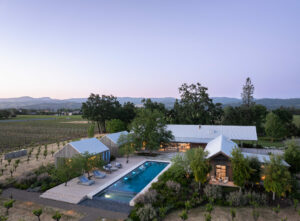
Situated on 18 acres in the St. Helena AVA, the farmhouse-style home features modern design along with a Cabernet and Zinfandel vineyard.
The post St. Helena Farmhouse Blends Rustic Charm With Wine Country Luxury appeared first on Sonoma Magazine.
]]>
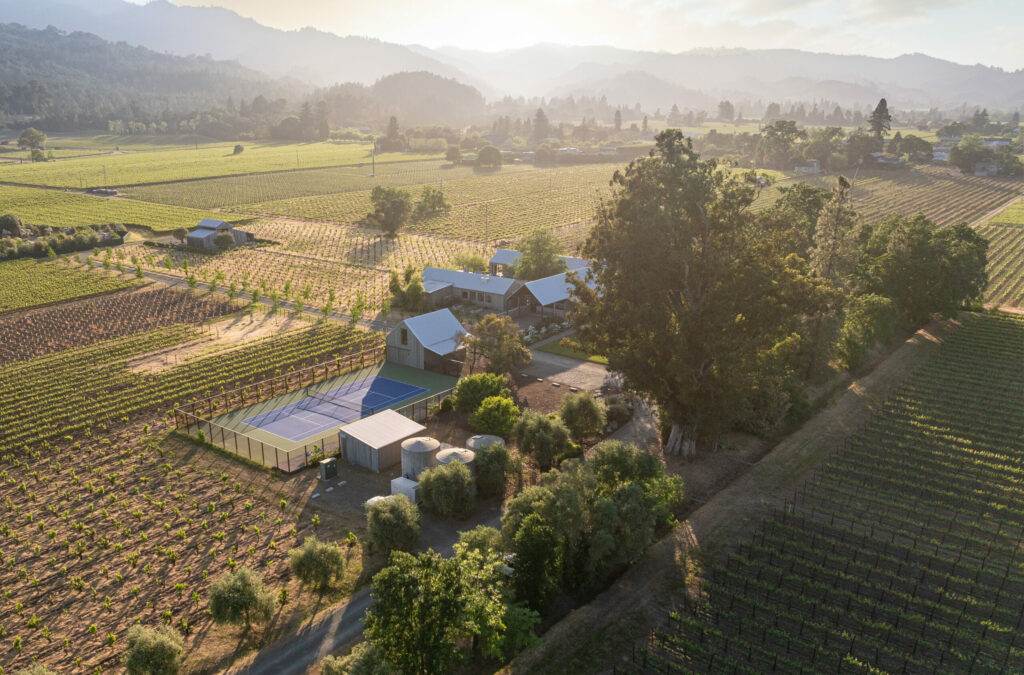
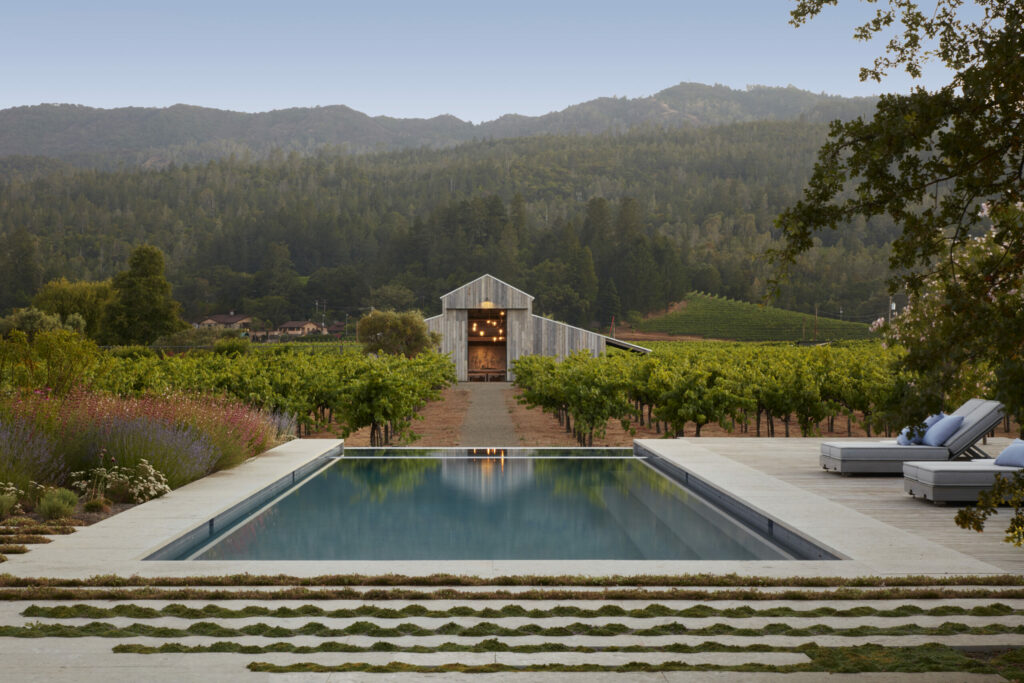
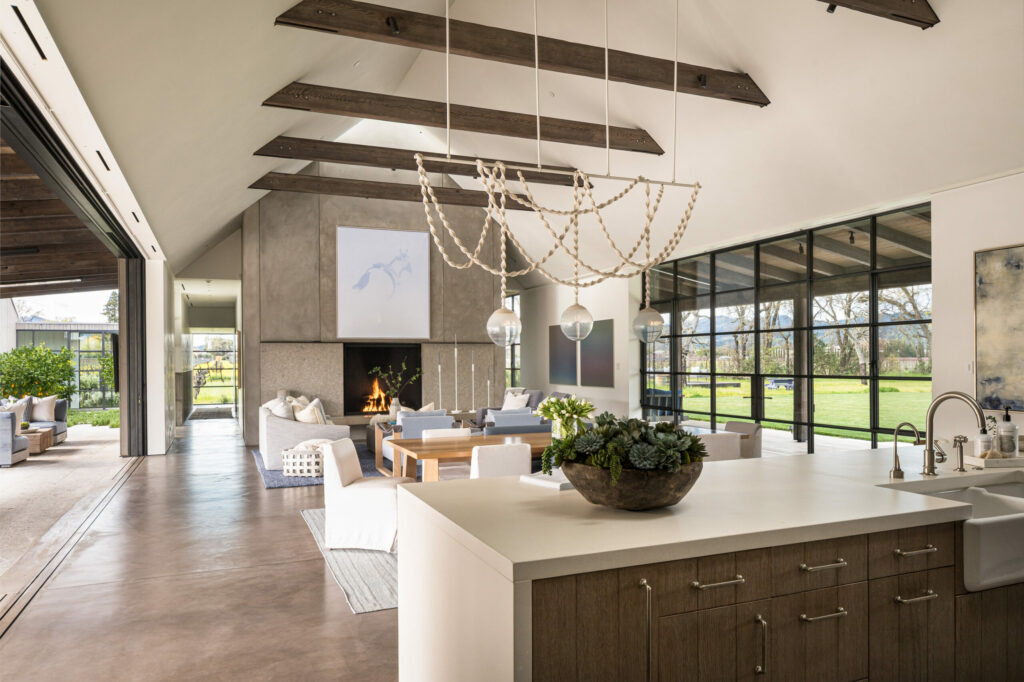

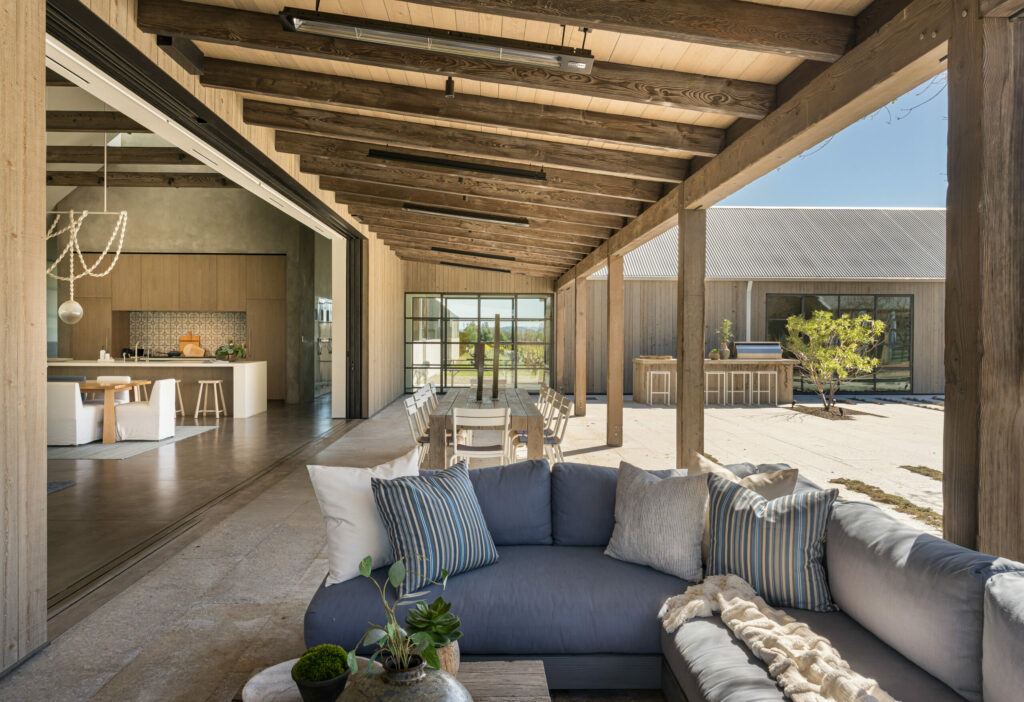
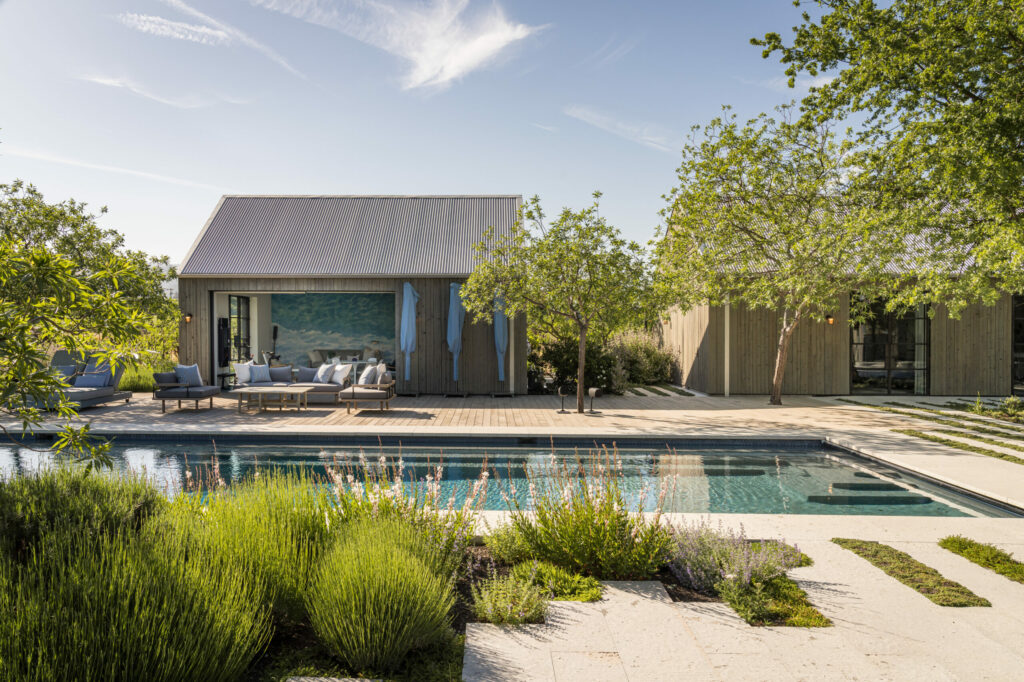
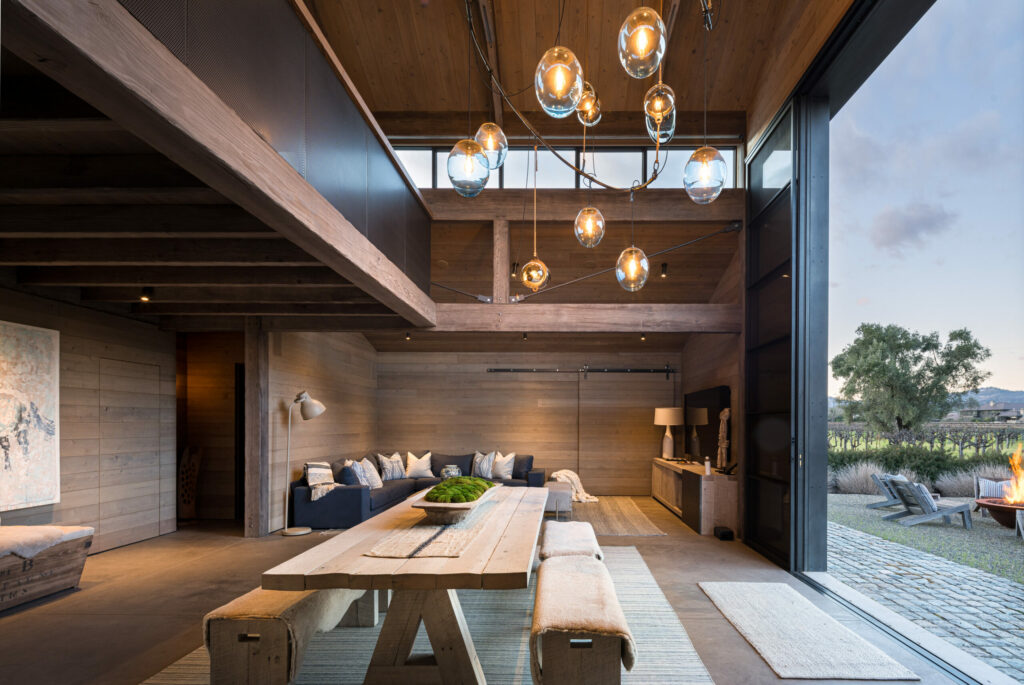
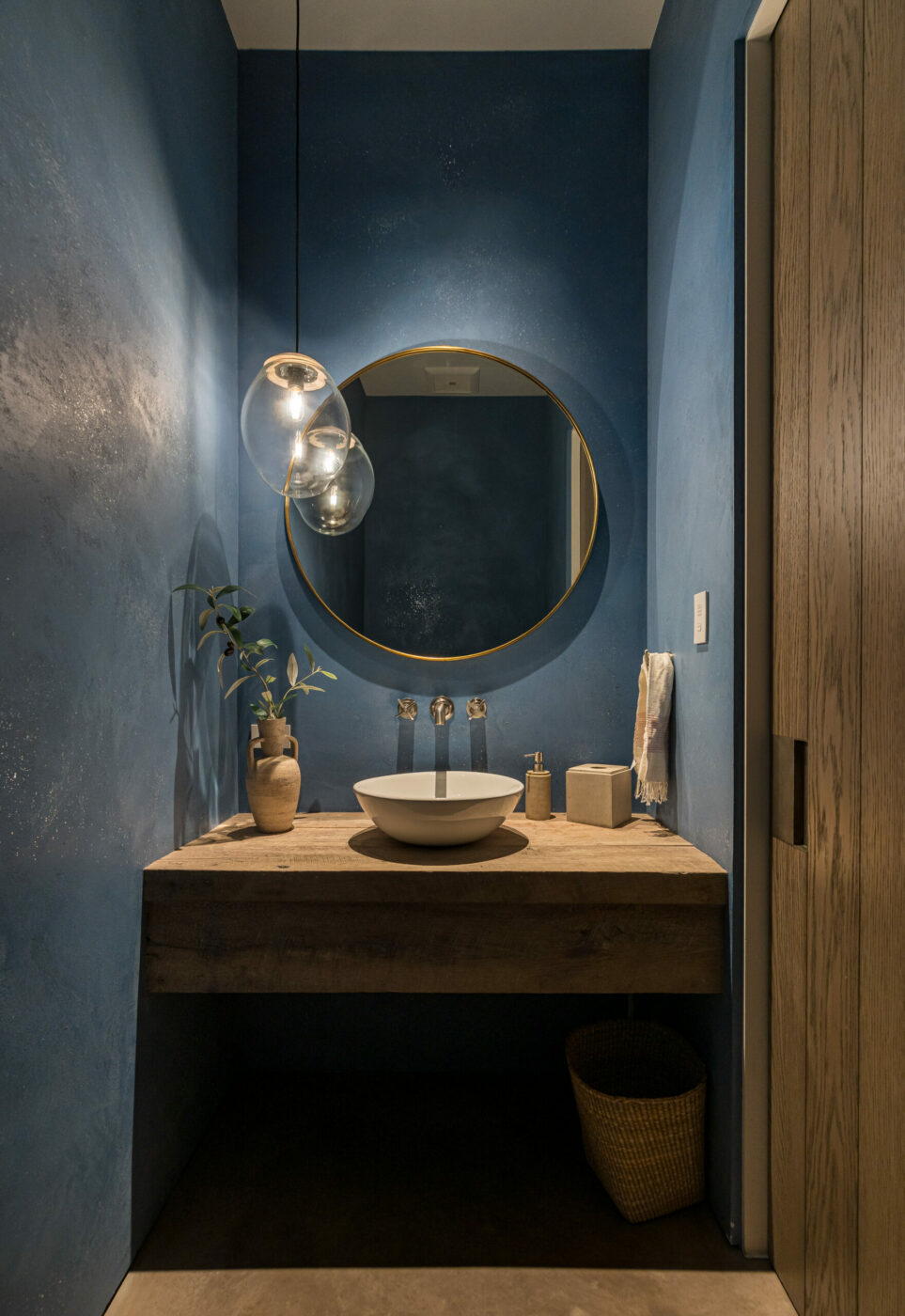

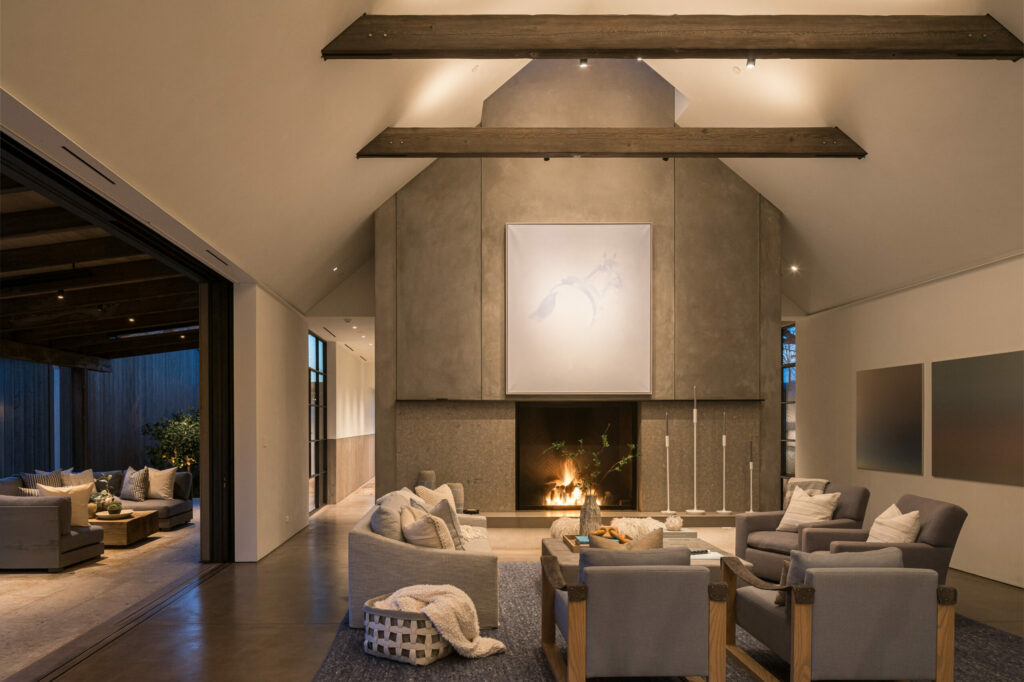

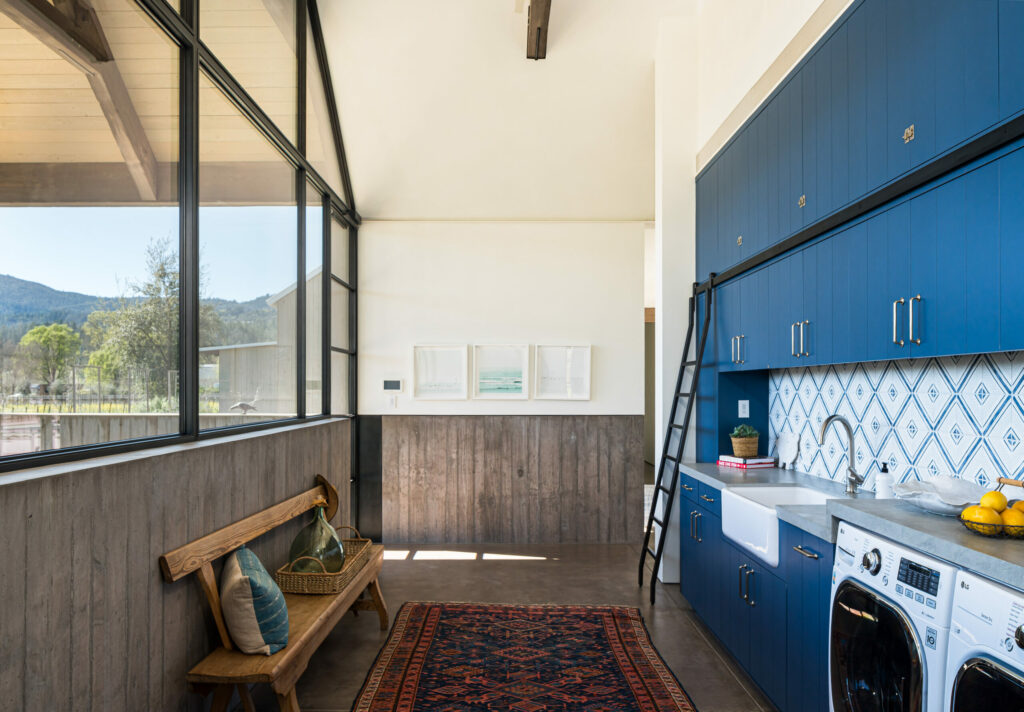
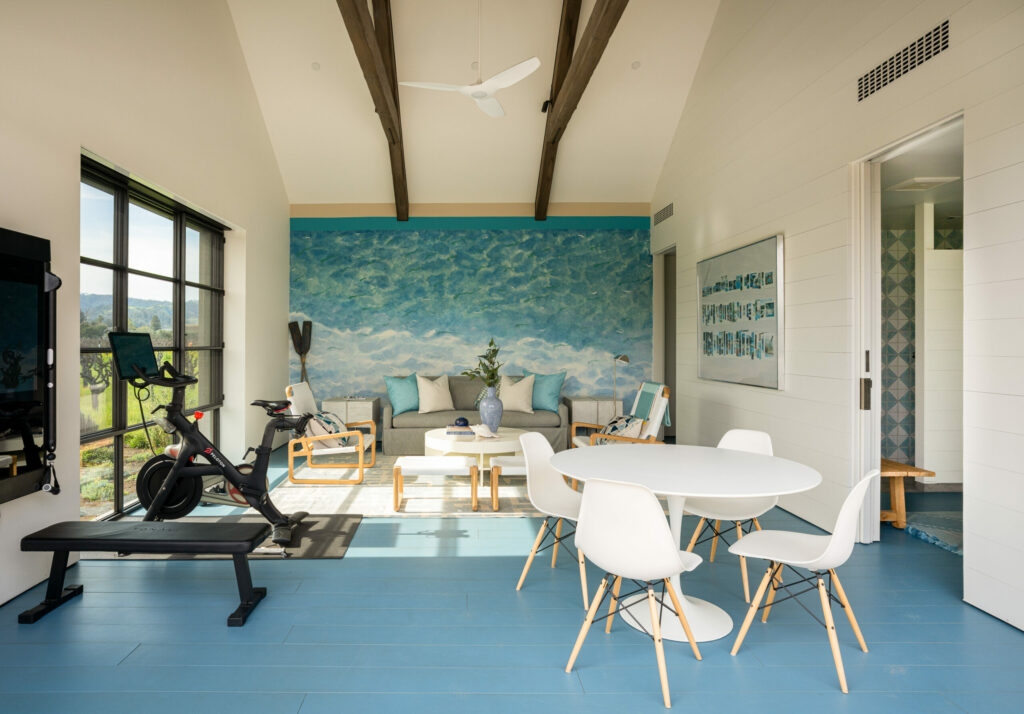
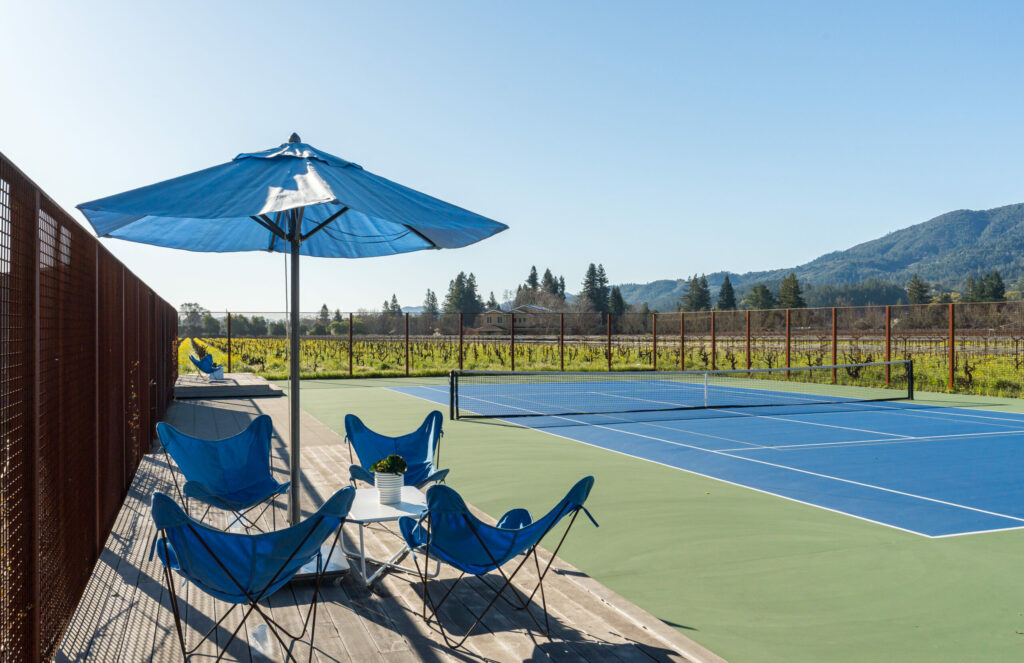


A modern, farmhouse-style estate on 18 acres in the St. Helena AVA of Napa Valley is up for sale. The five-bedroom, seven-and-a-half bathroom home with a barn and pool house is currently listed for $21 million.
The 7,484-square-foot dwelling constructed by Field Architecture and Grassi & Associates is made up of multiple structures — each with a steeply sloped corrugated roof — situated in a U-shape around the terrace and pool. Reclaimed coral board vertical siding blends with surrounding soil.
Interiors by Shawback Design offer a gentle luxury, letting the quality of the finishes do most of the talking: white oak cabinets, plaster walls, polished concrete floors and hand-blown chandeliers.



A few spots of vivid color add energy, such as the deep blue on a powder room wall, bathroom tile, laundry room cabinetry and various textiles. The cool hue is a nice counterpoint to the earthy palette, and it continues outside via the shade umbrellas, chairs and tennis court turf.
The pool’s surround of concrete has rectilinear cutouts for patches of lush vegetation. Meticulous landscaping and garden design is the work of Surfacedesign. This geometry is a good match for all those rows of the property’s Cabernet Sauvignon and heritage Zinfandel vines — some of which date back to 1935 and 1979.
For more information on this property at 1540 West Zinfandel Lane in St. Helena, contact listing agent Cyd Greer, 707-322-6825, Coldwell Banker Brokers of the Valley, 1775 Lincoln Ave., Napa, cydgreer.com/listing/modern-farmhouse-napa-valley-2/
The post St. Helena Farmhouse Blends Rustic Charm With Wine Country Luxury appeared first on Sonoma Magazine.
]]>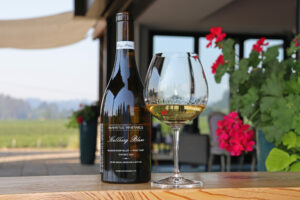
With a long career as a key varietal in the making of Champagne, Pinot Noir is no stranger to being stripped of its purple skin. But what happens if the juice isn't filled with fizz?
The post White Pinot Noir Is the Latest Trend in Wine Country. Here’s What You Need to Know appeared first on Sonoma Magazine.
]]>
















With a long career as a key varietal in the making of Champagne, Pinot Noir is no stranger to being stripped of its purple skin. The grape’s interior green flesh is traditionally pressed, fermented, and bubbled into one of the world’s most celebratory beverages.
But what would happen if the juice wasn’t filled with fizz? The answer is white Pinot Noir—a crisp, white oxymoron in a glass.
When red grapes are crushed, the heavily pigmented skins can be separated immediately from the pale juice to make a white wine. If the juice was left to briefly comingle with its skins, you’d have a rosé, and if left to fully macerate on the skins, you’d have a traditional Pinot Noir.
Because the grapes for a white Pinot Noir are generally picked earlier than they’d be if making a red wine, white Pinot Noir has a refreshing acidity that works well with many foods.
Winemaker Shalini Sekhar of Waits-Mast winery likes to capture the bright freshness of the wine by fermenting and aging it in stainless steel. She finds the intertwining aromas of fresh citrus and distinct red cherries to be intriguing.
“There is a hint of red fruit that stands out, even though it’s a white wine,” Sekhar said. “White Pinot Noir may seem like an intellectual exercise, but it makes some damn delicious wine.”
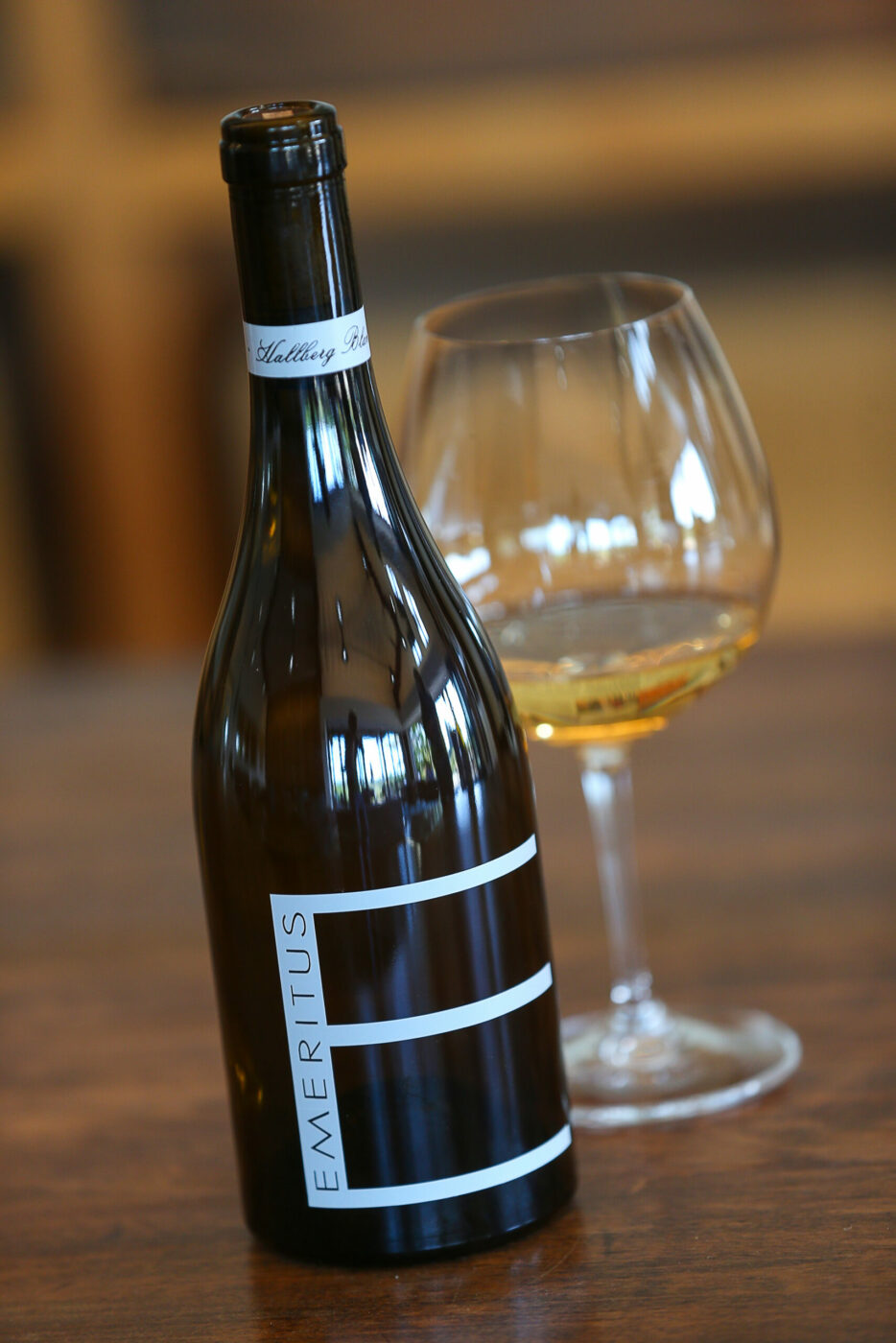
Mari Jones, president of Emeritus Vineyards in Sebastopol, a longtime producer of well-regarded traditional Pinot Noir, had to convince her father, Chardonnay pioneer Brice Cutrer Jones, that a project with white Pinot was worth trying. “He’s always felt that all our wines should offer the best, highest expression of our vineyards, and he didn’t think a white Pinot Noir could do that,” explains Jones.
But during the 2017 harvest, her team came across some fruit they thought could make a delicious white. That first try was a success, and Jones has since released several other vintages. “The wine has all these things you would never associate with red Pinot Noir, like tropical flowers, white fruits and peach blossom,” she says. “It’s a serious wine that’s complex and interesting, but it’s also easy to drink.”
Sekhar agrees. “You can make a white wine from other red grapes, but I don’t think you get the same sense of it being a complete wine,” she says. “Pinot Noir is so expressive, so it’s not surprising that a white wine made with the grape would be equally so.”
Four White Pinots to Try
Emeritus Vineyards, 2022 Hallberg Ranch Blanc, Russian River Valley, $44: Crafted from nine Pinot Noir clones at Hallberg Ranch, this white Pinot Noir envelops the palate in layers of white peach, white strawberry, and lemon curd. On the long finish are notes of corn silk and ginger candy. Serve cool, not cold. emeritusvineyards.com
Maggy Hawk, 2022 White Pinot Noir, Anderson Valley, $60: Aromas of Rainier cherry, sea salt, and Bartlett pear precede a bright acidity that runs through the center of the palate. Flavors of apricot, lemongrass, and grapefruit rind lead to a long, lingering finish. maggyhawk.com
Waits-Mast, 2022 Pinot Noir Blanc, Filigreen Farm, Anderson Valley, $42: Pale gold in color with aromas of Meyer lemon and white nectarine and a hint of cumin. The structured, slightly fleshy palate offers mandarin orange pith and citrus fruit with electric acidity. waitsmast.com
Schug Estate Winery, 2022 White Pinot Noir, Carneros, $46: Barrel-fermented and aged sur lie for five months in neutral French oak. Flavors of stone fruit, honeysuckle, wild strawberries, and white peach followed by exotic notes of quince, kiwi, and orange zest. schugwinery.com
The post White Pinot Noir Is the Latest Trend in Wine Country. Here’s What You Need to Know appeared first on Sonoma Magazine.
]]>
Stephanie Lee is the founder of a fast-growing skin care brand touted in national magazines. She’s also well acquainted with the down-to-earth vibe of Sonoma's west county.
The post Local Skin Care Entrepreneur, Featured in Cosmopolitan, Shares Favorite Sonoma County Spots appeared first on Sonoma Magazine.
]]>
















Though Occidental’s Stephanie Lee is the founder of a fast-growing skin care brand touted in Forbes and Cosmopolitan, she’s also well acquainted with the down-to-earth vibe of rural west county, where she and her husband are fixing up a house in the redwoods. “I got my first chainsaw for Christmas,” laughs Lee as she details the many wonders of Occidental’s old-timey hardware store.
Lee has always been a bit of an overachiever. Shortly after college, she rocketed to the White House as a member of the staff of first lady Michelle Obama, and later built a career in product development at a big-name cosmetics company in New York. But after navigating a mental health crisis, Lee left the city to travel the world for a year and recalibrate her goals, visiting 11 countries and 16 states.
She launched her business, Selfmade, (beselfmade.co) in 2020 to connect skin care products to current research into emotional well-being and resiliency. Living in Sonoma has been a boon to her creativity, as she and her husband build even deeper ties within their community.
Here are some of Stephanie Lee’s favorite Sonoma County spots:
“I go to Negri’s every single Friday. It feels like Cheers—like, hi guys,” says Lee. She usually has fettuccine with chicken and always, always orders Sandy Negri’s housemade cheesecake. “I like to think of myself as pretty much a professional dessert-taster now!” 3700 Bohemian Hwy., Occidental. 707-874-0301, negrisrestaurant.com
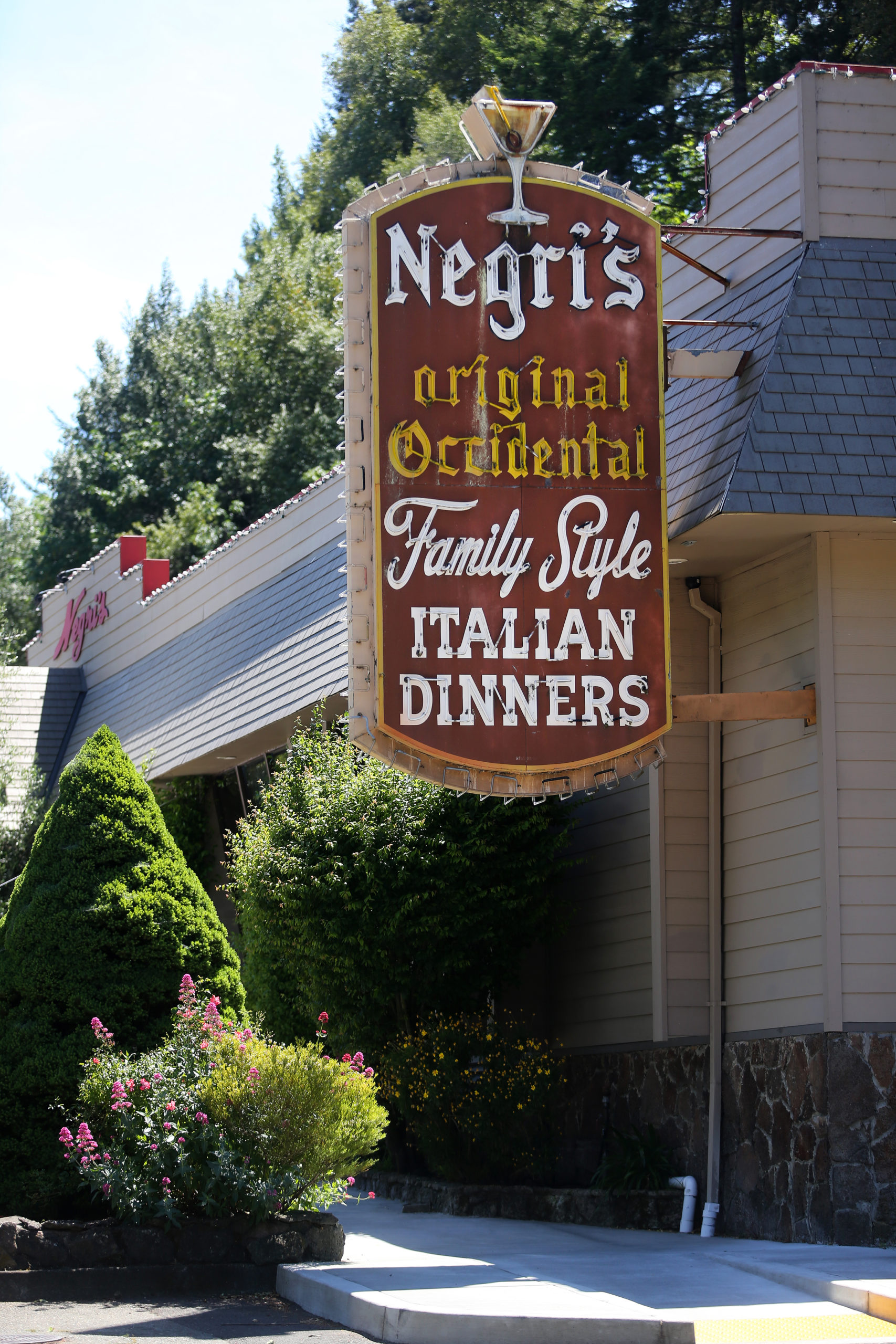

Lee and her husband both volunteer at the nonprofit Occidental Center for the Arts. The center’s iconic Fool’s Parade will march through town every April. 3850 Doris Murphy Ct., Occidental. occidentalcenterforthearts.org
Lee and her husband have two dogs, so the nearby Grove of Old Trees is a favorite spot. “It’s very magical— the fact that the trees talk to each other underground and grow in fairy circles. It’s a reflective experience.” 17599 Fitzpatrick Lane, Occidental. landpaths.org
Lee first hit up Café Aquatica for a smoked salmon bagel when she and her husband were scouting the area before their move from New York. “There’s always someone singing on the stage, and there’s the river and the ocean beyond—beautiful.” 10439 Hwy. 1, Jenner. 707-865-2251, cafeaquaticajenner.com
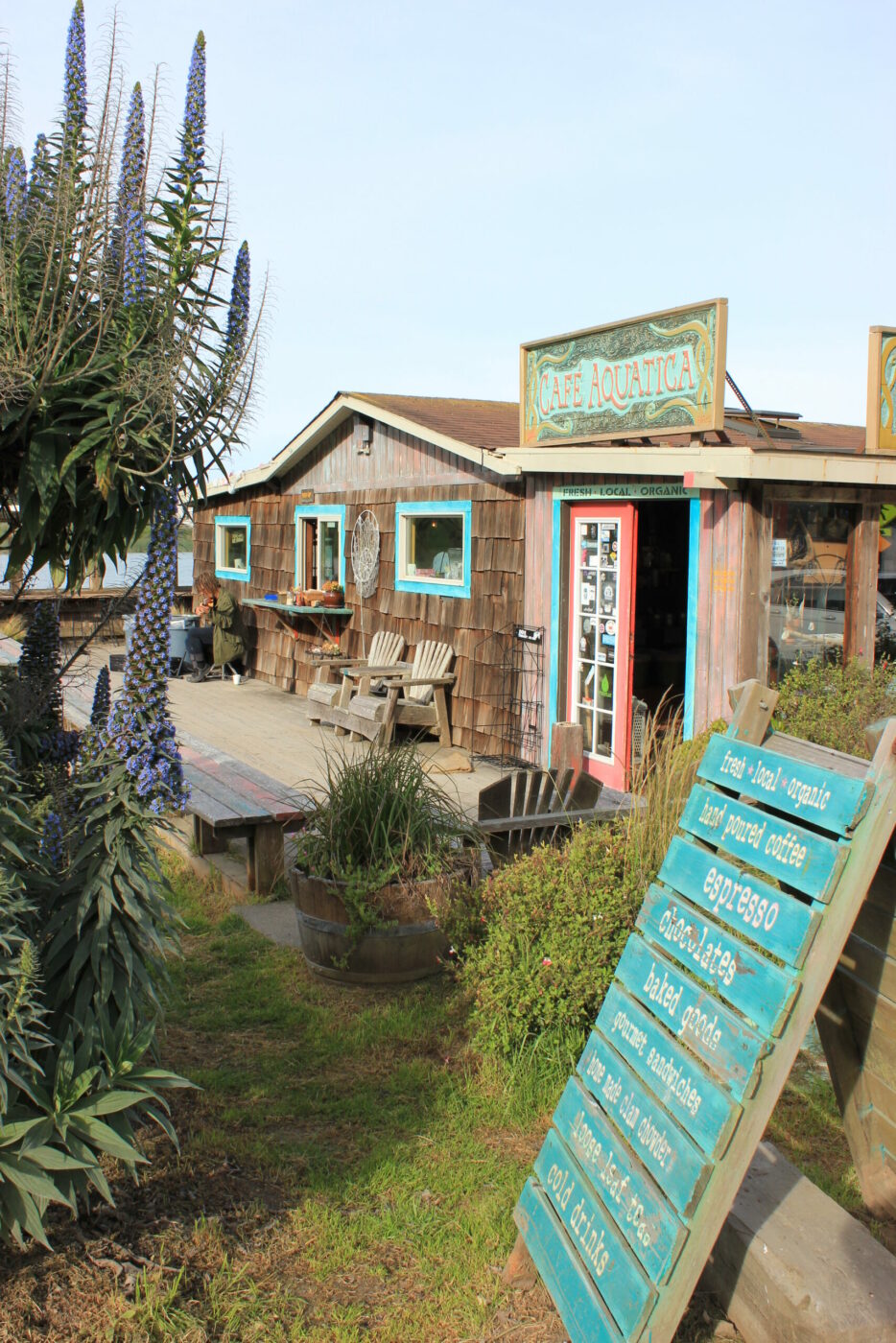
On her zippy Vespa scooter, Lee loves two classic Sonoma spring drives. First, taking the back roads from Occidental through Graton to Healdsburg (Laguna Road to Trenton-Healdsburg Road to Eastside Road) past rolling vineyards and oak trees leafing out. And also, on the way out to the coast, she loves the green hills from Valley Ford to Dillon Beach. “I always take my family on this drive when they visit. It’s like what it would look like a hundred years ago.”
The post Local Skin Care Entrepreneur, Featured in Cosmopolitan, Shares Favorite Sonoma County Spots appeared first on Sonoma Magazine.
]]>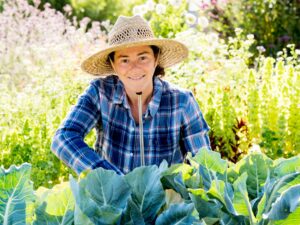
Professional gardener Rachel Kohn Obut shares tips for starting a vegetable garden and growing your own food.
The post A Beginner’s Guide to Starting a Vegetable Garden in Sonoma appeared first on Sonoma Magazine.
]]>
















Looking to start a vegetable garden in Sonoma? Get insider tips from a professional gardener and learn how to grow your own food.
Professional gardener Rachel Kohn Obut loves vegetables, fruit trees, flowers, native species— anything that brings nourishment and beauty. She loves plants, and she understands them, too. She has studied permaculture and landscape design and served as farm manager at both Sweetwater Spectrum in Sonoma and Flatbed Farm in Glen Ellen. From 2018 to 2023, she ran her own vegetable and flower farm on a leased acre of land in Napa.
Today, Obut blends her agricultural and design backgrounds with her interest in native ecosystems to consult on edible gardens and residential landscapes in both Napa and Sonoma (littlemoonfarmnapa.com). She also runs her own backyard farm, selling cut flowers and veggie starts, including ‘Mara des Bois’ strawberries (her all-time favorite), ‘Jimmy Nardello’ sweet peppers, and the alluring ‘Piracicaba’ sprouting broccoli.
“There’s always more to learn in gardening,” Obut says. “I think the most exciting part is trying new varieties of vegetables and finding new ones that do well.”
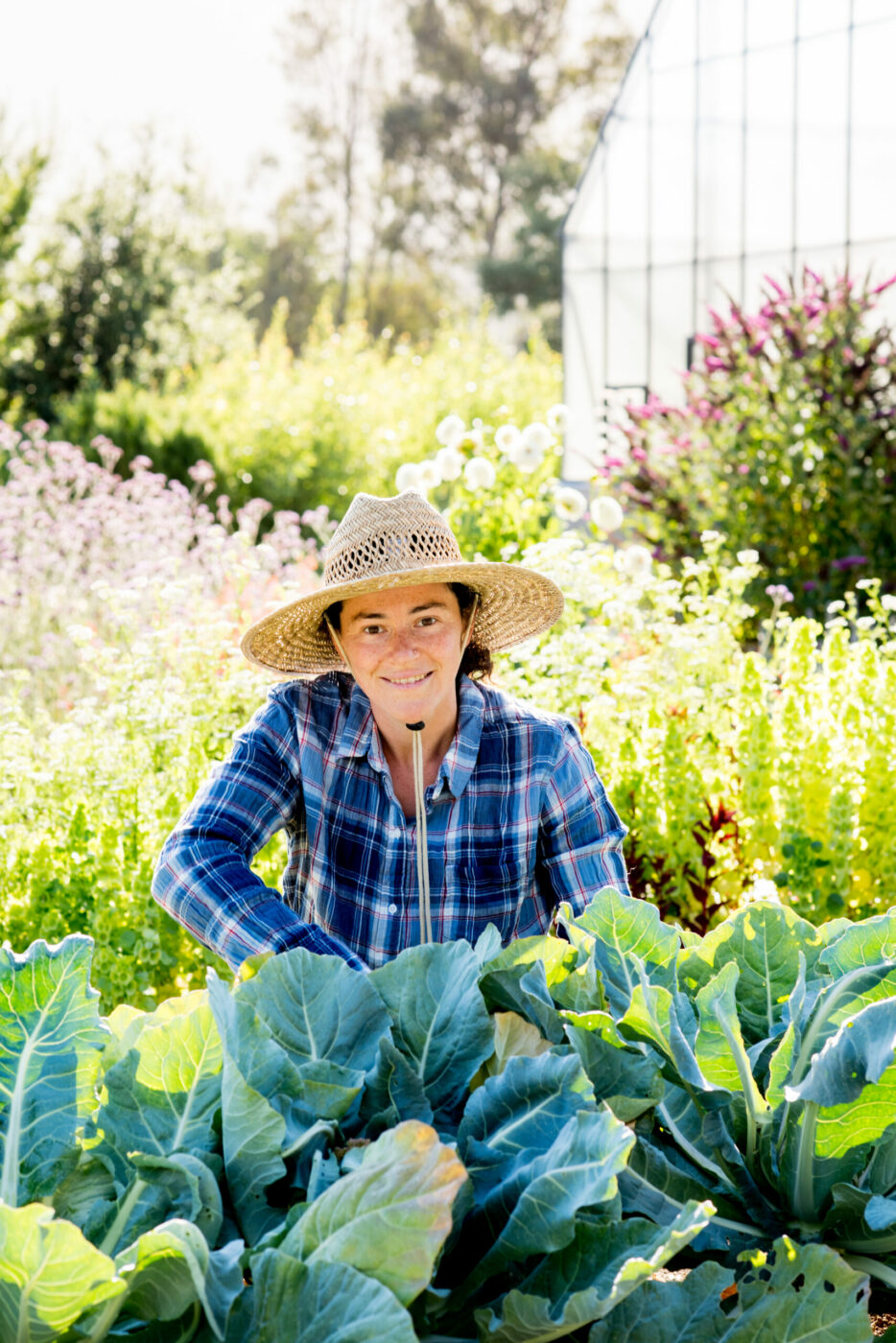
Rachel Kohn Obut’s tips for starting a vegetable garden in Sonoma:
Envisioning your garden
The spring is just really fun for visioning and planning. What do you want to do with your garden space? It’s the most exciting time of year for me. Once the danger of frost has passed, which is usually by mid-April—though the last few years we’ve sometimes had some later frost in parts of Sonoma County—and up until mid-May is the optimal time to be putting all kinds of plants in the ground.
Summer crops
Tomatoes, summer squash, basil, and cucumbers are the easiest ones to get started with. Varieties that do well in Sonoma Valley will be different from those that do well near the coast. For example, with tomatoes, if you’re in a cooler climate, cherry tomatoes will ripen faster and be more successful, whereas if you’re in Sonoma Valley or Healdsburg, you’ll have better success with all the heirlooms. ‘Copia’ tomatoes are an open-pollinated variety named for Copia in Napa, where I now consult, that has been one of my favorites for a long time.
View this post on Instagram
Startup basics
I think having a drip irrigation setup is really useful. Hand watering is hard to do. Apply the best compost that you can, and supply a balanced vegetable fertilizer yearly. If you start to see your crops not doing as well from year to year, it could be a fertility imbalance occurring over time that can be easily corrected, or it could also be a soil-borne fungal disease. To identify the problem, get a soil test.
Relishing home-grown food
My enjoyment of food and eating and cooking definitely got me into farming in the first place, and has kept me farming. Food is a basic need, and growing vegetables feels like a really wholesome way to connect with the community. Having your own home garden can help you tap into that. Plus, food that’s super fresh and grown from your own garden is healthier and tastes better and can inspire your cooking.
The post A Beginner’s Guide to Starting a Vegetable Garden in Sonoma appeared first on Sonoma Magazine.
]]>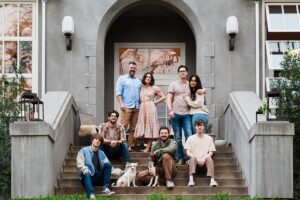
"Not for the faint of heart," said the real estate listing for the 150-year-old former Green Valley schoolhouse. A couple took on the challenge to create a home for their family of five boys.
The post A Family of Seven Turns an Old Sonoma Schoolhouse Into a Gorgeous Home appeared first on Sonoma Magazine.
]]>
















“Not for the faint of heart,” was the line in the real estate listing that caught the eye of designer Eva Kunkle. She and her husband, Aaron, are childhood sweethearts who each come from families that worked in the building trades—so they were used to a good project. But this particular undertaking would need everything the couple and their five sons had to give.
The year was 2013, and the listing was for the nearly 150-year-old former Green Valley schoolhouse, located a few minutes outside the town of Graton. It had stopped operating as a school in 1962, and since then had been used as a childcare center, a polling location, a church—and more recently, a training center for Graton Fire Department.
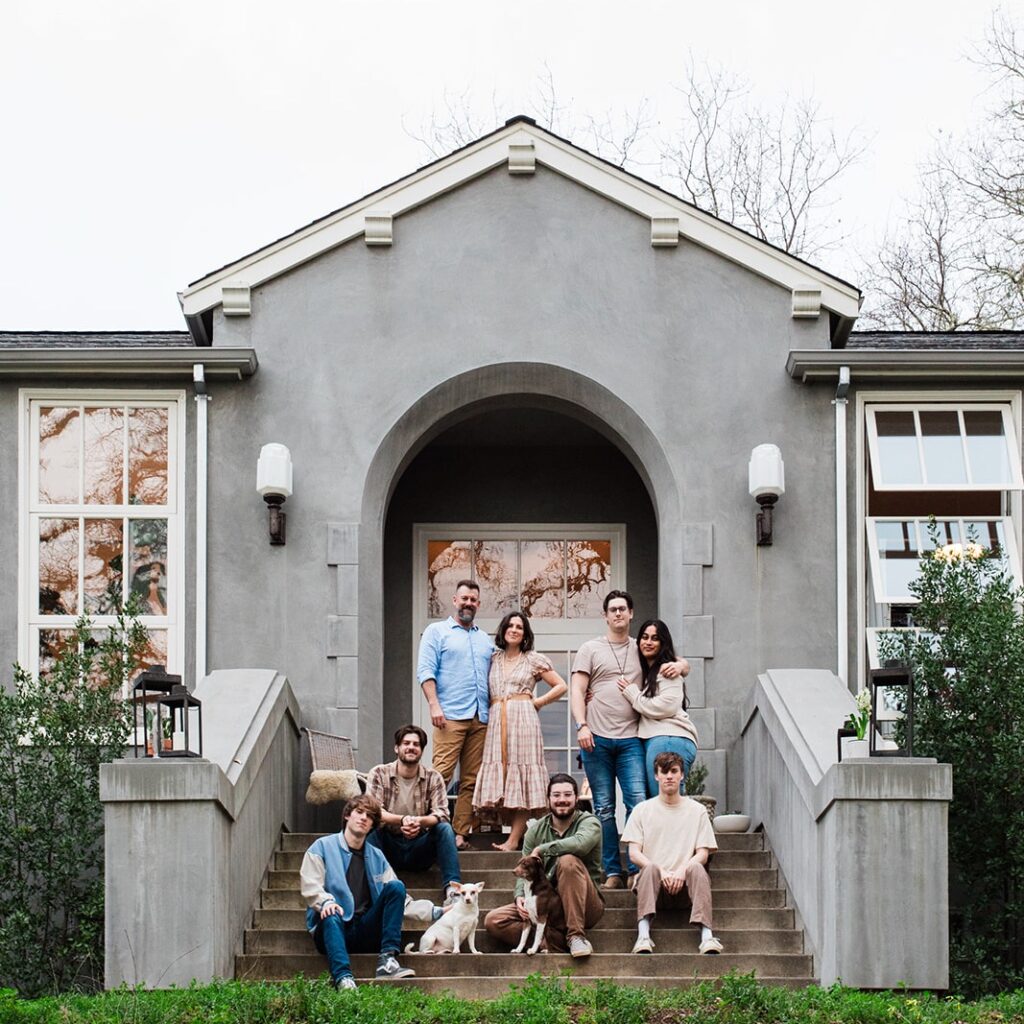
After several decades without permanent tenants, the building was in rough shape.
“The windows were all blacked out from the fire department training, and you could see the sky through holes in the ceiling,” Eva recalls. “And the hill in back had sloped and sloped until it essentially buried the whole back of the school.”
The couple wrote the fire department’s board of directors a letter, explaining the connection they felt to the building, and how the schoolhouse seemed like the place they should be raising their family of five boys, ages 7 to 12 at the time.
“It felt like this place was a part of our family, that it was meant to be—the building of boys, and the building of a family,” says Eva.
And the board voted to sell the building to them.
Renovations took several years. Eva and Aaron did most of the work themselves, while the boys adventured around the property and gave tours to the many locals who stopped in to see what was going on at the old schoolhouse.
“It was a wild and crazy time,” laughs Eva. “We would be here all day, and the kids would run around and play. We had a big tent set up in back with Legos and a queen-size bed and a Persian rug. We would just work, and then we’d barbecue dinner on the grill outside and go back to our rental and throw the five boys into the tub. Line them up, scrub them down.”
“They loved it,” says Aaron. “They thought it was funny. They thought they were cars, going through the car wash.”
The couple say that they focused all their intentions on knowing that while the work was tough, it was also a special time with their boys that they’d never get back.
“I couldn’t do it again, ’cause I’m in a different season,” says Eva. “But at the time, it really did create this idea of, like, life doesn’t have to be this perfect 72-degree situation. You can be creative with the way you live, and be resilient, and do hard things to create a future.”
That future is now evident in the many details and memories contained in the schoolhouse. The building still retains traces of its former life, albeit adapted to the needs of a large family.
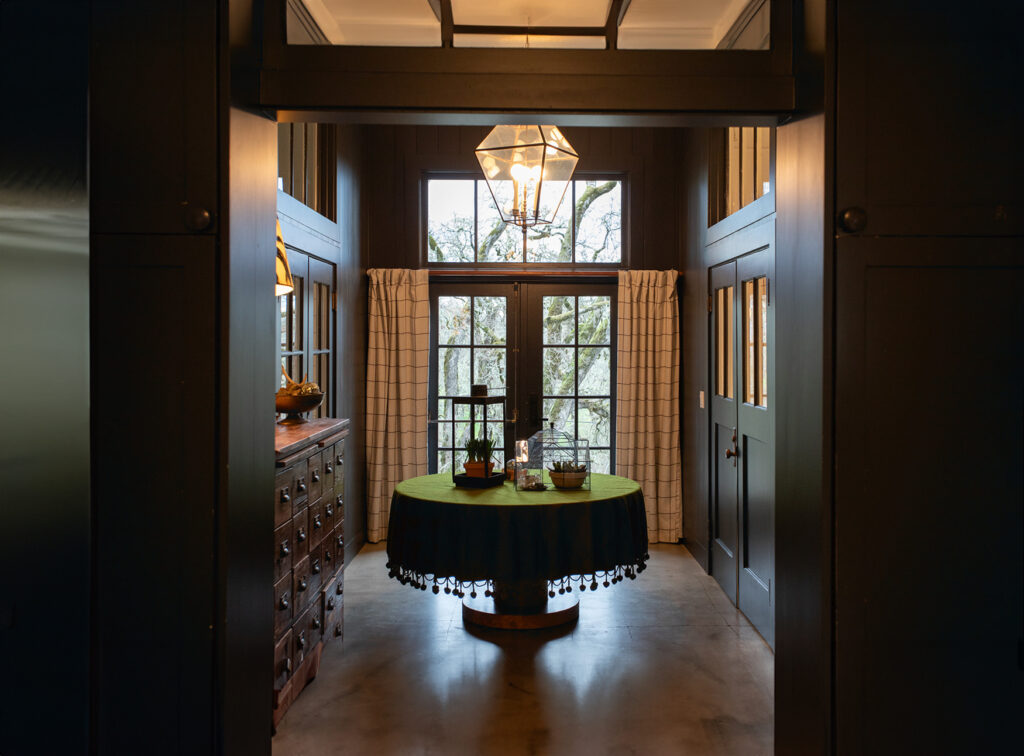
One enters the schoolhouse up a set of new front steps, through the original schoolhouse door, and into a center hallway. Off that hallway, there were originally two large classrooms, one to the left and one to the right, with a big washroom and the principal’s office in the back. Eva and Aaron remade the fifth through eighth grade classroom on the left into a large family room, with the school’s raised stage as their dining room and a kitchen and pantry built into the former cloakroom along the back wall.
Across the hall, the former kindergarten through fourth grade classroom is now a dormitory, with six cubby-style beds built into the back wall and big tables and couches for the boys, now 18 to 23 years old. The boys share a bathroom with the original vintage trough-style schoolhouse sink. And Eva and Aaron turned the principal’s office into a portion of a new primary suite, with an added-on bedroom that looks out to the backyard through French doors rescued from a salvage yard.
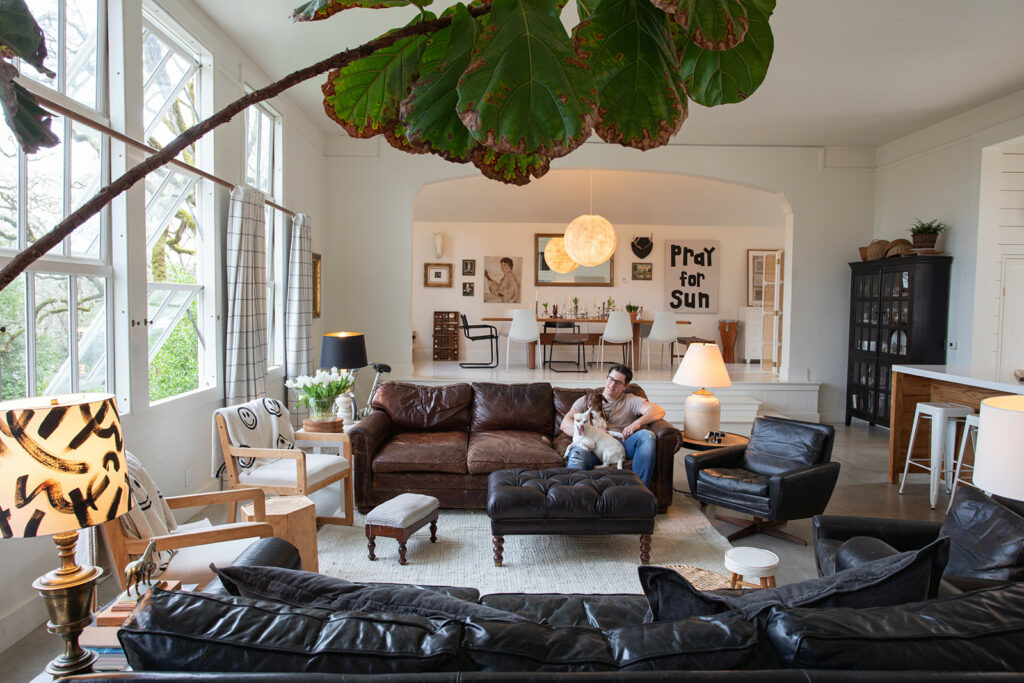

In the bright family room, the couple painstakingly restored the unique outswing windows, scraping off years of paint, putting in new glass, and reworking the original mechanisms inside. Eva spent months standing on scaffolding to spackle and sand the original ceiling plaster, which she was determined to save. Now, sitting in the family room, with its 12-foot ceilings and broad banks of restored windows, is almost like being outdoors.
“It feels special all the time. Imagine all the leaves bright green in spring, and it’s like you are in a tree house, the most beautiful tree house,” says Eva. “Watching the light play around with the shadows and the oak trees and the sun in the morning, it’s just beautiful.”
“The sun comes up, and this house is literally like a catcher’s mitt, catching all the light,” says Aaron. “It’s unbelievable; it just glows.”
The green of the oaks in spring is intense, and the front yard is filled with wild onions that bloom like little white bells. Eva likes to leave the onion flowers to grow as late as she can. Eventually the other wild grasses around them get so tall that the yard must be mowed, and then “the whole property smells like onions for like three days,” she laughs.
The rooms have a layered and authentic sense of history, filled with simple, natural pieces and gorgeous textures. Eva, who designs and styles interiors professionally, found nearly all of the furnishings at local thrift shops and secondhand stores.
“I really love to see the wood and concrete and metal. They’re honest materials. And I love patina and age—worn things that are made really well. That’s my style.”
The new kitchen cabinets were custom milled from reclaimed wood, and Eva chose brass pulls that echo the schoolhouse’s original hardware.
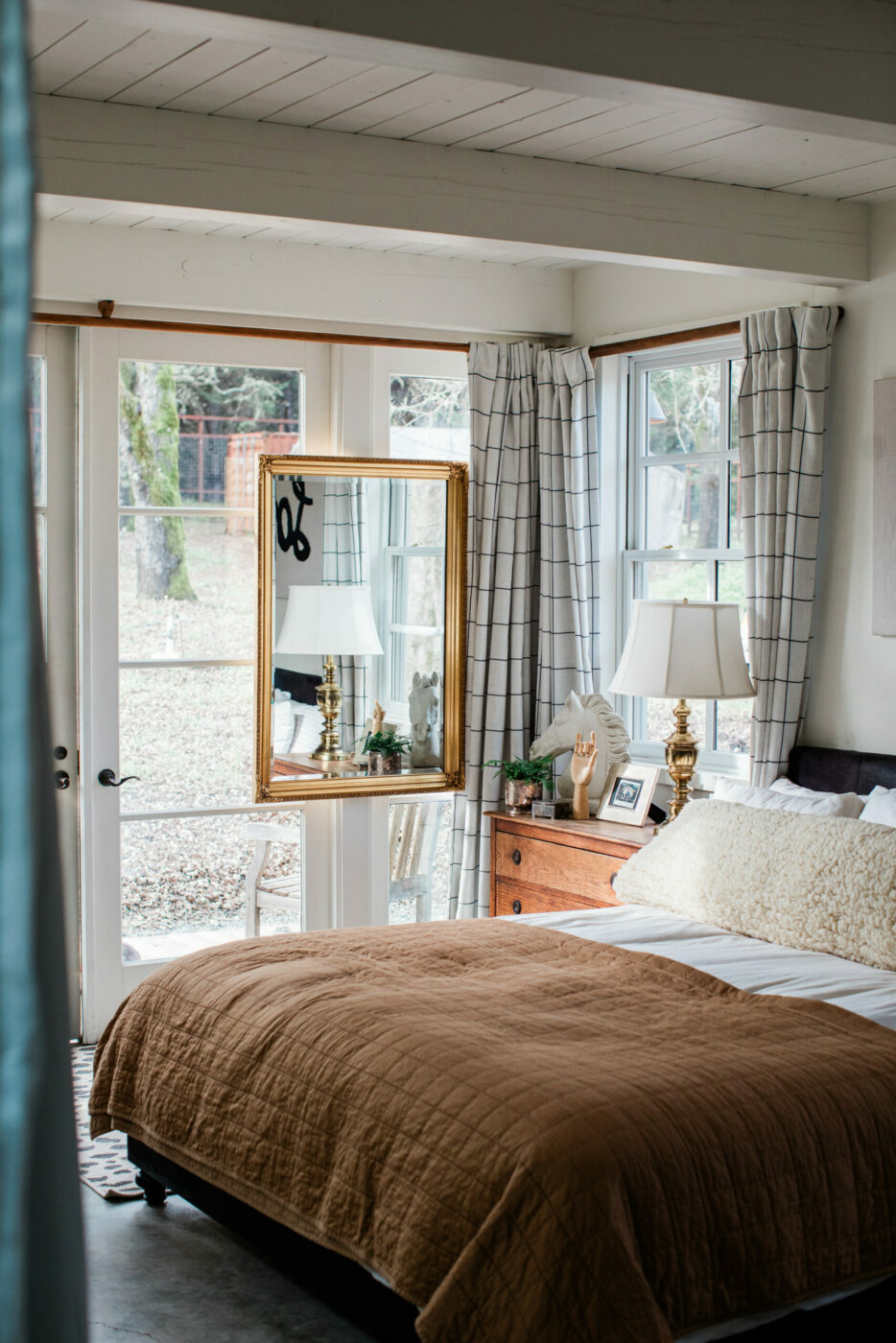

After the house was finished, the family used their restoration skills to help others in the community. Eva and Aaron got back into construction full-time, rebuilding family homes in Santa Rosa’s Coffey Park neighborhood after the Tubbs Fire.
“We had literally 16 projects pinned up on the wall of the dining room,” recalls Aaron. “It was, like, how could you sit here with a crew you’d just taught to build a house and not want to help.”
Moving forward, the couple say that they’re reaching a turning point, as the boys start to transition to more independent lives as young adults. There aren’t quite as many Nerf battles happening these days, as the daily rumble of a home filled with young boys starts to go down a notch.
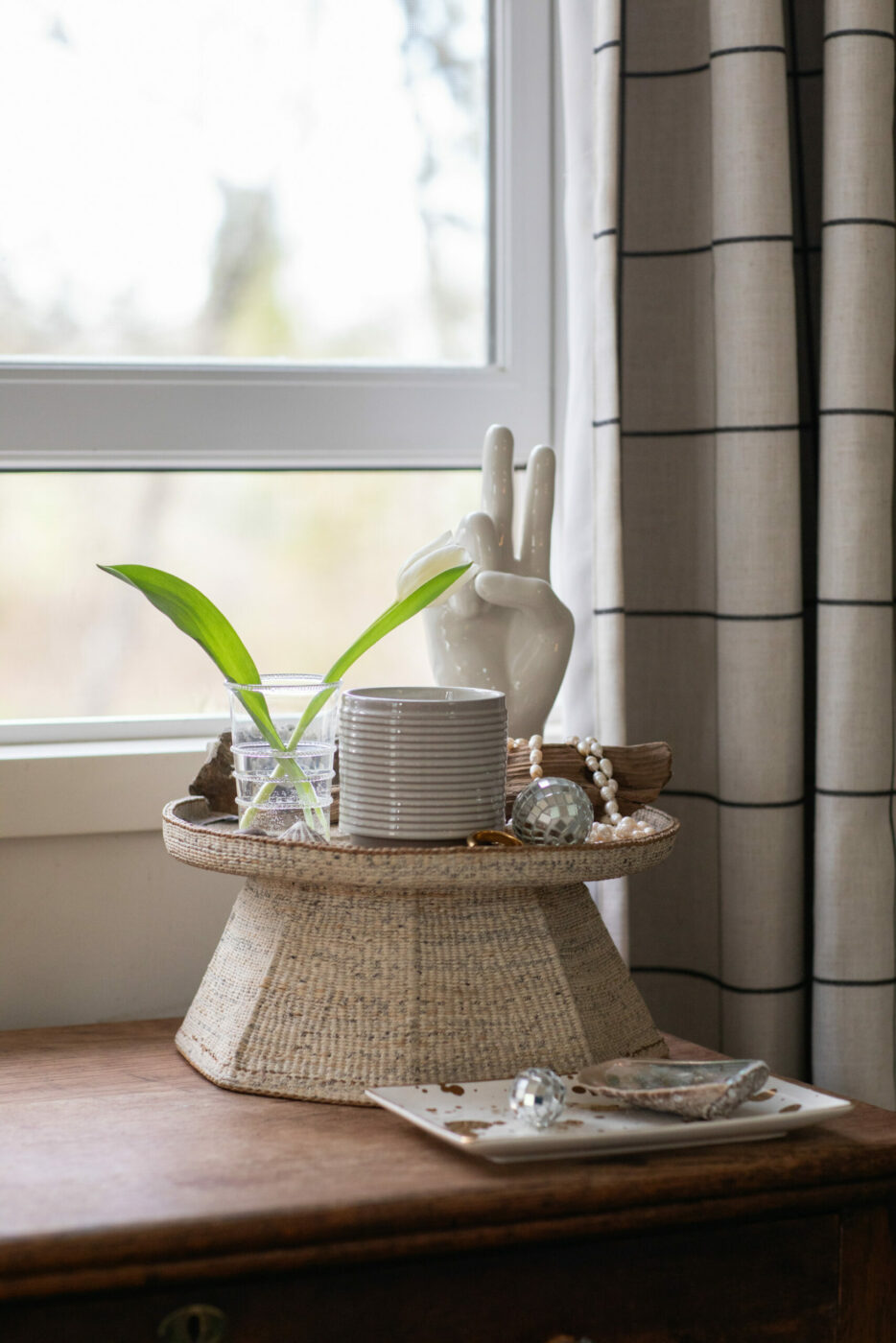
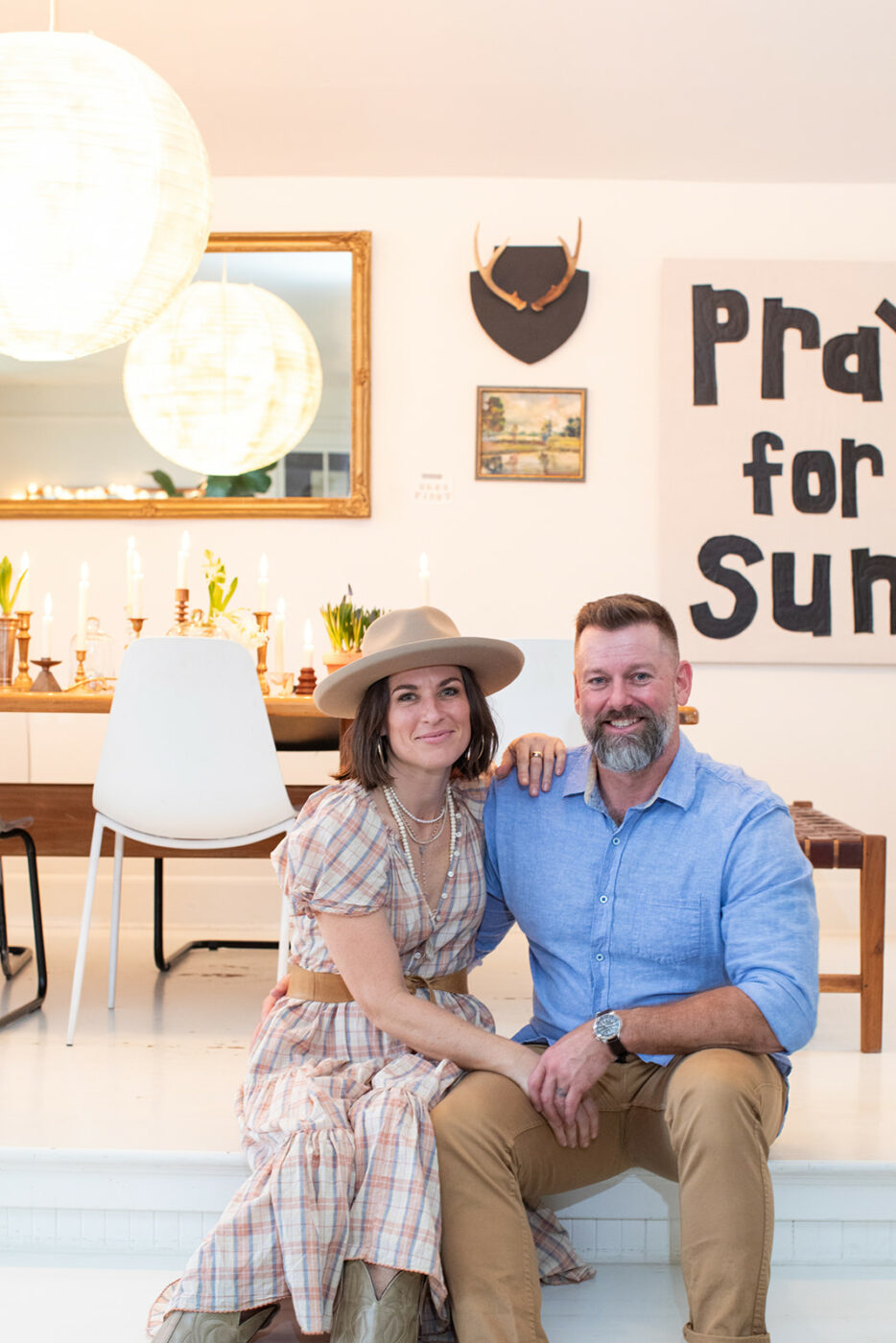
Eva and Aaron are launching a new design/ build business focusing on custom, finely detailed accessory dwelling units, or ADUs. ADUs, they explain, allow families to stay together and retain flexibility as their housing needs change—offering young adults an affordable place to live, or empty nesters a smaller home near their children. It’s a project that feels right to Eva and Aaron at this stage of their lives.
But the couple still remember fondly the all-encompassing early days of the renovation, and how they’d rope pairs of boys into giving neighbors a tour of the project.
“Now that we’re finished, we don’t get as many former students stopping in. But that was a sweet season… This is such an important piece of property, not just to us, but to the people who went to school here,” says Eva.
Looking back, Eva and Aaron say the schoolhouse restoration has connected their family to something larger than themselves—an entire community of locals who knew and loved the old building.
“And we weren’t just renovating a schoolhouse,” says Eva. “We were raising men.”
The post A Family of Seven Turns an Old Sonoma Schoolhouse Into a Gorgeous Home appeared first on Sonoma Magazine.
]]>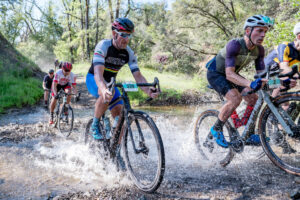
Local cycling standout Miguel Crawford has been getting folks together for gravel bike races since the late 90s. His homegrown Grasshopper Adventure Series draws some of the biggest names in the sport. So why are most of the races leaving Sonoma County?
The post Gravel Racing Was Happening in Sonoma Long Before It Became Cool. Now It’s Disappearing appeared first on Sonoma Magazine.
]]>
















Meet Miguel Crawford, husband, father, teacher, extreme velophile—dude has 15 bikes lined up neatly in his Sebastopol studio—and accidental pioneer.
It was 26 years ago that Crawford, a longtime Spanish instructor at El Molino, then Analy High School, organized his first Hopper. That’s the innocuous-sounding name for the merry sufferfests comprising the Grasshopper Adventure Series, which he founded with little to no fanfare back in 1998.
A slightly sadistic series of four to six “rideslash-races” taking place between January and summer, Crawford’s “Hoppers” have long put a premium on hard-won versatility, taking riders over pavement, dirt, gravel, distressed macadam, fire roads, old logging trails, single- track, you name it.
Ripping down Old Cazadero Road north of Guerneville, or grinding up Willow Creek outside Duncans Mills on a smorgasbord of different rigs—road bikes, mountain bikes, cyclocross bikes—those intrepid early Hopper racers didn’t look or feel especially cutting edge.
It turned out, however, that the multi-terrain adventures Crawford has been curating since the previous millennium preceded by at least a decade the rise of gravel riding and racing, a discipline that’s recently gained worldwide popularity. Grasshoppers were all about gravel—and the gravel ethos of fun and exploration— before gravel was cool.
“Gravel,” we are reminded by five-time Olympian and Hopper veteran Katerina Nash, is not to be taken too literally. That word has become shorthand, a catch-all for a mix of different terrains. A huge part of its appeal, says Nash, “is that it brings together all these athletes”— mountain bikers, roadies, members of the cyclocross tribe—“who wouldn’t otherwise meet.”
There are now hundreds of gravel racing events across the United States each year. Among the best known is Unbound Gravel, a 200-mile ordeal contested by 4,000 riders each June in the Flint Hills of Kansas. The Super Bowl of Gravel, as some refer to Unbound, has been won by several Hopper regulars, including Yuri Hauswald, Amity Rockwell, Alison Tetrick, and Ted King, who refers to the Grasshopper Series as the “OG”—the original gangster—of gravel. That tribute was validated in March of 2023 by the Gravel Cycling Hall of Fame, which included Crawford in its second class of inductees, along with Petalumans Hauswald and Tetrick—lending the Emporia, Kansas-based Hall of Fame a distinctly Sonoma flavor.
Decades before the bike industry began marketing gravel bikes, noted Crawford’s Hall of Fame presenter, Dan Hughes, “Mig and his friends were pushing their old road bikes to the limit, installing the largest tires the frames could handle and taking parts from early mountain bikes to create new frankenbikes that could handle the abuse of long mixed-terrain rides.”
The natural beauty of Crawford’s courses, coupled with the relaxed, low-fi vibe of the events, has earned the series a fiercely loyal following throughout Northern California and beyond. Hoppers tend to draw a mix of eager, über-fit amateurs and, at the pointy end of the peloton, a who’s who of pro riders, both mountain and road, seeking some hard miles to sharpen their fitness for the upcoming season.
It’s a mix that has led to some surreal moments. Crawford recalls Giro d’Italia stage winner Peter Stetina texting him from Europe to learn the results of certain Hoppers. “He’d be over in France, racing Paris–Nice or something, asking me who won Old Caz.”
But as word of the rides got out and the number of participants grew, so did attention from neighbors, including members of the Kashia Pomo rancheria. Some citizens complained to their elected officials, others to the California Coastal Commission. By 2022, the process of securing permits for Sonoma County events had become so onerous, even Kafkaesque, that Crawford made the tough, sad decision to move the bulk of the series to friendlier environs—ones outside the county where the races were born.
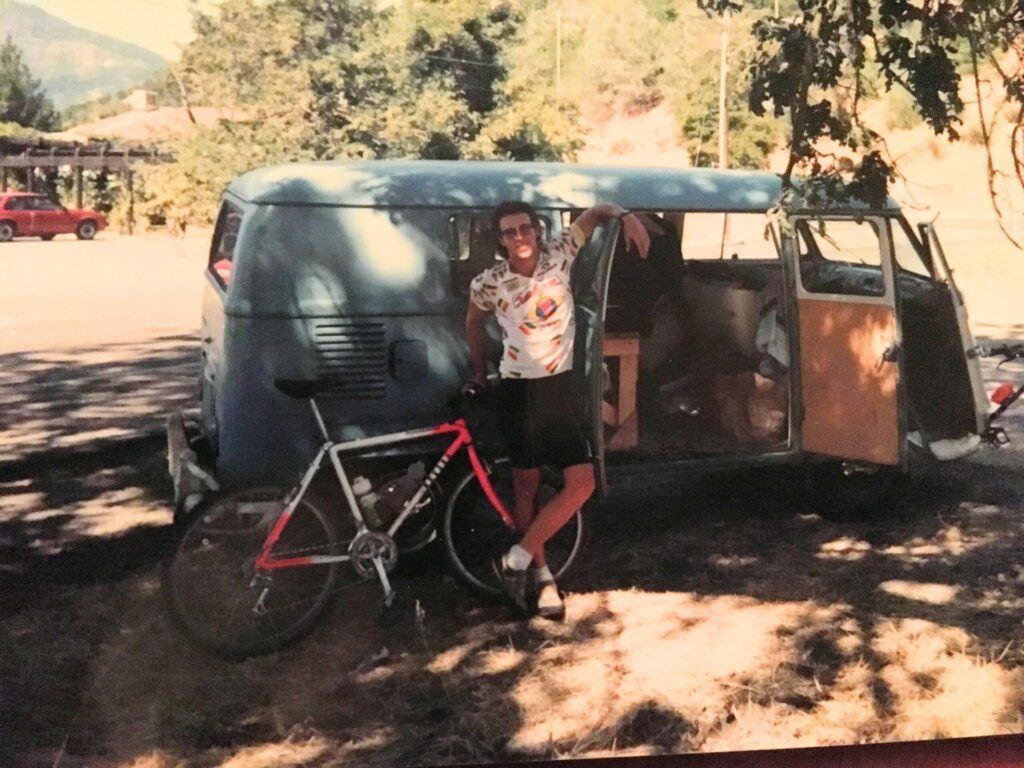
The one who made it happen
A three-sport athlete and member of El Molino’s Class of 1988, Miguel “Mig” Crawford became an elite bike racer following his graduation from Humboldt State. Upon returning to Sonoma County, he spent a decade, on bike and on foot, getting to know the fire roads and byways, the abandoned railroad corridors and old logging trails of west county like the creases on the palm of his hand.
Working with remote, often stunningly beautiful roads such as Sweetwater Springs, Skaggs Springs, King Ridge, Kruse Ranch, Old Caz, Willow Creek—“sounds like a greatest hits album,” notes Crawford, as he ticks them off—he devised long, looping rides that were at once spectacular and spectacularly hard.
Mig and friends would meet in the parking lot behind Occidental’s Union Hotel, where he would hand them a laminated card with a hand-drawn map of that day’s route. In those early, unsanctioned years, there was no registration, no waivers or rest stops or prizes, other than bragging rights and a bag of chips at the finish, paired with a Coke—or perhaps some other, more potent cold beverage.
Crawford would “start us on pavement, jump to dirt, connect through the backwoods to a bit of singletrack,” says old Hopper hand Geoff Kabush, a Canadian mountain biker who competed in three Olympic Games. “It was always fun to see what he was going to piece together.”
The underground feel of those early Hoppers faded as the fields grew. The registration fee edged up, from free, to $5, and then $10. By the time the legendary Ted King showed up to ride his first Grasshopper in 2011, the price of admission was up to (gasp!) $20.
“Hoppers have a different feel than a lot of the other races we do around the country. It still has that original ethos, those nuggets of camaraderie that you don’t see elsewhere.” – pro rider Ted King
The event had been described to him as a group ride, and King remembers thinking at the time, “Why do I need to pay $20 to go on a training ride?”
But he soon found himself drawn in by the fellowship and the beauty of the route. Following the punishing climb of Geysers Road outside Cloverdale, which pitches up the way Mike Campbell says he went broke in Hemingway’s “The Sun Also Rises”: “gradually and then suddenly”—riders took a left at the old Jimtown Store, finishing 3,000 vertical feet later at the terminus of Pine Flat Road.
What King remembers about that day was the fun he had, the friends he made—and the dessert awaiting them.
“There were all these cupcakes,” he recalls, 13 years later. “Really nice, artisanal cupcakes.”
“That might’ve been the best 20 bucks I ever put into my cycling career.”
As many former WorldTour pros have after him, King discovered a fulfilling second career as a “privateer”—a rider unaffiliated with a team—on the gravel racing scene. The Hoppers, he says, “have a different feel than a lot of the other races we do around the country. It still has that original ethos, those nuggets of camaraderie that you don’t see elsewhere.”
As pro mountain biker Alex Wild put it after winning the Lake Sonoma Hopper in 2022, “No one’s telling me to be here. I don’t have to put [Hoppers] on my schedule. But Mig just puts on such good events, it makes people want to ride them.”
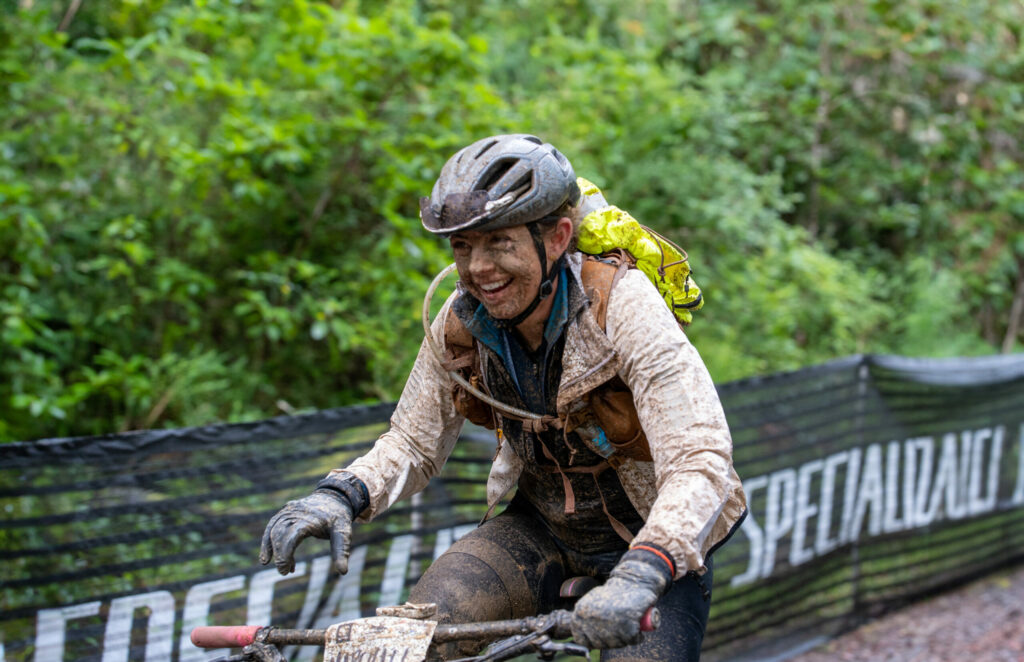
Today we ride
Twenty-six years after Crawford and a dozen of his buddies rolled out of Occidental for the inaugural Hopper, some 600 riders straddled their bikes, chatting nervously in the parking lot at Todd Grove Park in Ukiah. It was January 27, 2024, and the group was waiting for the start of the Low Gap Hopper, a half-dirt, half-pavement, 48-mile ordeal into which Crawford crowded 6,200 feet of climbing. (For context, the first mountain stage of this summer’s Tour de France is 87 miles, with 11,617 feet of gain.)
One the coolest things about these adventures, says Chas Christiansen, an artist and pro gravel rider, is who you end up saying hello to in the parking lot or at the start. “You’re standing next to these pros—Ted King, or Levi, or Peter Stetina—guys who just rode in the Tour de France or the Giro d’Italia. It’s wild.”
Christiansen was a 20-something San Francisco bike messenger in 2010 when a friend talked him into signing up for the Old Caz Hopper – the perennial Grasshopper season opener until 2019, when a landslide prompted the county to close the road. (It has yet to reopen.)
He grabbed his vintage Miele, an Italian-style racing steed—“the only bike I had with gears,” he recalls—and headed for Occidental. Thus did he find himself later that morning battling gravity and the elements on the descent of Old Cazadero Road. Such was the steepness of one muddy section of Old Caz that Christiansen was forced to sit astride the top tube of the bike, braking Fred Flintstone-style.
“I had a foot down on each side, like a trimaran,” he recalls.
Up ahead, riders were dismounting. Why are they doing that, he wondered, until he saw the rain-swollen creek bisecting the trail. “You know it’s a good race when there’s a surprise river,” says Christiansen.
Fourteen years later he’s still racing and riding bikes for a living. Christiansen credits Grasshoppers for helping him “get comfortable being extremely uncomfortable” and “riding deep into the wilderness and being confident in my own abilities to survive and thrive.”
Standing on the far side of Austin Creek that soggy morning, photographer Paul C. Miller snapped a picture of Christiansen as the grinning bike messenger forded the stream, shlepping his vintage road bike. Behind him are two riders, one carrying a mountain bike, the other a cyclocross rig. Crawford in particular treasures that image because it captures a core Hopper tenet: There is no “right” bike.
It has long delighted him that these mixed-terrain adventures force specialists out of their comfort zones. Pure roadies merely survive the rocky, technical sections. Fat-tire folk struggle to keep up on pavement. As Hopper apostle Austin McInerny recalls, each new event prompts a fresh round of “tinkering with our bike set-ups, asking one another, ‘What tires you gonna run?’” “For me, that was the fun,” says Crawford, who for years competed in his own events, finishing first in exactly one of them. “Here’s the course, now choose what to ride. We’re all trying to get there as fast as we can. How’s that going to play out?”
Some of that mystery has been removed by the emergence of discipline-specific gravel bikes—including those made by Specialized, now the title sponsor of the series.
McInerney got his first taste of the Grasshopper series around 2006. He was immediately beguiled by the beauty of the routes, and grateful for Crawford’s willingness to share. “Surfers are all about locals only, but Mig’s attitude was, ‘No, you’re here, you’re willing to check it out, you’re part of my group.’” That day’s ride finished at the top of Willow Creek Road, “and it was a huge party up there, chips and beer and soda and people just hanging out, celebrating.”
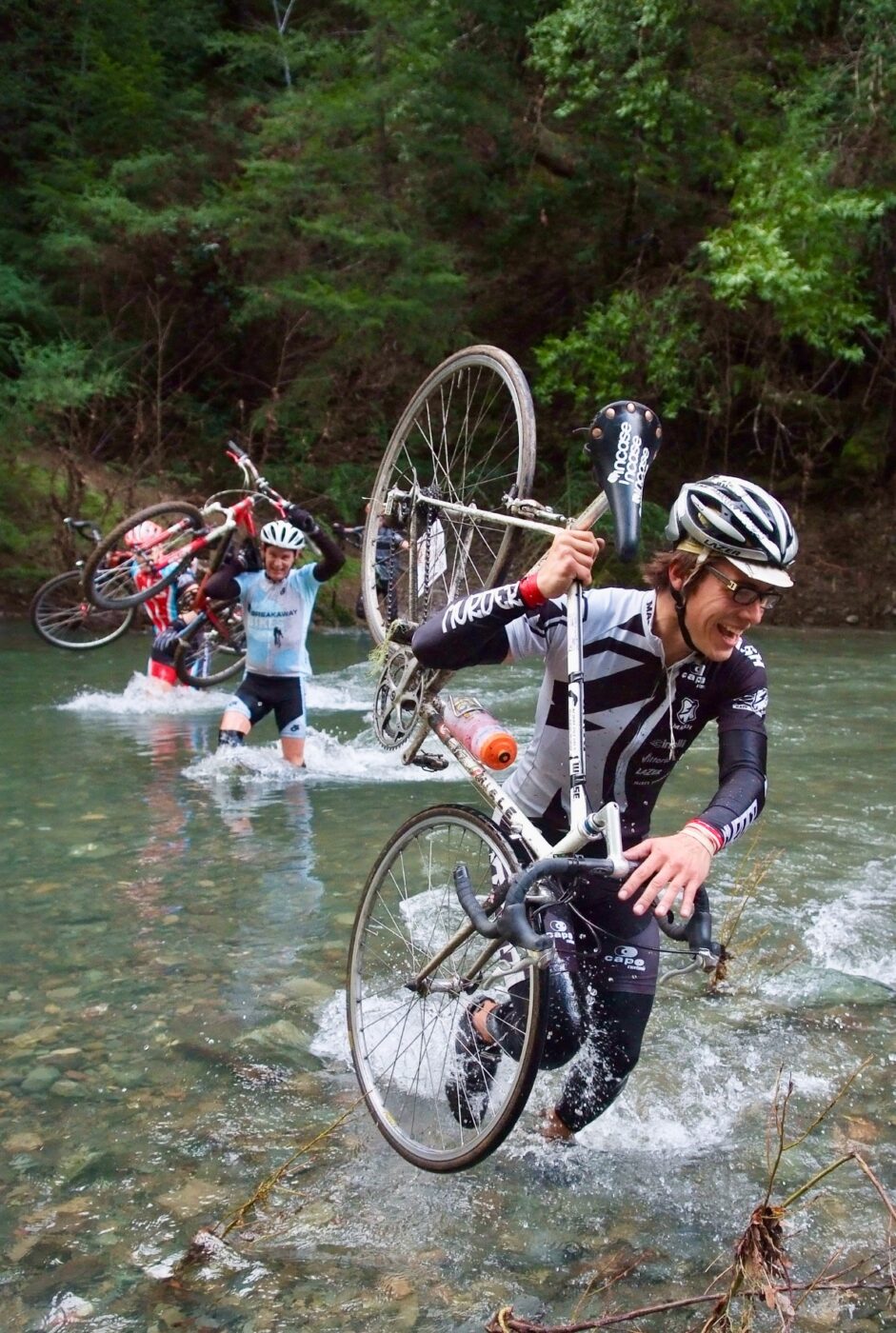
Growing pains
Rider Austin McInerny has a background in environmental planning and has consulted extensively on natural resource management cases, including work with the U.S. Forest Service and other federal agencies “with thorny issues, a lot of it dealing with recreation and public lands management.”
For the last six years or so he’s been Crawford’s point man, working with Sonoma County to get the Hoppers permitted. For years, he said, wrangling those permits had been straightforward.
Early in 2022, when the county began consideration of McInerny’s application for a permit to run the King Ridge Supreme Hopper in March of that year, “that’s when things started to go sideways.”
As they later learned, the county was in the process of updating its system for reviewing events such as theirs. As part of that overhaul, Hopper applications were now being scrutinized by newly created Municipal Advisory Councils.
In late January of ’22, Crawford and McInerny were informed by Permit Sonoma that the King Ridge application had drawn the attention of the powerful California Coastal Commission. Concerned citizens had objected to numerous aspects of the application—in particular the Grasshoppers’ plan to use Willow Creek Road, described by one as “an environmentally fragile area within Sonoma Coast State Parks’ salmon-bearing Willow Creek watershed.”
In addition to adverse impacts sure to be suffered by the salmon, the citizen went on, area roads would be blocked by cyclists “and their friends and families cheering them on.”
With the event less than two months away, Crawford and McInerny modified the course, routing riders away from Willow Creek. For weeks, the Coastal Commission withheld its approval of the application. In a letter to the commission, McInerny expressed frustration with its ongoing “review,” pointing out that this Hopper no longer passed through the area of environmental concern.
“The event does not use any of the coastal pullouts, is outside of the busiest time of year, nor requires any road closures. The event has already received approval from California Highway Patrol and is under review by Caltrans, which issued a permit for the same event in 2019.”
“Sadly,” he wrote, “this appears to be a case of locals not wanting to share the beauty of west Sonoma County with others.”
The Grasshopper never did hear back from the Coastal Commission. But a week after McInerny sent his letter, Crawford was informed by Permit Sonoma, that, upon careful review of the code, organizers didn’t need an encroachment permit for the King Ridge Supreme, after all.
The event was on! But the drama was not over.
The course called for riders to roll west on Skaggs Springs Road, then south on Tin Barn Road. Unbeknownst to Crawford and McInerny, that intersection, and the land around it, is the Stewarts Point Rancheria of the Kashia Band of Pomo Indians.
Some of the Kashia Pomo, including tribal chairman Reno Keoni Franklin, were upset that neither the county nor representatives from the Grasshopper Adventure Series had consulted them.
“They did not require safety measures to protect the children and elders who [live] on the Rez. They did not require the riders to post safety signs or to slow down when entering the reservation,” Franklin wrote in a Facebook post the day before the ride.
Describing the event as “extremely dangerous,” that he would be “driving tomorrow to block the road and anyone participating in the race to walk their bike through reservation. I am traveling on this and could use some support.” short notice, Crawford changed the route again, shortening the course considerably to the rancheria. a follow-up email to riders, Crawford explained that he hadn’t consulted with the Kashia before this Hopper, “but neither had we prior to any of our previous events, as this was not requested by any of the county nor California permitting agencies that we had consulted. As far as we understood, both Tin Barn Road and Skaggs Springs-Stewarts Point Road are public roads which have been used legally by the public for years.”
Having spoken with chairman Franklin, Crawford continued, “I now understand the importance of contacting the Tribe, regardless of what is required by the state or the County of Sonoma. All of us, unless native to California, are visitors on this land, and this is important to remember and recognize.”
Scarred by those experiences, and considering “the uncertainty and extremely laborious requirements” of the overhauled permitting process, says McInerny, the Grasshopper hasn’t applied for any permits in Sonoma County since—with the exception of the Lake Sonoma Hopper, which is held on lands managed by the U.S. Army Corps of Engineers, which has been “fantastic to work with,” says Crawford.
“We were caught,” McInerny believes, “in the middle of an apparent turf battle between the various MACs” and Permit Sonoma staff.
While unwilling to comment specifically on the Grasshopper series, Permit Sonoma director Tennis Wick defended the county’s revamped permitting process as an improvement over the old one, describing it as more efficient, and more responsive to concerns voiced by locals.
“Conducting a community event requires engagement with and respect for that community,” he wrote in an email. “There have been multiple complaints about events impacting local residents and Tribal Partners. Now that advisory councils receive referrals on event applications, residents and businesses may comment on proposals affecting their communities.”
The Grasshopper’s brief flareup with the Kashia Pomo left “no hard feelings,” says Franklin. “We know they learned from it, and in a good way.” He describes Crawford as “a great guy” running “a great organization. They’re raising funds for good causes—causes we support, too.” (The Grasshopper series often donated money to the west county volunteer fire departments along its routes.)
“If they ever do come back, we’ll be happy to work with them.”
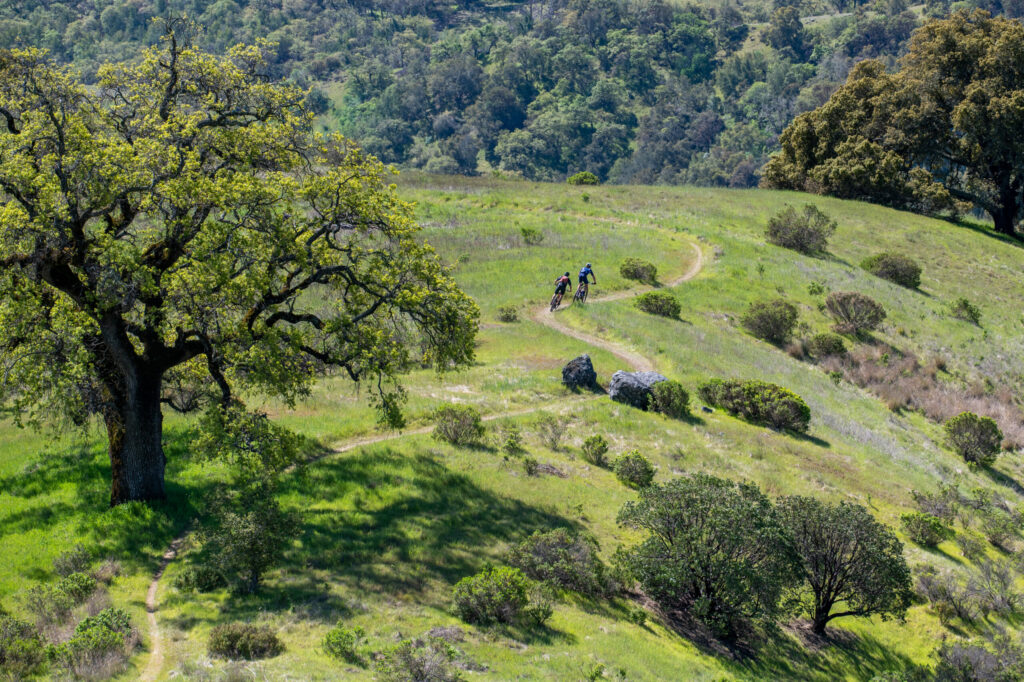
New chapter, new outreach
For now, however, the series that sprung up organically in Sonoma County holds all but one of its events elsewhere. In Mendocino County, Ukiah has embraced the Grasshopper series, hosting both the 2024 season-opening Low Gap Hopper in January and the Ukiah- Mendo Gravel Epic on May 11. The 89mile Huffmaster Hopper, on February 24, took place in Colusa County.
“What we’re looking for now,” says Crawford, “is to do events in communities that want us to be there, that see the benefit—that we’re bringing money in, bringing a form of recreation that’s healthy and positive.”
Yes, he is wide open to future rides in Sonoma County, but not if it means the kind administrative war of attrition the Grasshopper endured in 2022.
“It’s a shame,” says Peter Stetina, of the Hoppers exiting Sonoma County, “because they have such a rich history there.” He spoke of widespread “disgruntlement” within the county’s “cycling community”—a frustration with some leaders’ inability to see “a bigger picture” and appreciate the tourism dollars cycling can bring.
Amity Rockwell was philosophical about the migration of Grasshoppers from their original home, describing it as not so much sad as “a little bittersweet,” and, perhaps, inevitable.
Riding King Ridge and Old Caz and Willow Creek “was pretty special,” Rockwell allows. But as the number of riders in the Hoppers “doubled and tripled in size,” it became more difficult to hold the events “in a respectful manner in these really tiny places.” As it booms in popularity, the gravel scene “has undergone massive change in the last six or seven years. There are a lot of races that aren’t what they used to be. They’re something new now.”
One recent addition to Crawford’s series is a rider mentor program devised by Helena Gilbert-Snyder, a pro rider and analyst at Specialized Bicycles.
Gilbert-Snyder is passionate about correcting gender disparity in sports—which can be especially pronounced in cycling. Women make up a little over 20% of the Grasshopper fields. While that’s “above average” for gravel events, says Crawford, “I would obviously like it to go higher.”
Lining up for the Low Gap Hopper will be 20 young female riders, each paired with a seasoned female mentor.
What the job entails, said Rockwell, one of the mentors, is to “follow a junior rider around for the day, help them eat and drink and wear the right clothes.” While it might seem straightforward, “it’s a lot to take on, if you’ve never done this before.”
“When I was just getting started in my early 20s,” she recalls, the Hoppers “were a way for me to race against Olympians and WorldTour riders. And now here’s a chance for me to help a young rider who maybe has dreams of doing what I do, someday.”
She’s confident that the Hoppers will bloom wherever they’re planted. Spectacular as it is, Sonoma County has no monopoly on gorgeous Northern California scenery. And Crawford, she believes, has created “this, like, magic potion,” of elements, including the chance for pros to race hard “but not take everything so seriously,” and for up-and-coming riders to rub elbows with the pros.
“It’s just the right mix. We’re all drawn to it.”
Who loves a Hopper?
The front row of any Hopper sendoff has long bristled with world-class talent. Here are some of the big names who’ve suffered for vertical gain in the hills of western Sonoma County.
Mountain bike world champions: Chris Blevins, Kate Courtney
WorldTour road racers: Katie Hall, Ted King, Levi Leipheimer, Peter Stetina, Alison Tetrick Laurens ten Dam
Olympians: Geoff Kabush, Katerina Nash, Flavia Oliveira, Max Plaxton
Local rising stars: Luke Lamperti, Ian Lopez de San Roman, Vida Lopez de San Roman
The post Gravel Racing Was Happening in Sonoma Long Before It Became Cool. Now It’s Disappearing appeared first on Sonoma Magazine.
]]>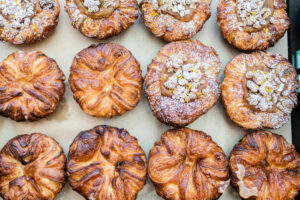
From delicious baked good to fresh handmade pasta, here are some of our dining editor's top picks.
The post Where to Eat Right Now in Sonoma County appeared first on Sonoma Magazine.
]]>
















Dining editor Heather Irwin picks three top spots for dining out in Sonoma County as spring arrives. Click through the above gallery for a peek at a few favorite dishes at each restaurant.
Golden Bear Station
Chef Joshua Smookler tested nearly 100 pizza doughs for his new restaurant, and he’s still tweaking the recipe. The moisture, the flour, the “secret ingredient” he declines to share, the temperature of the wood-fired oven, and even the weather are all critical to the final result—a crust dotted with leopard spots, neither too burnt nor too raw, but just right.
Golden Bear Station, which Smookler owns with his wife, Heidy He, is a departure for the couple, who opened the critically acclaimed Animo in downtown Sonoma in 2022. While that now-shuttered dining experience focused on livefire cooking with luxe ingredients and Mediterranean and Korean influences, Golden Bear Station pays homage to Italy. Mostly.
Smookler and He shrug off being pigeon-holed into specific categories, and the new menu, which leans heavily on gourmet pizzas and pasta, also includes a hamburger, a tuna crudo starter, and a $155 whole lamb saddle, which must be ordered ahead of time. The scallops tiradito starter riffs on Peruvian-style crudo, with raw scallops thinly sliced into disks and stacked in basil oil, green tomato, and finger limes—a flavor bomb of sweet mollusk, tart citrus, and aromatic vegetal notes. The couple have also reprised the Asian-inspired pork chop in umami-laden dashi broth and lobster in XO sauce with lemongrass tea previously on the Animo menu. (Animo is slated to reopen in 2024 with a new concept.)
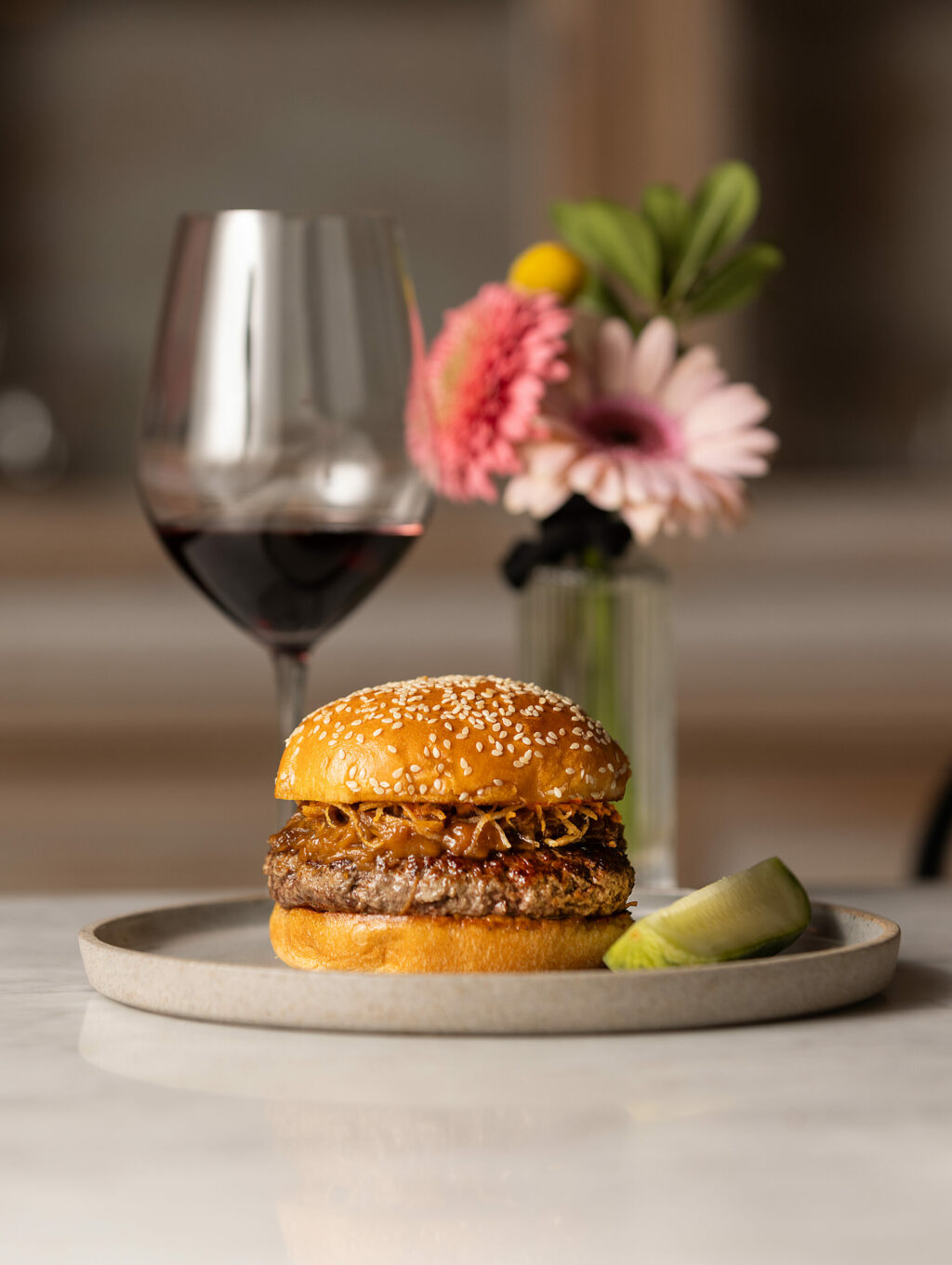
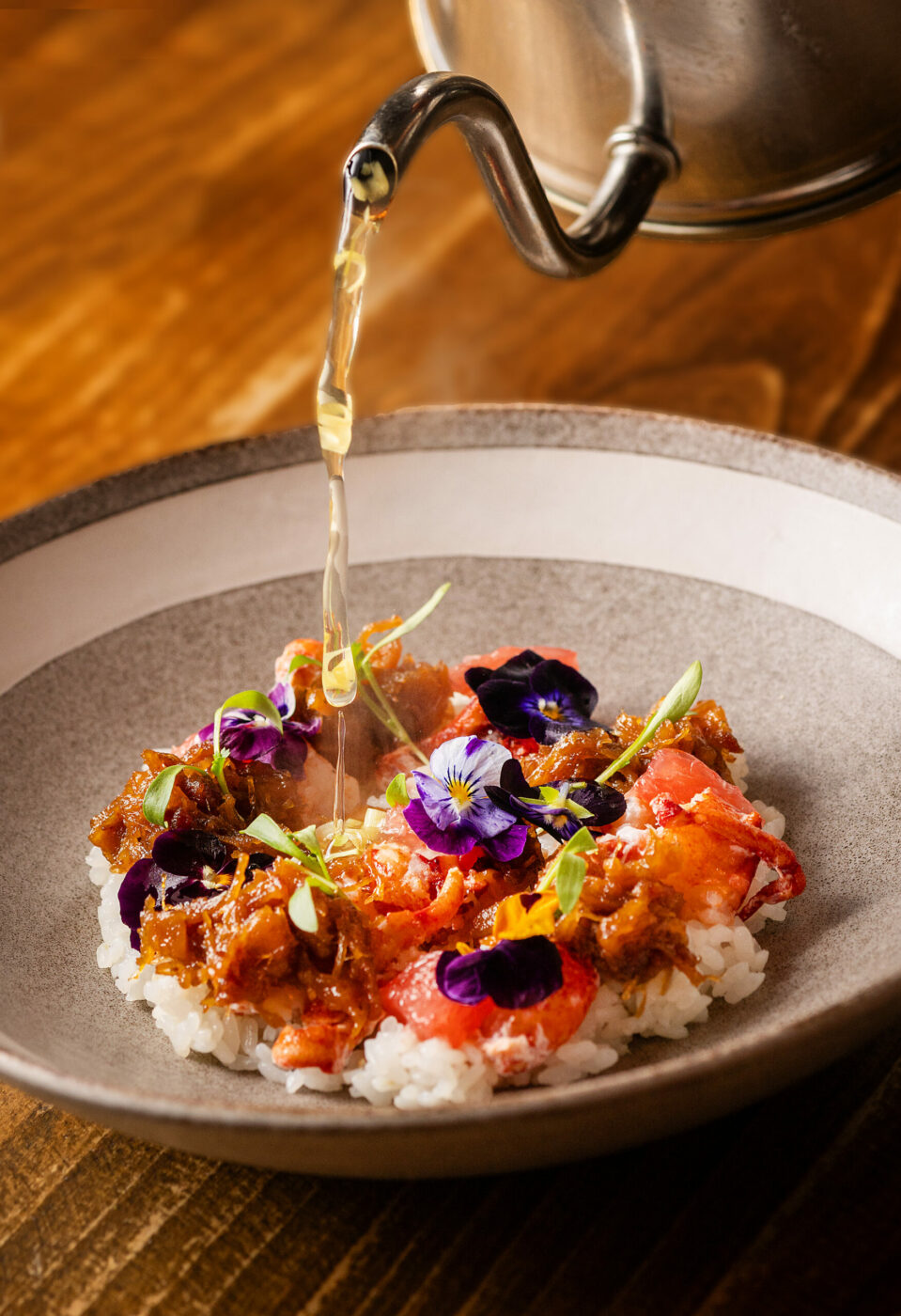
What brings this diverse set of offerings together is just how extraordinary everything is. Take the classic cacio e pepe , a classic bucatini pasta. Here, the dish is elevated with seven different kinds of pepper, giving it a spicy punch that lingers on the tongue. There’s an option to add fresh uni, which lends a creamy, briny, sweet accent, further elevating the dish. Pasta Bolognese is equally impressive, with a meat and tomato sauce that sticks to every centimeter of the fresh, housemade paccheri pasta (a larger, wider sibling of rigatoni).
Pizzas are a highlight, perfectly cooked without any bitter notes of char. The soft, chewy dough has a puffed crust and a thin but sturdy middle that holds on to ingredients rather than letting them all slide off. The best bet is the Boscaiola pie, topped with fresh mushrooms, sharp fontina cheese, and truffles, though the classic Margherita also shines.
Smookler and He’s shared passion for exhaustive research, even on the simplest of dishes, sets Golden Bear Station apart. As the menu continues to evolve, the amount of time and passion the couple invest in their practice is sure to lead to many more equally revelatory dishes.
8445 Hwy. 12, Kenwood. goldenbearstation.com
Monday Bakery
There is no tidy way to eat kouign-amann, the sweet but complicated cousin of the croissant. This crisp, buttery, caramelized French pastry explodes into a million tiny pieces of sugar and dough at the mere suggestion that you might eat it; napkins are useless against its many layers; and it laughs at your attempts to wipe the buttery crumbs from your face and hands.
And somehow, that is my warped rationale for eating one while driving away from Sonoma’s Monday Bakery. No matter what, it’s making a mess. Why not enjoy the ride?
The downtown bakery, owned by Sally Geftakys, crafts super-sized versions of kouign-amann (pronounced “queen-uh-man”), roughly translated from French as “you will be wearing these pastry crumbs for several days.” With crunchy petals of laminated dough and an airy honeycomb interior, they’re worth every bit of mess, hassle, and calorie (your hands will smell like a pat of butter for several hours).
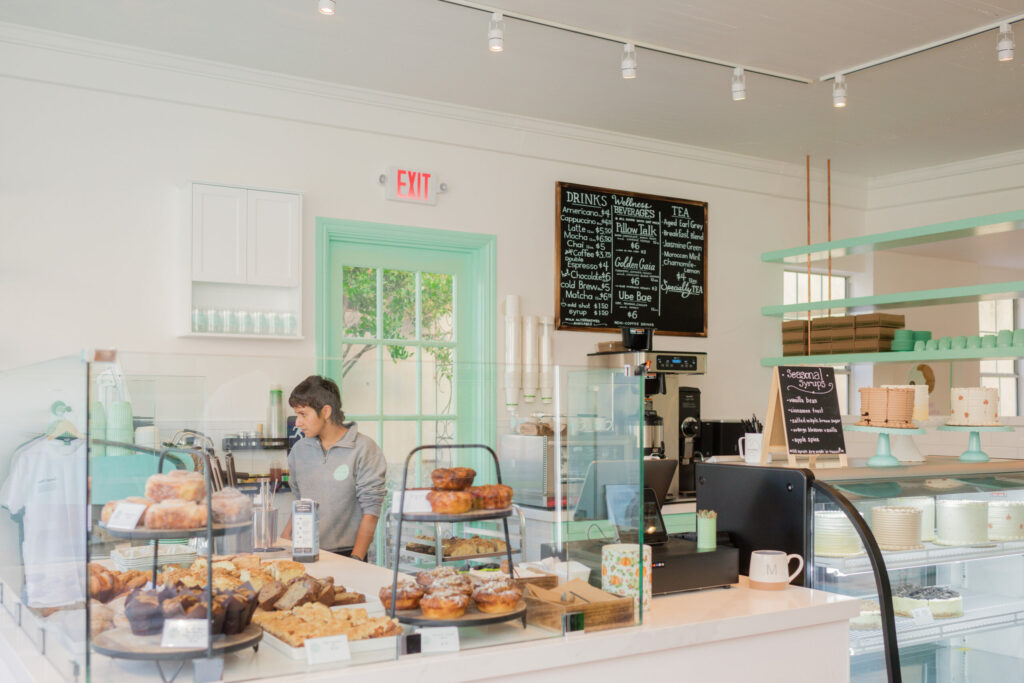
Geftakys, a CIA Greystone graduate and passionate baker, launched Monday Bakery at local farmers markets and pop-ups in 2017. But after finding a ravenous audience for her seasonally inspired sweet and savory pastries, she opened a storefront in downtown Napa in 2019, followed by this new Sonoma location in late 2023.
Seasonal ingredients like pears, apples, and berries fill scones and turnovers; ham, cheese, or chocolate are hidden inside fat croissants; and muffins, cookies, and quiche beckon from the glass display case. Premade sandwiches on fluffy baguettes are ready to grab and go. Nutella-frosted banana bread is a revelation—and the only way I’ll ever enjoy it again.
I’ll be cleaning the crumbs from my car upholstery for weeks, but life is too short not to dive into a messy bag of pastries immediately and without regret.
117 E. Napa St., Sonoma. 707-699-2960, mondaybakery.com
de Havilland
For nearly 13 years, chef Mark Malicki spent his Friday, Saturday, and Sunday nights cooking in a closet-sized kitchen at the Casino Bar & Grill in Bodega. Inside that kitchen was a two-burner stove, a flat-top grill, and a refrigerator drawer—not exactly a dream setup for a chef.
But somehow, Malicki made it work, serving up decidedly un-barlike dishes like short rib goulash with mushroom gratin, Dungeness crab from nearby Bodega Bay, buttermilk fried rabbit with rémoulade sauce, or Wagyu beef with foraged chanterelle mushrooms. Without the financial pressures of a brick-and-mortar space, Malicki thrived in the remote west county town as a culinary curiosity— an off-the-beaten-path food destination beloved by insiders, but mostly ignored by the Michelin-star obsessed.

Now 64, Malicki says he was ready for a change, something closer to home, with a more expansive kitchen. After leaving the Casino last year, he created de Havilland, which takes over Petaluma’s Tea Room Cafe three nights a week, Thursday through Saturday. It’s a through line for Malicki’s deep-rooted passion for, well, whatever he’s passionate about at the moment—whether that’s frying latkes in Chinese scallion oil, feeding crab boat workers facing a deferred season, cooking for a fundraiser, or sharing a produce haul from his favorite farmer.
What you’ll experience will likely be a surprise, unless you follow Malicki’s Instagram (@malle.mal), where he posts the evening’s dishes along with observations and insights. There’s often a theme, but sometimes there isn’t, and it’s better not to go with any expectations. Just put yourselves into Malicki’s hands, and enjoy being treated to de Havilland’s wild, wonderful, heartfelt, idealistic, perfectly imperfect world.
316 Western Ave., Petaluma. 707-623-5141, cafedehavilland.com
The post Where to Eat Right Now in Sonoma County appeared first on Sonoma Magazine.
]]>
Discover the beauty of spring in Sonoma County. From farm tours to cooking classes, we have the perfect getaways for food lovers.
The post 10 Spectacular Spring Getaways in Sonoma County appeared first on Sonoma Magazine.
]]>
















Here are our favorite spring getaways — from farm tours to cooking classes — for those who love to celebrate good food.
Meet the Milk Producers
“Springtime is the most beautiful time on the farm,” says Jennifer Bice, owner of Sebastopol’s Redwood Hill Farm-Capracopia, whose family has been raising goats in Sonoma County since 1964. “We have fruit orchards in bloom, but really, the highlight is the baby goats.”
Spring farm tours, often led by Bice herself, spotlight what she calls “kid cuddling”—as in the baby goat kind of “kid.” Guests are invited to sit on bales of hay while baby goats frolic and clamber into laps (one sweet kid, just a week or so old, nibbled on a corner of a guest’s shirt). The socialization is important for the young goats—as adults, they must be gentle and used to being around people to be milked, explains Bice.
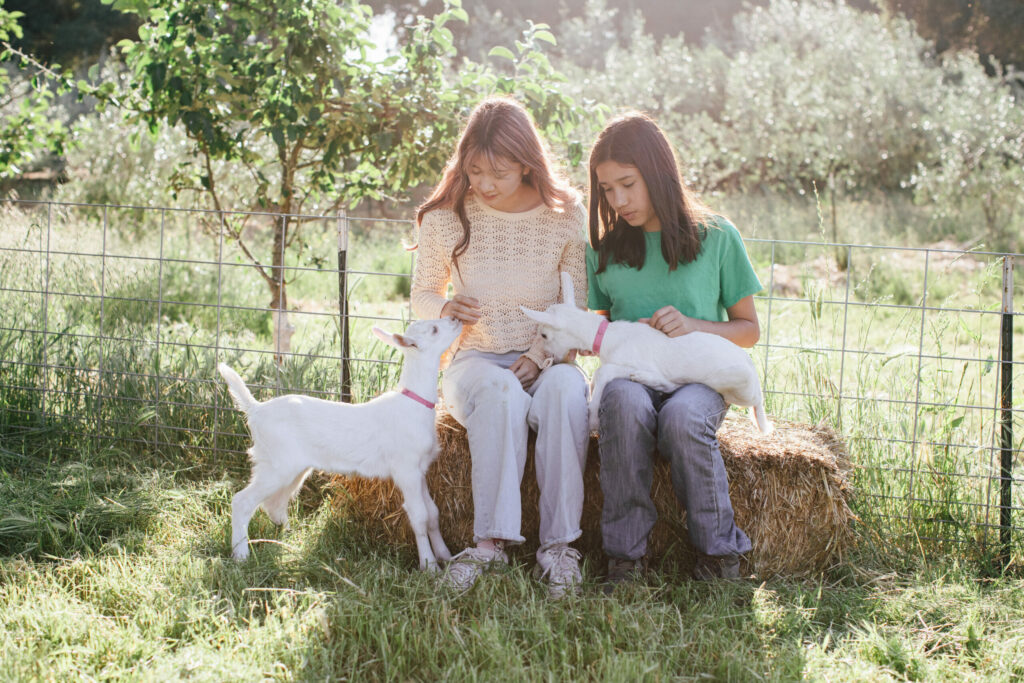
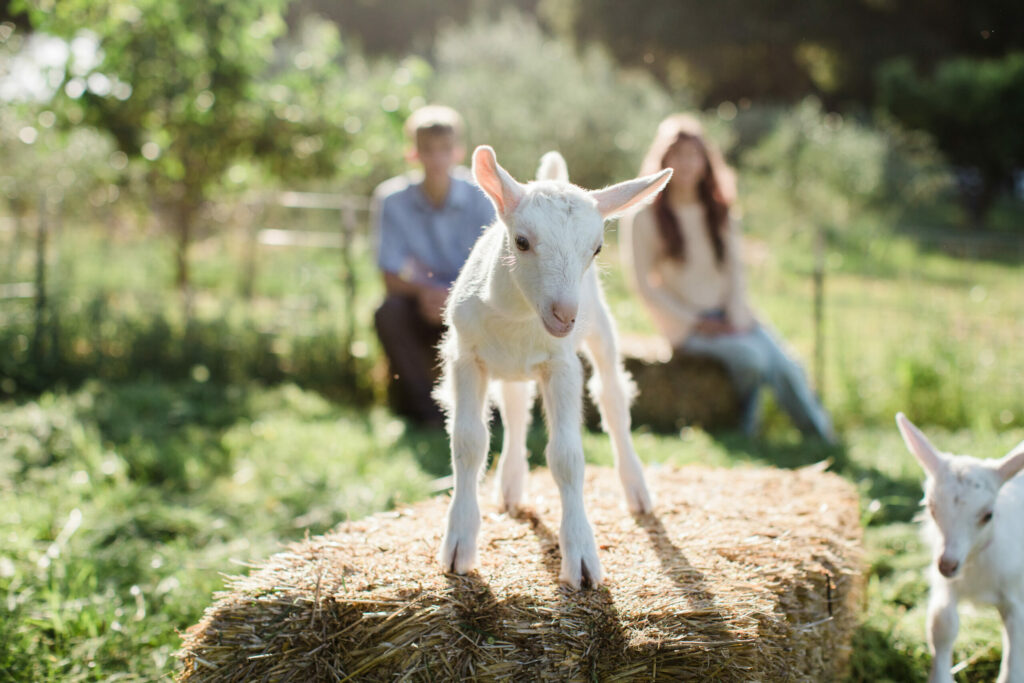
Farm tours also visit a large solar array, the adult goat barns, and the milking parlor (the equipment is a mini-me version of cow-sized equipment) and teach about the farm’s commitment to sustainability and regenerative farming.
A small farmstand offers estate-grown extra virgin olive oil, goat milk soap, and bouquets of spring ranunculus, sweet peas, and other beauties grown on the farm. After hanging out with the kids, linger with an alfresco lunch in the farm’s lush picnic fields. Pick up picnic provisions at nearby Andy’s Produce Market (1691 Gravenstein Hwy. N., Sebastopol) on your way to the farm.
Redwood Hill Farm-Capracopia. 5440 Thomas Road, Sebastopol. redwoodhillfarm.org
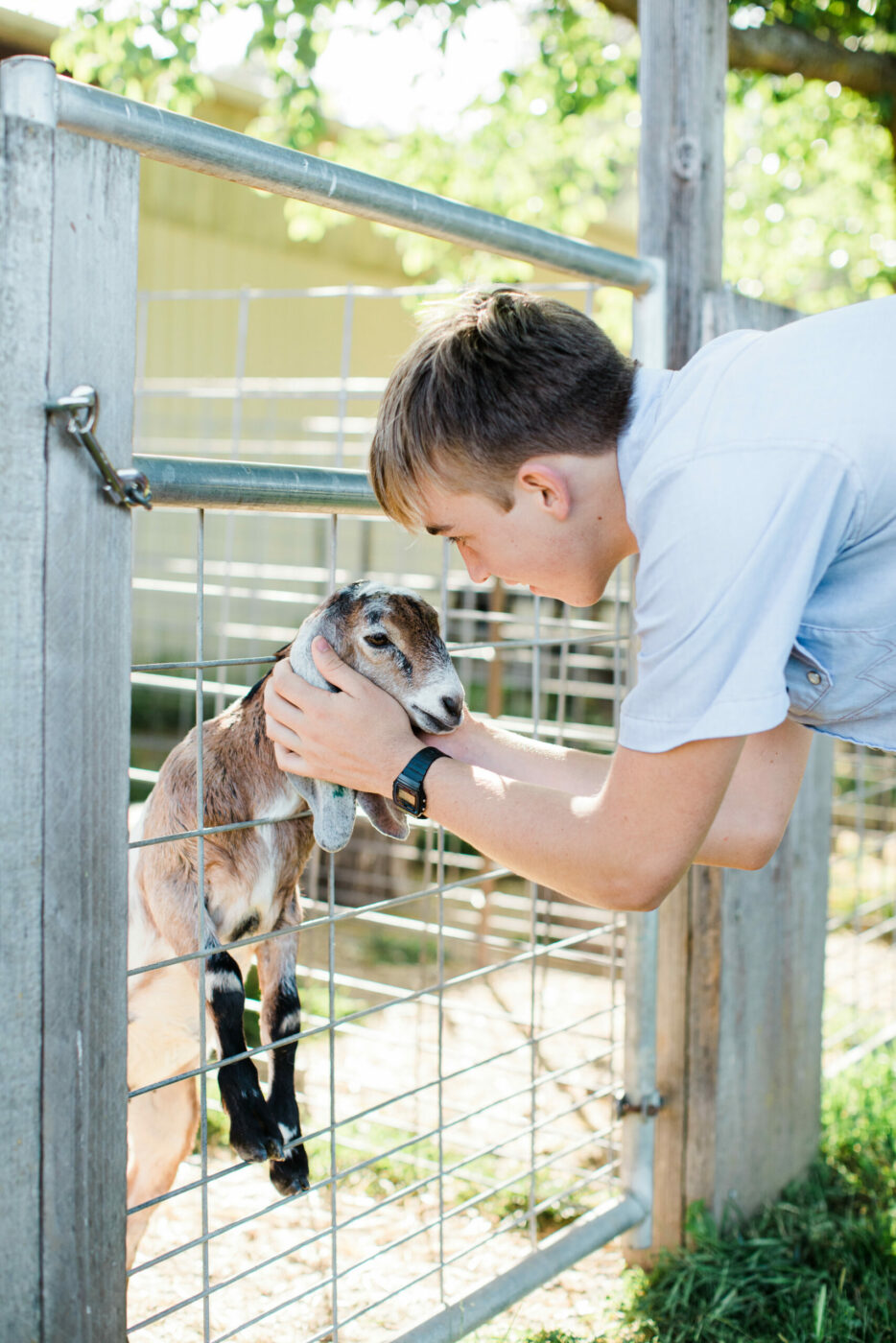
Adventure with Experts
There’s a ton of ground to cover in Sonoma County. For a refreshing change of pace, let someone else show you around as you indulge your culinary passions. Behind the wheel of a glitzy new Land Rover Defender, Bohemian Highway Travel Co. ensures that your day will include unique, often family-owned wineries, many not normally open to the public. Admiring vines up close is intriguing in any season, but traversing vineyards on sunlit spring days yields a powerful spirit of renewal.
The company’s thoughtful itineraries also acknowledge Sonoma County’s evolving food scene. Farm-to-table picnic lunches are prepared by chef Jennifer McMurry of Bloom Carneros fame, and lunch spots are carefully selected in advance. At Beltane Ranch, for example, getting to the primo picnic sites typically includes buckling into an all-terrain vehicle to bump through vineyards, olive orchards, and pastures studded with longhorn cattle and adorable sheep.
Bohemian Highway Travel Co. 707-204-9660, bohohwy.com
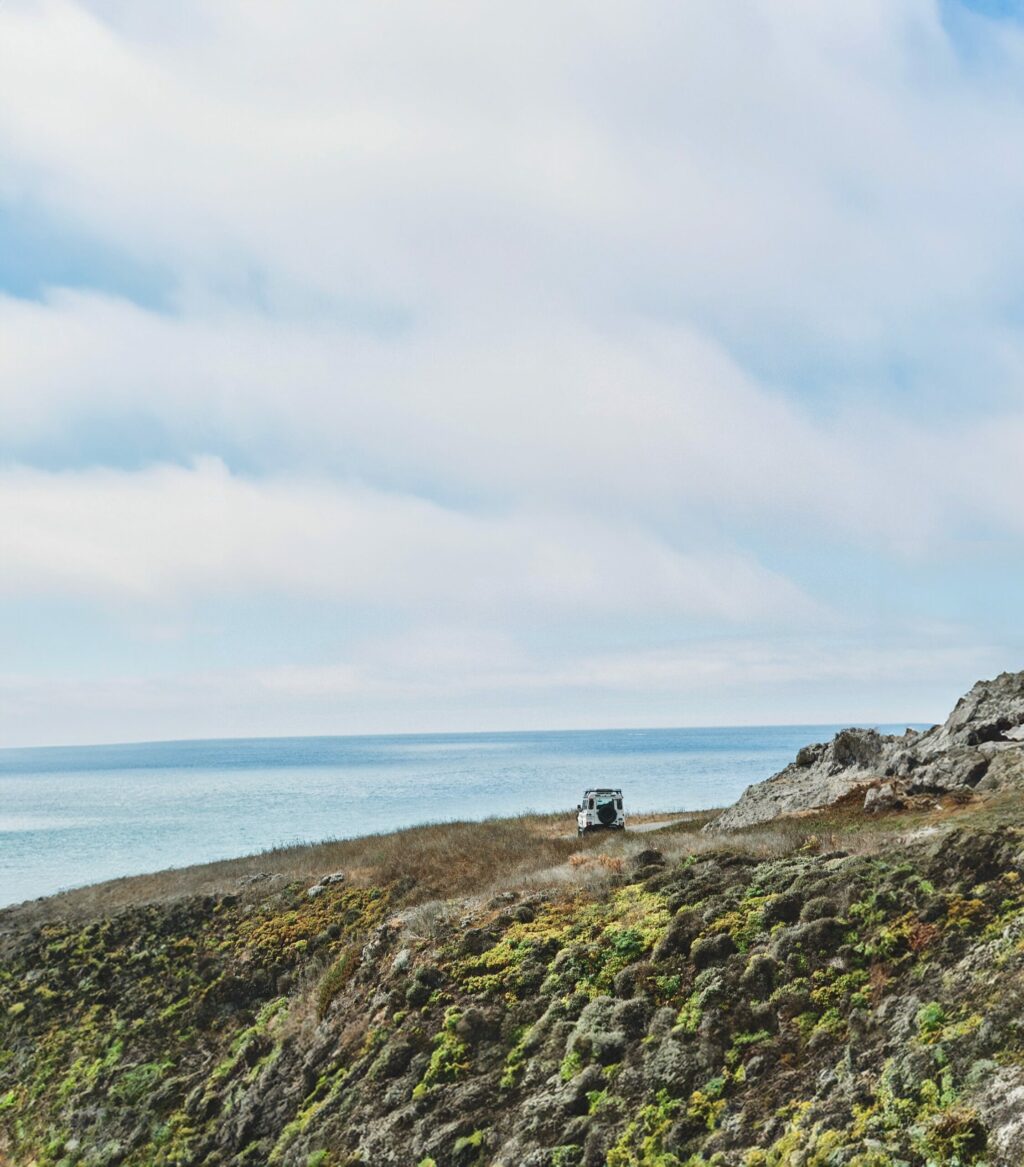
Overnight Ranch Stays
Who says tree houses are for kids? Located on 400 acres in Bodega, just a short distance form the coast, a 30-foot spiral staircase leads the way to the Eagle’s Nest Treehouse at Salmon Creek Ranch. When you’re not lounging on the wraparound deck, you’ll likely be hanging out with the resident cows, ducks, goats, and charming livestock guardian dogs. Grill your own dinner with ranch-raised meats from the small, on-site market, which sells filet mignon, short ribs, carne asada, and sausages.
Less than 15 minutes outside Healdsburg, the splurge-y NewTree Ranch is a biodynamic farm with the feel of a luxury wellness resort. Cook fresh produce in the modern outdoor kitchen, collect eggs from the henhouse, or take an outdoor soak alongside your partner in side-by-side clawfoot tubs. Don’t be surprised if a Scottish Highland cow or knobby-kneed Nigerian goat swings by to see what all the splashing is about.
Or, after savoring a multicourse food and wine pairing at Lynmar Estate in Sebastopol, call it a night at the winery’s luxurious Bliss House, which overlooks serene Quail Hill Vineyard and the Laguna de Santa Rosa.
Salmon Creek Ranch. 707-775-9604, salmoncreekranch.com
NewTree Ranch. 707-433-9643, newtreeranch.com
Lynmar Estate. 707-829-3374, lynmarestate.com
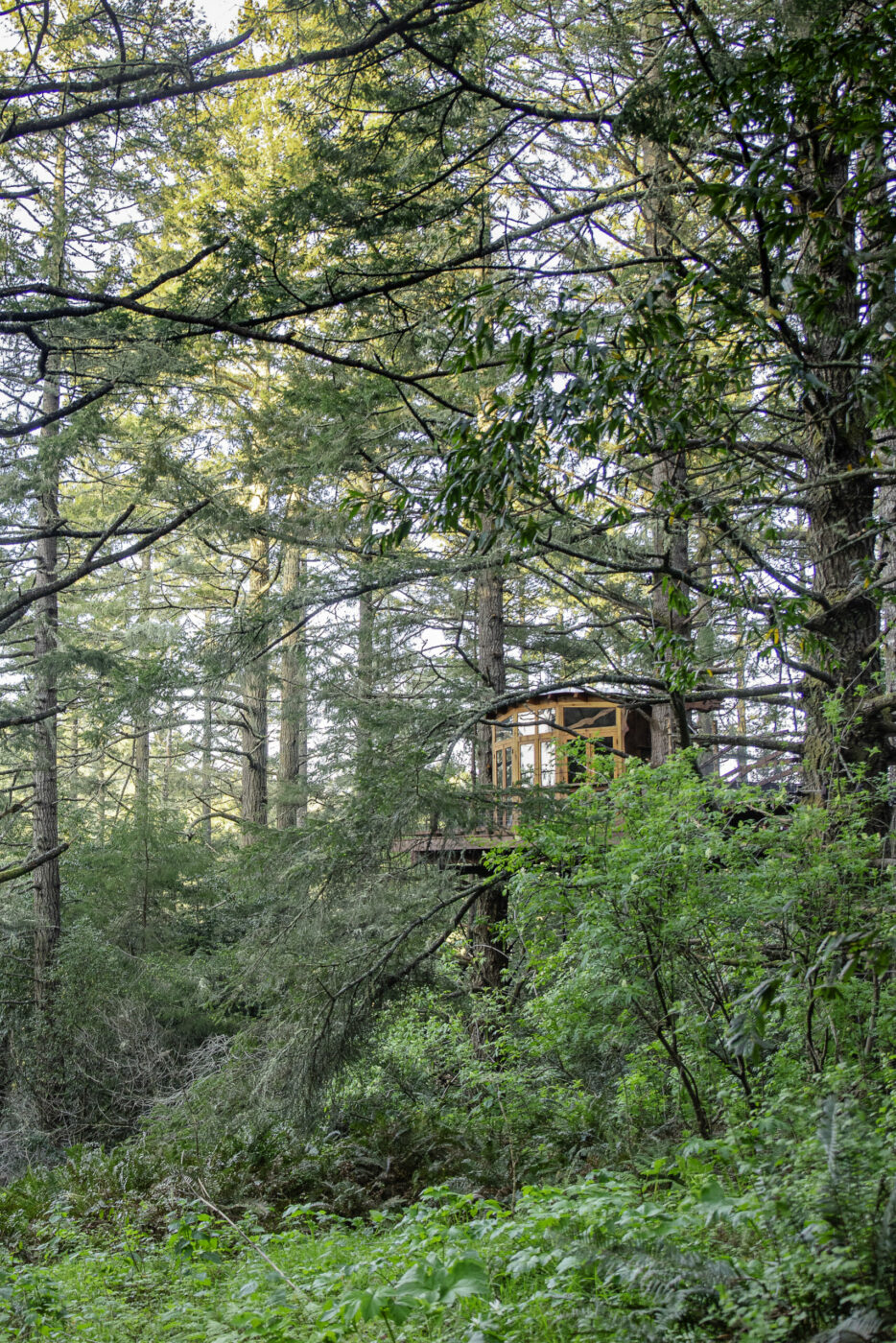
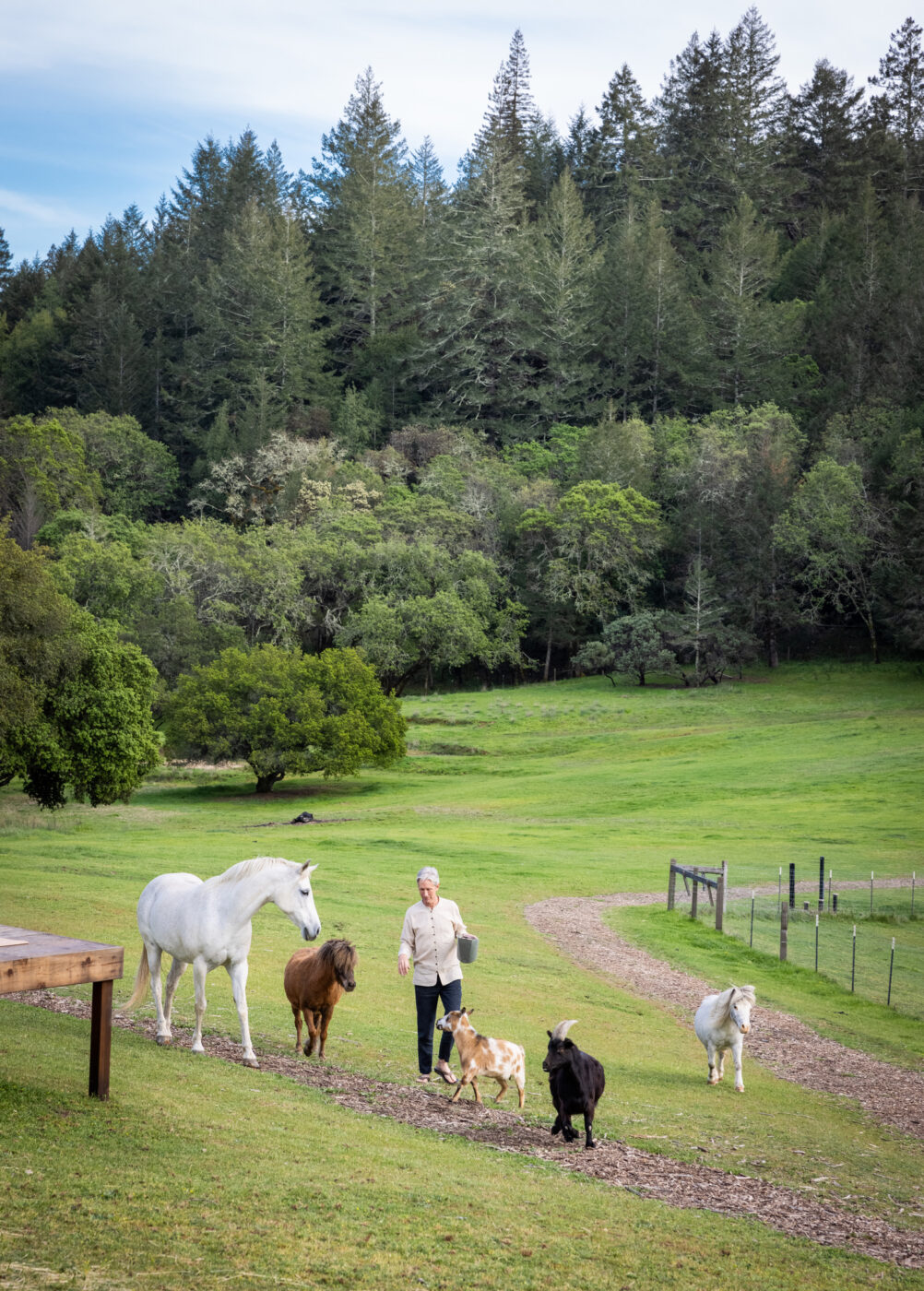
Forgotten Freestone
When was the last time you wandered through the tiny west county hamlet of Freestone? If you have to stop and think about it, you’ve got some catching up to do.
At much-loved Wild Flour Bread (140 Bohemian Hwy.), crusty loaves of sourdough and fougasse, fruit-studded scones, and cookies, fresh out of the wood-fired brick oven barely have a moment to cool before being snapped up. Go ahead, buy one loaf for now and one for later—and perhaps also something sweet and delish to enjoy straightaway in the bakery’s sundappled garden.
Practically next door is the new Jasper House tasting room from cult-favorite Pinot Noir and Chardonnay specialists Black Kite Cellars (12747 El Camino Bodega). In spring, owners Tom and Rebecca Birdsall and their team love taking visitors into the nearby vineyard to introduce them to the wonkish world of Pinot Noir clones.
No spring field trip to Freestone is complete without a stop at BlueGoat (380 Bohemian Hwy.). Formerly known as Freestone Artisan Cheese, the charming market features cheese from close to home and around the world. Lucky you, you’ve already got the bread.
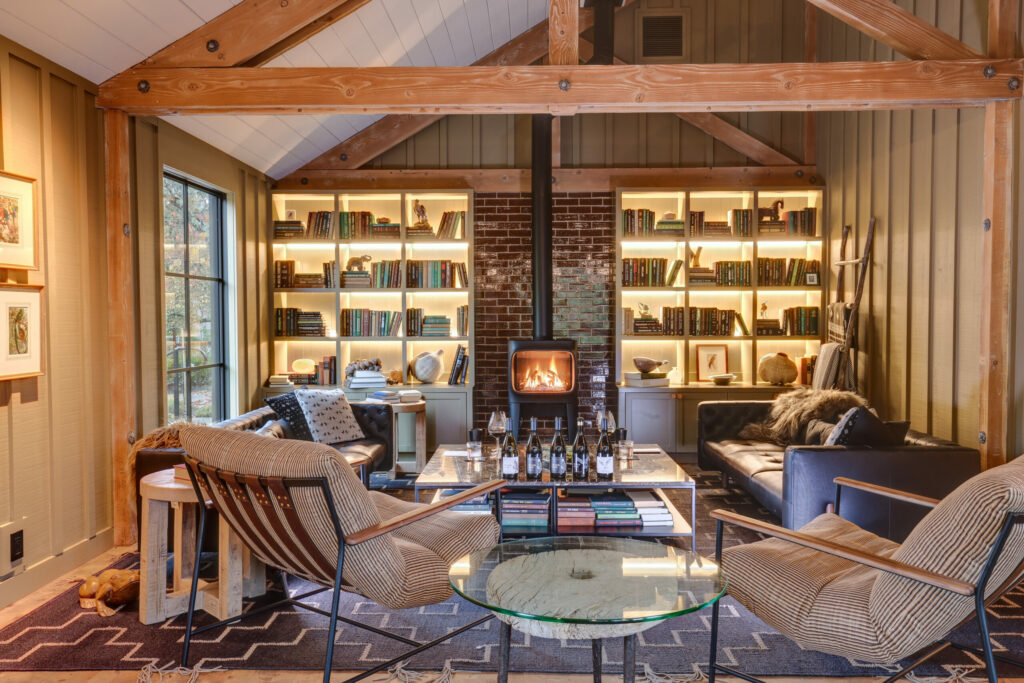
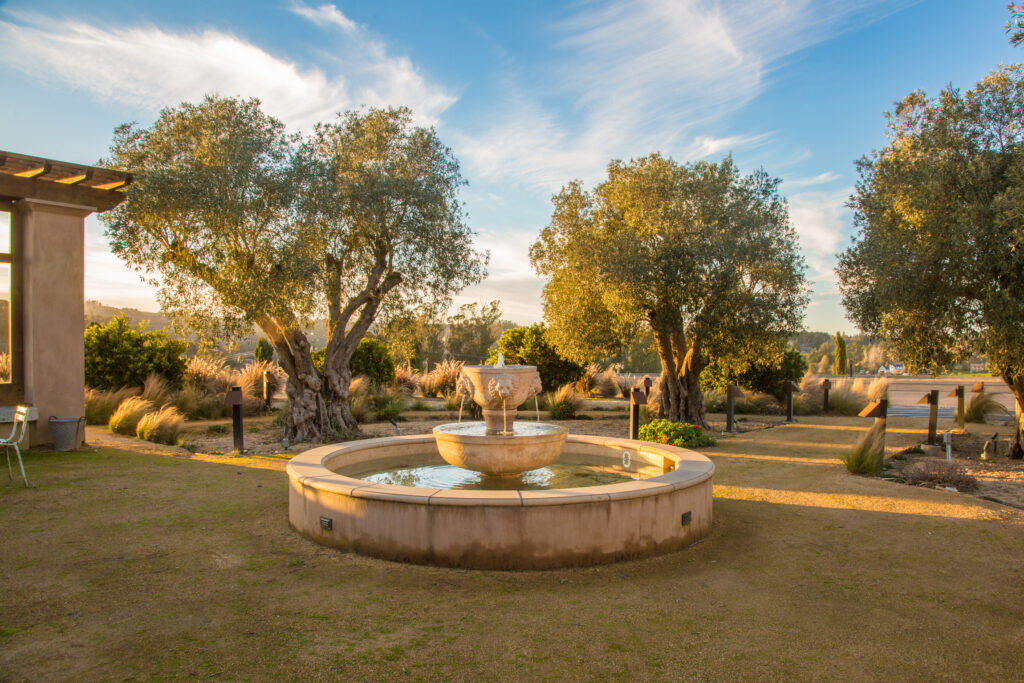
Spring’s Apple Blossoms
The buzz these days may be all about bud break in the vineyards—but long before there were grapes in Sonoma County, there were apples. So many apples. At Gold Ridge Organic Farms in the rolling hills of Sebastopol, apples still reign supreme. “The apple orchards in spring erupt in a sea of flowers, ushering in one of my favorite sensory spectacles of the year,” says owner and farmer Brooke Hazen. “I am undecided which is more beautiful: the cornucopia of flowers in spring or the apples themselves in summer.”
With more than 12,000 apple trees and about 75 heirloom varieties, blossoms emerge in every imaginable shade of pink, violet, and white, providing food for honeybees and native bumblebees. Hazen leads walks through the rows to celebrate the season; taste his love for the versatile fruit in farm-fresh products including apple cider syrup, apple cider vinegar, and apple cider balsamic vinegar. Mandarin kumquats, Meyer lemons, and 13,000 olive trees also grow on the property. The farm hosts a “Spring Is Blossoming” celebration Saturday April 27.
Gold Ridge Organic Farms. 3387 Canfield Rd., Sebastopol, 707-823-3110, goldridgeorganicfarms.com
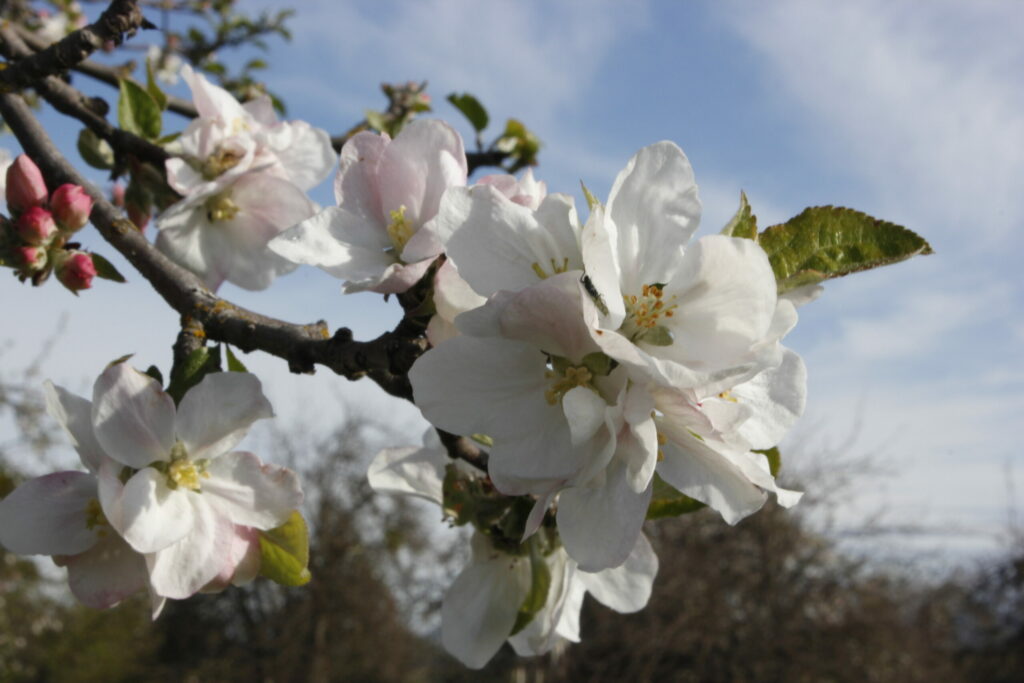
Outstanding Cooking Classes
“Our community is thinking about the sandwich bread and baguettes they want to make fresh for picnics, to say nothing of the artisan pizzas, hand-shaped Italian pastas, and glistening fresh fruit pies and tarts they get to share with loved ones as the weather improves,” says Lorenzo Alviso, program director at Artisan Baking Center in Petaluma. This spring at the center, James Beard award-winning pastry chef Nicole Plue is leading handson classes on puff pastry and spring tarts.
At The Epicurean Connection in Sonoma, enthusiastic students can learn how to pull mozzarella, churn butter, and create a wheel of ricotta in small classes with chef and cookbook author Sheana Davis.
And during the rare moments the kitchen is free, the magicians responsible for the lines out the door at Healdsburg bakery Quail & Condor make time to teach everything from making pasta to baking their legendary buttermilk drop biscuit with Parmesan and roasted onions. Sign up online; if a class is full, it never hurts to reach out.
Artisan Baking Center (at Keith Giusto Bakery Supply). 1120 Holm Rd., Petaluma. 707-765-5745, centralmilling.com
The Epicurean Connection. 19670 Eighth St. E., Sonoma, 707-235-9530, theepicureanconnection.com
Quail & Condor. 149 Healdsburg Ave., Healdsburg. 707-473-8254, quailandcondor.com

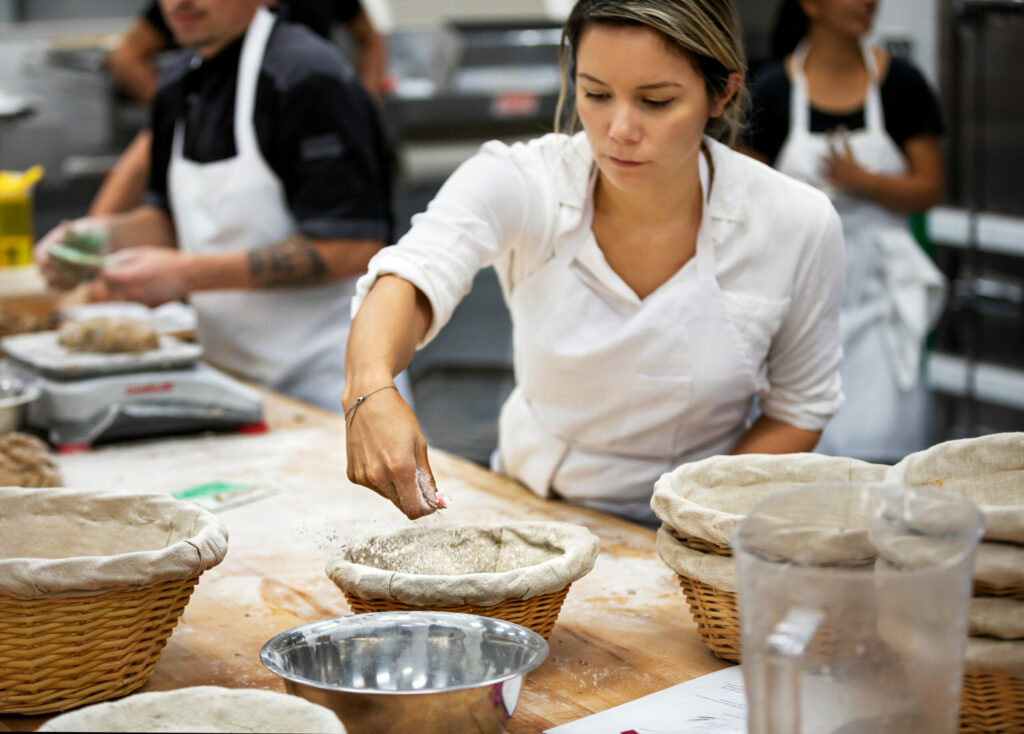
Forage in Mendocino
“I actually have the best job on this property of sharing the land with guests,” says Otis Brown, experienced forager and ranch hand at The Inn at Newport Ranch.
Located north of Fort Bragg, the 2,200-acre private ranch commands a mile and half of swoon-worthy oceanfront, expansive stretches of coastal pasture dotted with grazing cattle, and acres of old-growth redwoods.
Foraging is a way of life in Mendocino County, where the diversity of wild foods is astounding. On a spring foraging tour led by Brown, a chorus of crashing waves, cascading waterfalls, and gushing streams usher in a feeling of solitude. Guests can gather wild ginger, fiddlehead fern, waterleaf, miner’s lettuce, wild radish, and redwood sorrel—but there’s much more to the experience than simply filling your basket. Part of the joy of foraging is slowing down and letting the details of the landscape come into focus.
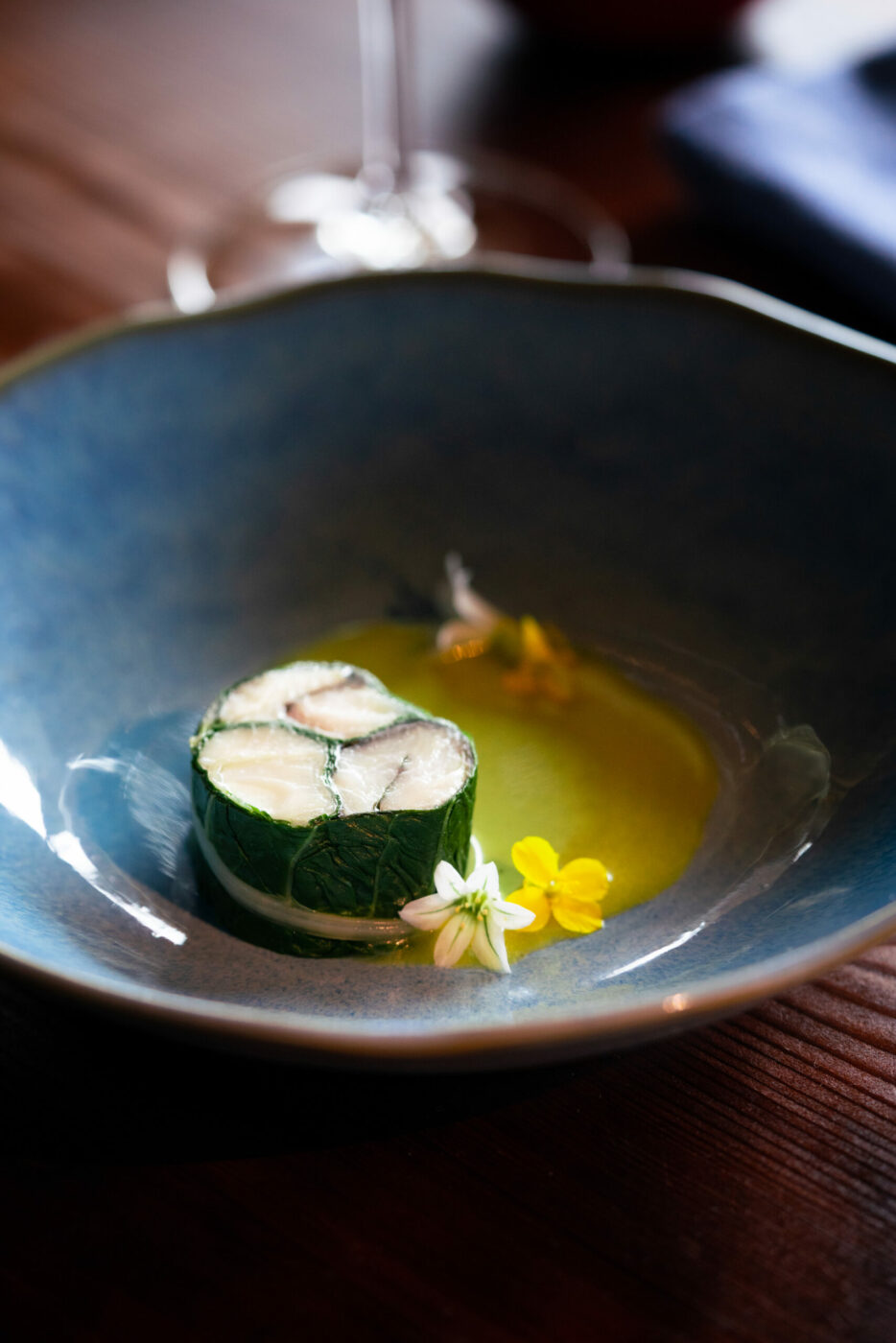
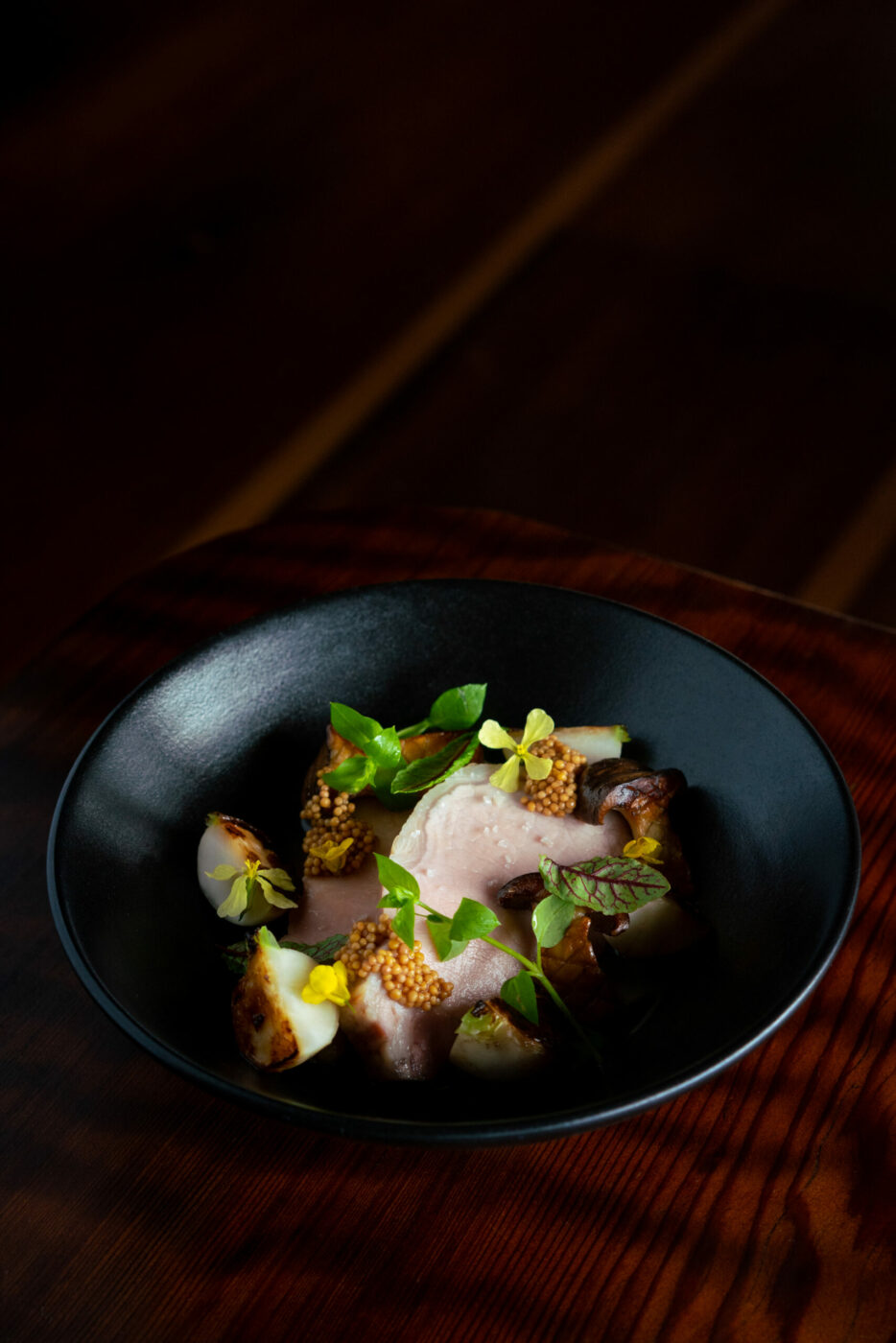
“I think there’s little bells and whistles that go off in our brain chemistry from foraging. There’s a satisfaction of ‘I’m going to pull this from the land and eat this.’”
The magic carries through to dinner, as executive chef Patrick Meany, formerly of Elk’s Michelin-starred Harbor House Inn, uses the ingredients you collected on your tour to create a multicourse meal: Think Humboldt Bay oysters with verjus ice and redwood sorrel, and grilled black cod in waterleaf butter sauce with porcini foam.
The bounty of the land also unleashes a feast for the eyes. “It’s such a unique property.
I find it magical,” says ranch manager Blair Foster. “There’s so many facets to explore. You have to love the outdoors, but if you have that inclination, it’s endless.”
The Inn at Newport Ranch. 31502 N. Hwy. 1, Fort Bragg. 707-962-4818, theinnatnewportranch.com
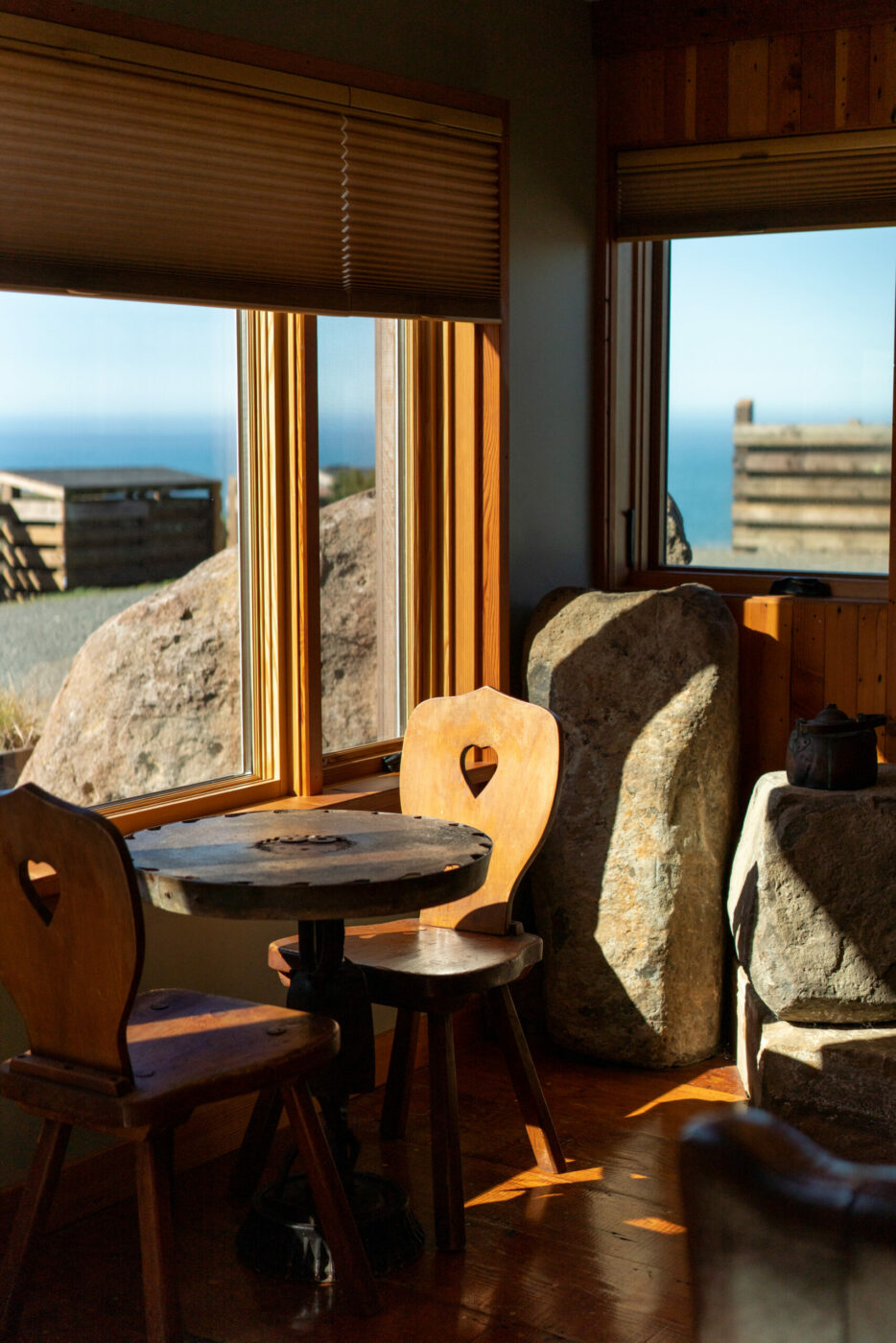
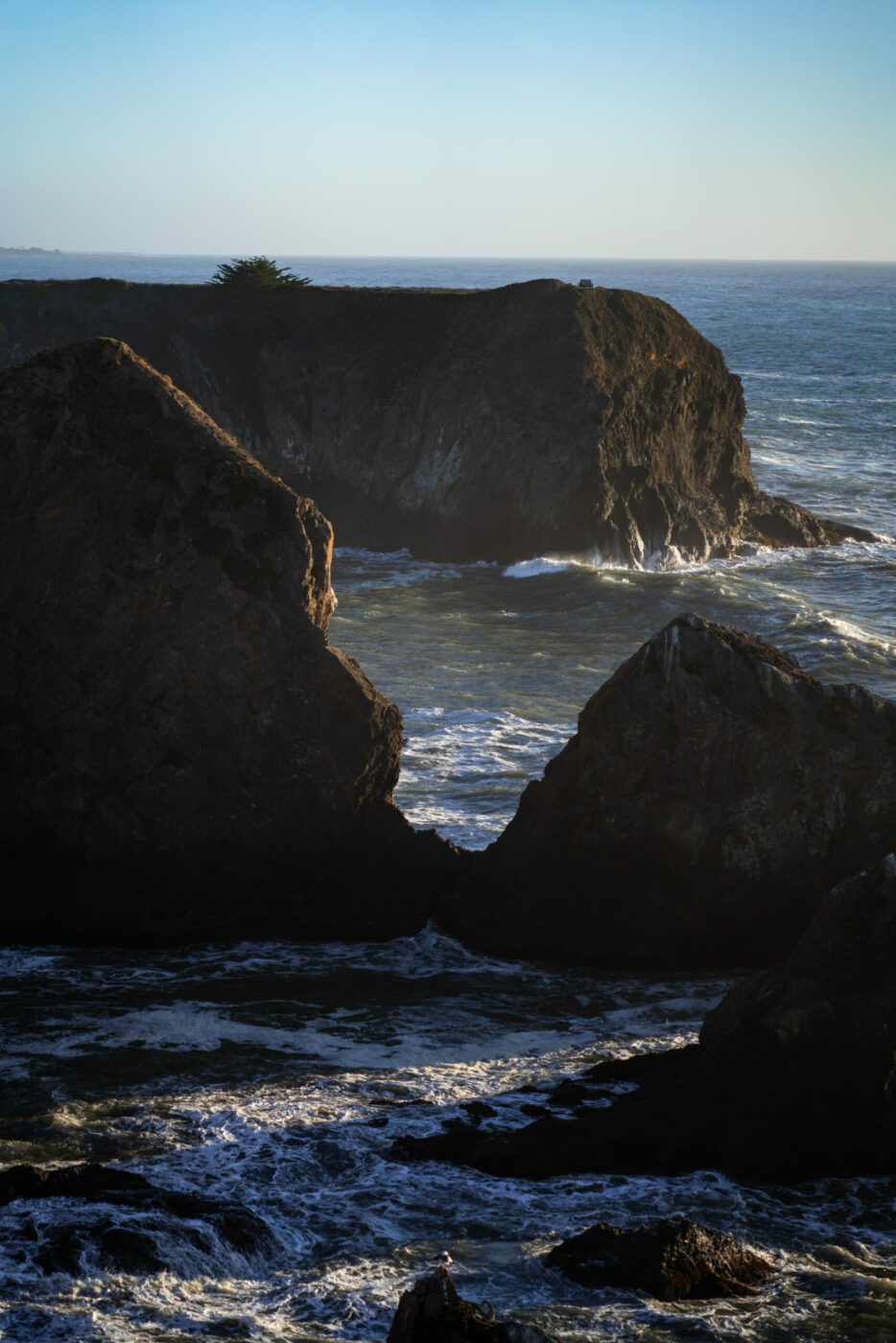
Taste Liquid Gold
Driving west from Petaluma toward the Pacific, rolling green hillsides sparkle and sightings of cows are everywhere. McEvoy Ranch, just a few miles outside town off Red Hill Road, is a place to be enveloped in nature and the bounty of locally grown products. Arriving at the ranch, a cheery sign along the winding driveway reminds you to take it slow. It’s good advice; the scenery here should be enjoyed.
There isn’t a bad day of the year to wander through the organic orchards at McEvoy Ranch; the silver-green foliage of 14,000 olive trees shimmer year-round. But with spring comes an explosion of delicate white blossoms that instill a sense of excitement for warmer days ahead. Rare dawn redwoods reawaken, dogwood and tulip trees remind why they’re worthy of adulation, and more than 3,000 tulips wrap the ranch’s Culinary Garden in a fragrant rainbow.

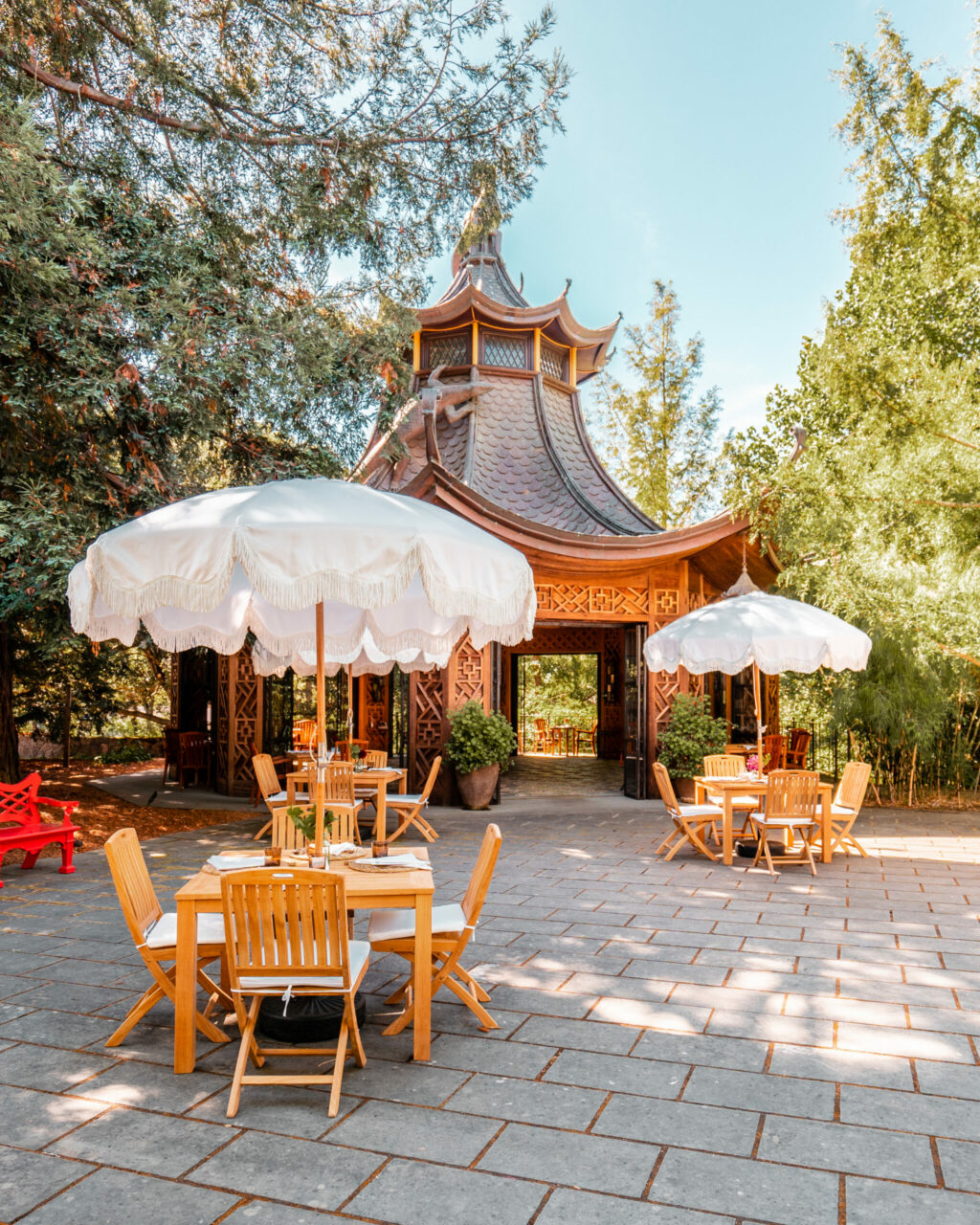
Ranch tours cover everything from the olive orchard to the mill, highlighting the diversity and history of this third-generation family-owned ranch. Afterward, settle into a seat on the patio—they all come with a view—for a tasting of the ranch’s specialty olive oils, including the gold-medal winning Ginger Turmeric flavor, served with Della Fattoria bread. Toast spring sunshine with a glass of McEvoy Ranch’s small-lot wine or say yes to dessert with a lemon tart topped with a drizzle of basil olive oil. Before you leave, stop into the sunshine-filled farm store for Mission fig balsamic vinegar, Sonoma wildflower honey, or the wonderful spicy green-olive tapenade.
McEvoy Ranch. 5935 Red Hill Rd., Petaluma. 707-769-4100, mcevoyranch.com
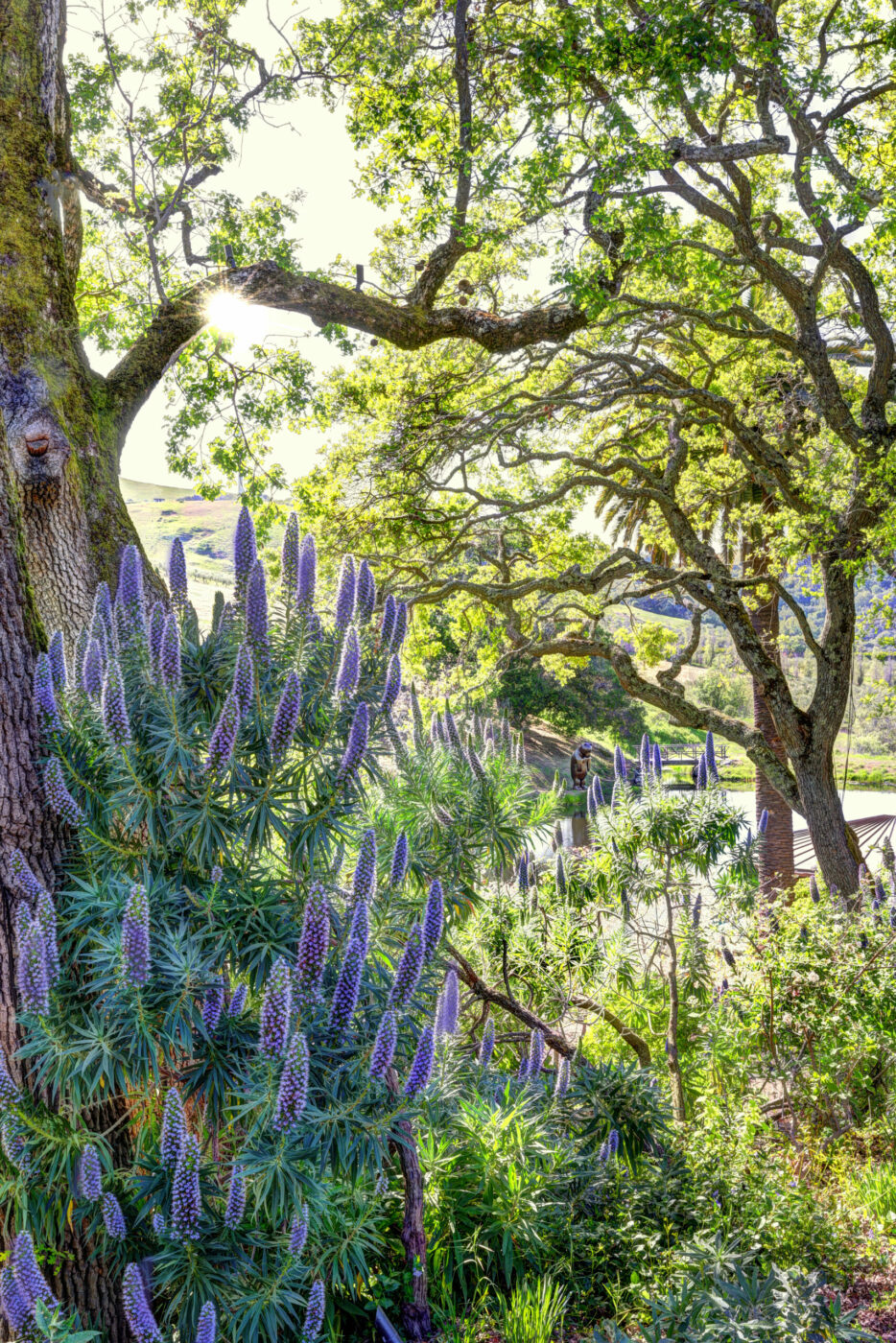
A Seafood-Filled Day in Bodega Bay
Hop from taste to taste as a breezy spring day unfolds along coastal Highway 1 in Bodega Bay. Get some steps in along the Bird Walk Coastal Access Trail at Doran Regional Park, then head to Ginochio’s Kitchen ( 1410 Bay Flat Rd.) for an order of Fish ’n Tacos. It’s hard to share—we know—but pacing is key. You want to bring your “A” game as you shuffle next door to Gourmet Au Bay for their famous smoked clam pizza ( 1412 Bay Flat Rd.).
From there, the dazzling vistas of Bodega Head are just a short drive away. It’s a bit late in the year to see migrating whales—but they have been known to blow off the calendar, so stay sharp as you wander the bluffs and beaches.
After the chill of the bluffs, warm your hands around a paper cup of steamy chowder from Spud Point Crab Co. (1910 Westshore Rd.). Afterward, for even more heat, try the grilled oysters with pickled jalapeño and shallots served next door at Fisherman’s Cove (1850 Bay Flat Rd.).
At the end of the day, the ride home will be even sweeter when you’re accompanied by a giant bag of saltwater taffy from Patrick’s of Bodega Bay (915 Hwy. 1). Try the peppermint taffy—its stripes echo the cheerful pink and white ones on the candy store’s exterior, a landmark along this stretch of the North Coast.
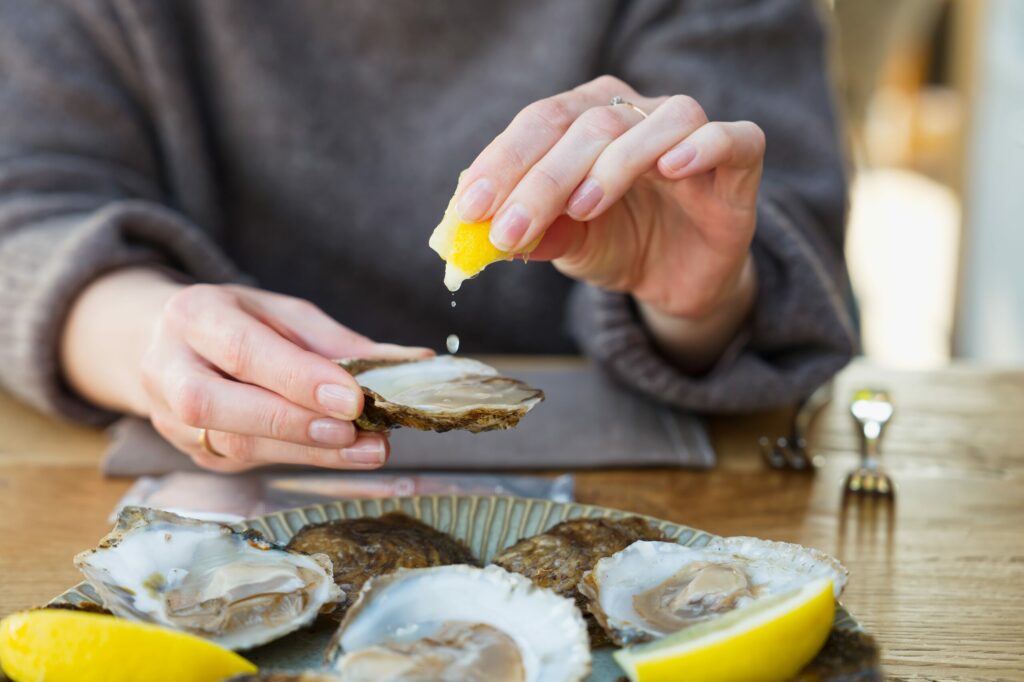
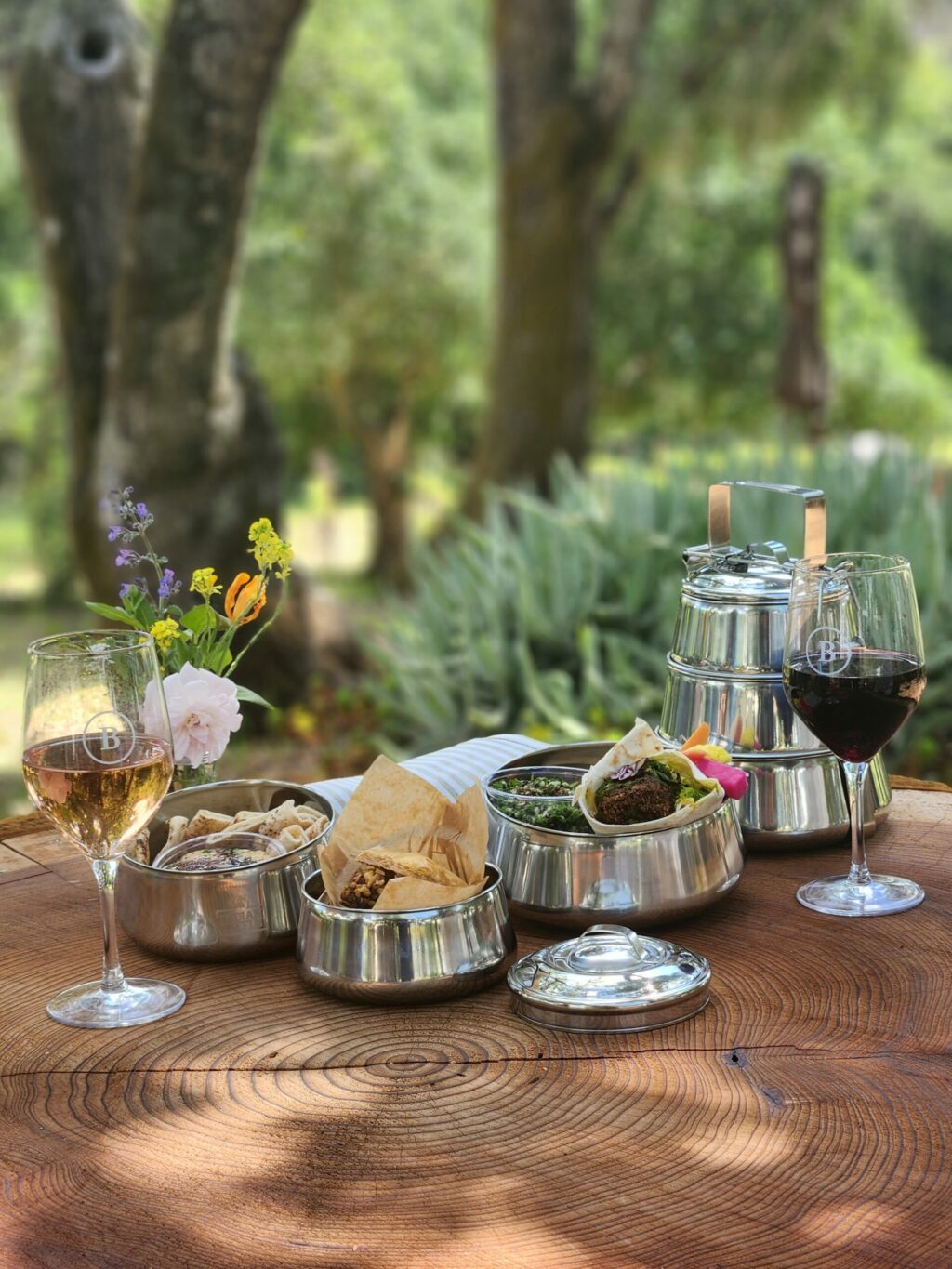
Wineries in Spring
Whether you want to shop for specialty vegetables or enjoy a full meal, these wineries offer both delicious sustenance and beautiful spring landscapes to explore.
Bartholomew Estate Vineyards and Winery
Hike, ride horses, or go forest bathing at the 375-acre vineyard-studded estate that’s considered one of the birthplaces of California viticulture. Enjoy Mediterranean deliciousness from Sonoma’s Spread Kitchen—think shawarma, falafel, tabbouleh, and more—alongside a two-glass flight of Bartholomew Estate wines.
1000 Vineyard Lane, Sonoma. 707-509-0540, bartholomewestate.com
Marimar Estate Vineyards and Winery
A taste of Spain in Sonoma County. Enjoy wine paired with Spanish tapas from owner Marimar Torres on the sunny winery patio surrounded by a rainbow of purple foxglove, daffodils, and Chinese peonies. Along with honey from estate hives, you can often purchase fresh chicken eggs, and quince paste fresh from Marimar’s kitchen.
11400 Graton Rd., Sebastopol. 707-823-4365, marimarestate.com
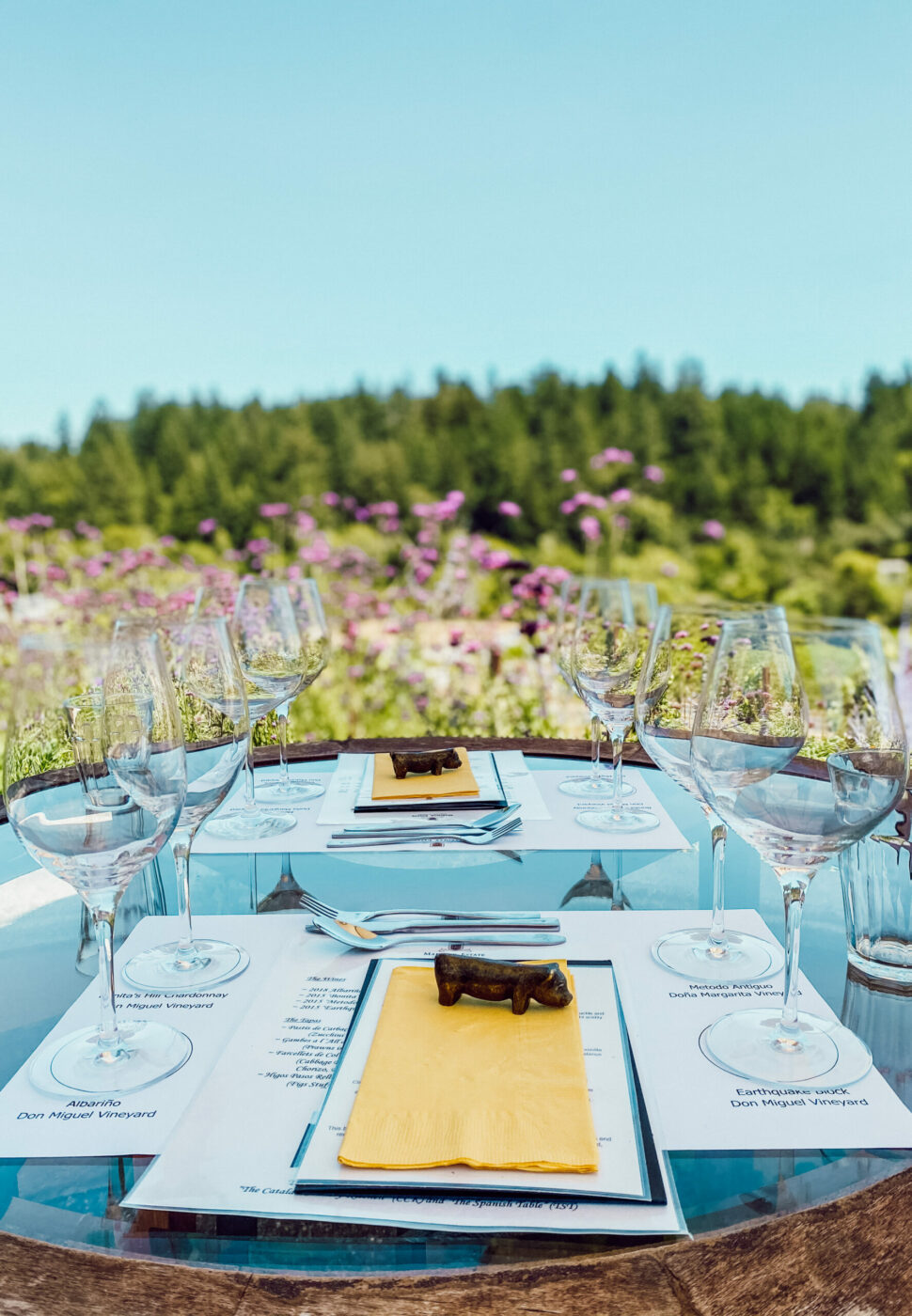
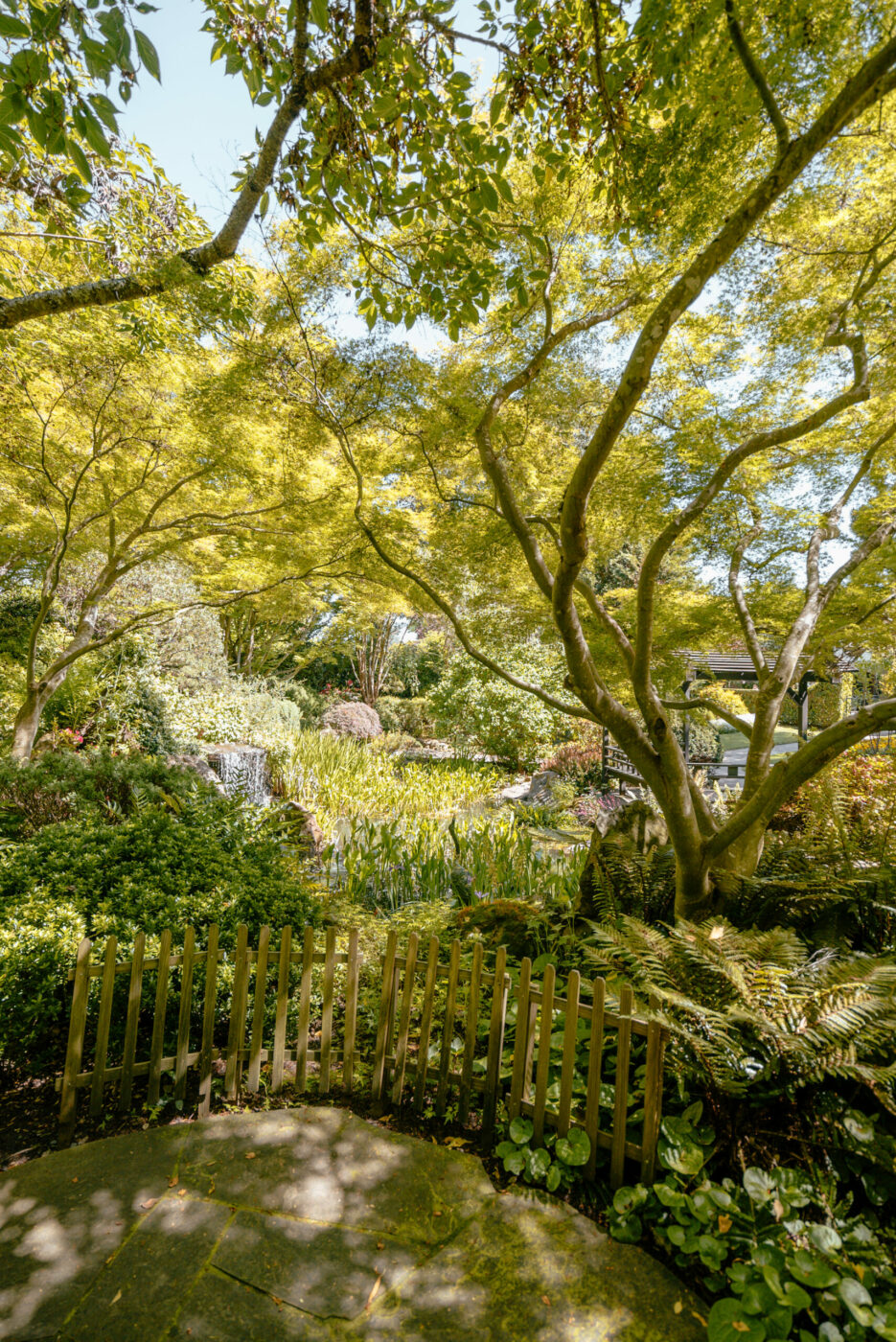
Belden Barns
Along with hillside vines and 1800s-era farm buildings, this family-run Sonoma Mountain winery also boasts a 3-acre farm. Much of the produce is sold to local restaurants, but you can scoop up delicious pantry items, including polenta, heirloom beans, and popcorn.
5561 Sonoma Mountain Rd., Santa Rosa. 415-577-8552, beldenbarns.com
Ferrari-Carano Vineyards and Winery
Call the hotline (707-433-5349) to find out when the famous tulips and daffodils will be in bloom, then tiptoe your way to a table in the winery’s Sycamore Grove for an outstanding Sunday brunch. Reserve in advance.
8761 Dry Creek Rd., Healdsburg. 800-831-0381, ferrari-carano.com
Cline Family Cellars
Take in more than a thousand roses, then nibble on a charcuterie board featuring seasonal fruit from the winery’s orchards. Adorable donkeys, too.
24737 Arnold Dr., Sonoma. 707-940-4044, clinecellars.com
The post 10 Spectacular Spring Getaways in Sonoma County appeared first on Sonoma Magazine.
]]>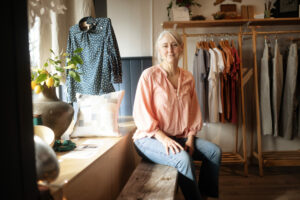
Theresa Hughes’s small Santa Rosa atelier is a throwback to an earlier time. Everything she makes is meant to be worn for years and years—the practical made beautiful.
The post Local Designer Creates Exquisite Clothes From Her Chic Santa Rosa Boutique and Studio appeared first on Sonoma Magazine.
]]>
















The name of designer Theresa Hughes’ clothing line, Saint November, clues guests into her simple, handmade ethos, in which every pattern has been drawn by hand and every stitch is carefully considered.
“I grew up in a Catholic family, and the saints were iconic. Those stories and images really stuck with me, the beauty of the physical space of the church,” she explains. And November? “I always feel like November is a little overlooked…. It’s really peaceful, and I love to be outside.”
“If there is anything that seems sacred, it’s that experience with the natural world, so I made my own saint. Saint November.”
Located in Santa Rosa’s artsy SoFA District neighborhood, down the block from Spinster Sisters restaurant and the Café Frida Gallery, Saint November is both a small clothing store and Hughes’ design studio, where locals can shop, meet the designer, and get a window into how her pieces were made.

(Erik Castro/for Sonoma Magazine)

Exquisite, small-batch clothing that lasts
Hughes creates exquisite, small-batch, utilitarian tops and bottoms, mostly for women but also for men. She seeks out earthy, natural colors like blue, brown, and taupe, and works primarily in hemp, linen, and cotton. Her unisex chore jacket, for example, comes in a jaunty railroad stripe and was inspired by vintage gleaning coats worn by farmers and working folk in Europe and the U.S. in the late 1800s.
“It’s oversize and rugged to withstand repetitive wear and washing,” she says. “I get a lot of inspiration from old workwear. I am really inspired by utility, things that are beautiful because of their function. There is beauty to be found in things that work well.”
Everything she makes is rough-hewn, artisanal, meant to be worn for years and years—the practical made beautiful. “I want my customers to feel they are buying something they can wear for many seasons, and that it is a worthwhile investment.”
The ‘Johanna’ shirt for women, for example, is made from Japanese cotton and has loose, three-quarter sleeves and a neck button opening that was inspired by a photo of a woman working the docks in 19th-century Ireland. Other pieces include rugged, striped work pants and a simple navy linen slip dress.
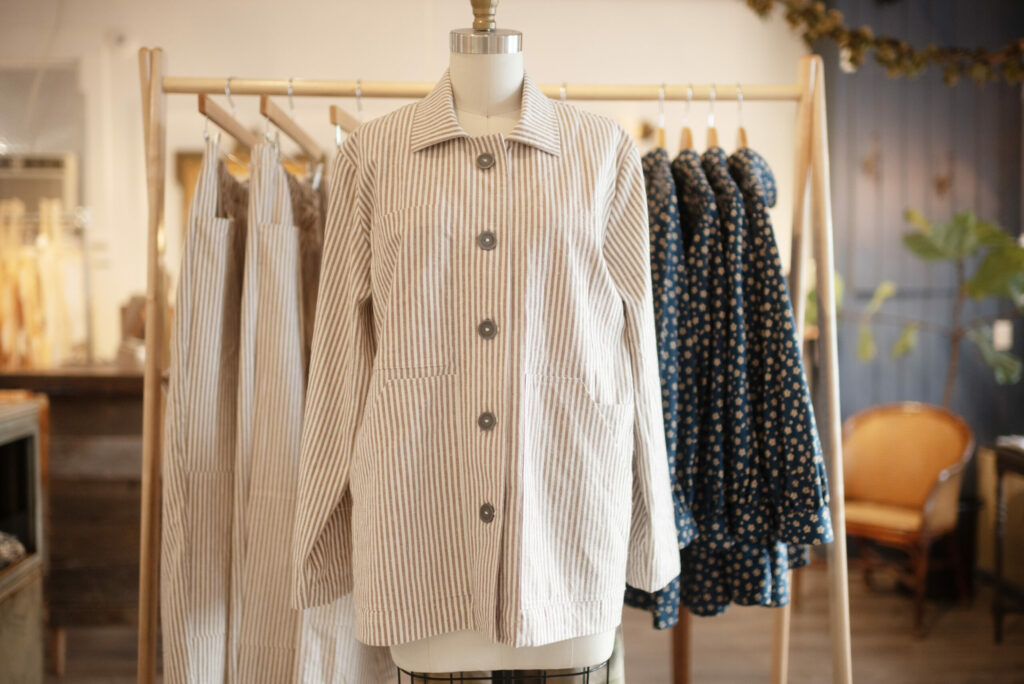

A throwback to an earlier time
Hughes’s small Santa Rosa atelier is a throwback to an earlier time—a place where the old and the analog are celebrated. She furnished the space with flea market finds and freebies, repurposing a table from home for a display of shirts and a metal doctor’s cabinet for jewelry from other local designers she admires. Branches cut from a tree in her backyard spill from a tall vase in the shop window, and beautiful trays and containers hold useful bits and bobs. Saint November jackets and tops for sale are hung on neat, Swedish-style wooden racks.
The back half of the space is her creative zone, where she cuts out pieces on a wide worktable and sews on a vintage Japanese industrial sewing machine. The wall is lined with bolts of fabric sourced from Japan and India. Cardboard patterns and white muslin sample pieces hang on a handcrafted metal pole, and scissors stand at the ready on a magnetic rack more commonly used for chef’s knives. All in all, the effect is part studio, part chic boutique, with a beautifully rendered but down-to-earth feel.


From large brands to custom projects
A native of Ohio, Hughes had a rural upbringing, all family farms and split rail fences. As a child, she dug clay to make dolls, fashioning tiny outfits out of paper towels. She learned to sew in her early 20s while studying fashion design and pattern making in San Francisco.
After graduation, she spent the next 15 years working as a professional pattern maker for large manufacturers in the Bay Area—“mall brands,” as she puts it, like CP Shades as well as smaller lines like Bryn Walker. She even did a short stint as the pattern maker for a line of underwear from motorcycle maker Harley-Davidson.
When the patternmaking work started to slow due to factory closures and a rising tech industry, Hughes freelanced, then got involved in custom sewing projects, at first primarily for brides. But a writer friend suggested that she explore clothing projects that would be worn more than once—a suggestion which echoed Hughes’ own beliefs about durability and timelessness. She branched out, creating Saint November.
As business grew, she found that online sales gave life to her old-fashioned creations and allowed her to connect with the type of customer who identifies with her small-batch ethos, which she admits can be “pretty niche.” “In a way, the internet is an equalizer. You can be seen. It allows me to have a voice.” Others find her through her SoFA District storefront. Or they recognize her work from when she used to sell at Bay Area pop-ups and craft shows.
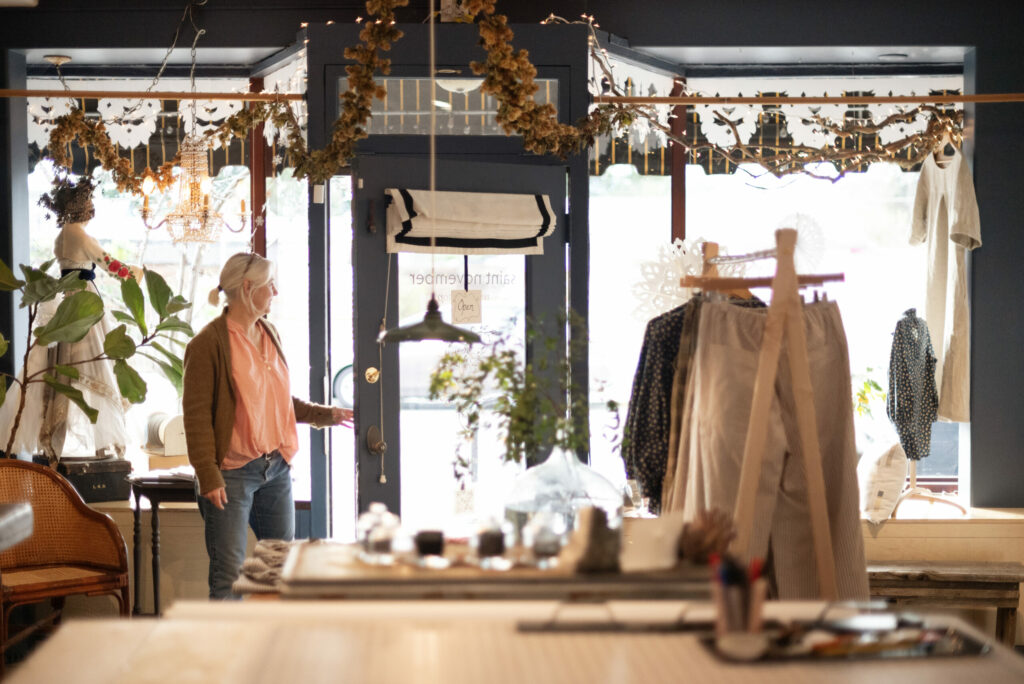
Inspired by classic, humble workwear
There are advantages to staying small and keeping that personal touch. Recently, a man came in asking for a chore coat, but the ones she had in stock had arms that were too short. “I told him to go down the street and get a cup of coffee, and I’d lengthen the sleeves.”
Hughes revels in the unique, the small, and the handmade, showcasing not only her own designs, but also jewelry and crafts from other local designers. And she is beginning to offer some specialty design and sewing classes. Fans can check for details on those on her website later this spring.
Meanwhile, she’ll continue to be inspired by the classic, humble workwear of days gone by. “Don’t you want to hear about how inspired I am by Levi’s 501s? They’ve become a cultural icon, and they’re still selling after a hundred years… It was a functional thing. A whole culture was built around it.”
“That is a lot of value to give to a simple garment. I draw a lot of inspiration from that.”
Saint November. 320 South A St., Santa Rosa. saintnovember.net
The post Local Designer Creates Exquisite Clothes From Her Chic Santa Rosa Boutique and Studio appeared first on Sonoma Magazine.
]]>
Jack Sporer manages a custom crush operation that has become an incubator for up-and-coming natural winemakers and a hub for low-intervention seasoned traditionalists.
The post This Rising Star Sonoma Winemaker Is Bringing the Natural Wine Community Together appeared first on Sonoma Magazine.
]]>
















Walking through a row of organically farmed Sauvignon Blanc grapes on Denmark Street just outside the town of Sonoma, winemaker Jack Sporer pauses to study the barren earth beneath the vines.
“You can see how three to four years out, the Roundup strip still exists,” he says, kneeling down to get a closer look, as if eyeing an old scar. Between rows, a lush cover crop thrives, but little sprouts beneath the dormant vines. “You can see how long the impact of herbicide lasts.”
No matter where Sporer’s mind goes, jumping between conversations about macrobiotics, tiny bits floating around in bottles, and all things low-intervention winemaking, things usually circle back to regenerative farming in Sonoma Valley. It’s the reason Sporer, who makes the well-regarded Fres.Co lineup of natural wines, spotlights the winegrower’s name on the back of every bottle.
“The idea is to take the focus off of me and put the focus on the people who are impacting the wine the most, which is the grower,” he says. “It’s the most cliché thing, but the most true thing—wine is made in the vineyard, especially natural wine.”
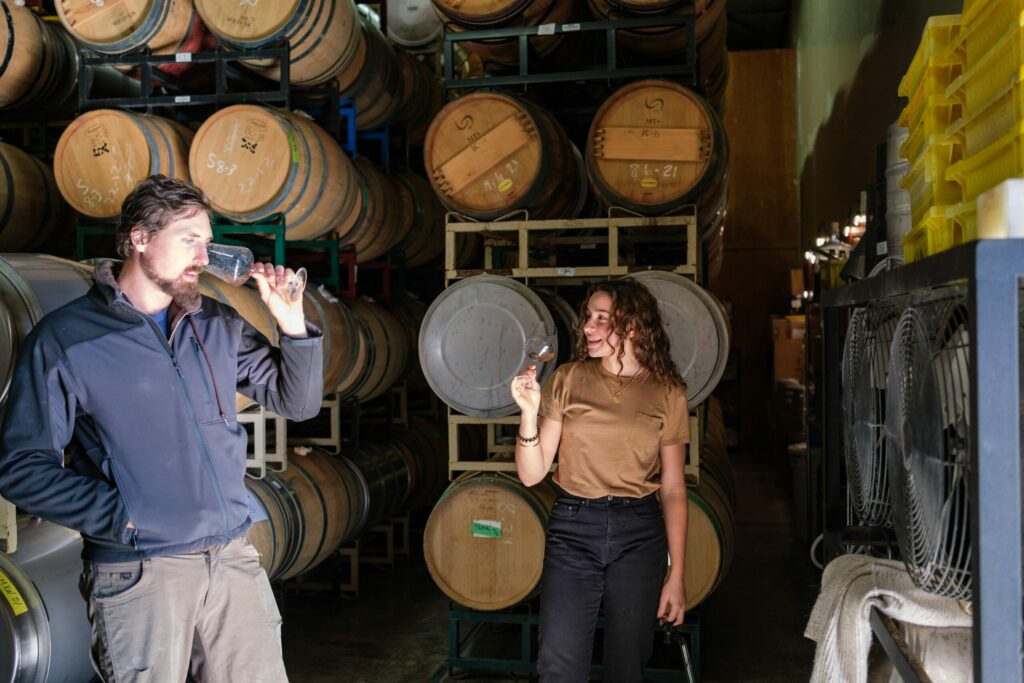
An incubator for up-and-coming winemakers
The custom crush operation Sporer manages, Magnolia Wine Services on Eighth Street East in Sonoma, has become an incubator for up-and-coming natural winemakers and a hub for low-intervention seasoned traditionalists.
It’s “a mixing ground and a proving ground—all in one,” Sporer explains. His clients include several big names in biodynamic and regenerative farming in the valley, including Phil Coturri. On this morning, David Rothschild, who sells Chardonnay grapes to Sporer and makes his own wine under the Las Vivas label, is loading up tanks of olive oil. A little later, clients Lauren Cadwallader and Crista Coccia of Dos Piedras make a pit stop to see how their Sauvignon Blanc and Zinfandel rosé are coming along in barrel.
With his three-legged rescue dog, Canela, in tow, Sporer moves from barrel to barrel, thieving tastes of a fresh ’23 Merlot and a ’22 Merlot from Bedrock Vineyard that he picked right before the big heatwave that September, before sampling the juice of a 2023 Loureiro from Lost Slough Vineyard near Lodi. It’s a varietal typically used to make Vinho Verde, but he’ll conjure an orange wine out of it, to be distributed in kegs and sold by the glass.
A board on the wall nearby is marked with tallies or “beer fines” for those who screw up on the job (i.e. accidentally opening a valve or dropping a glass). It’s all in jest, but fines must be paid, for the fridge must always be stocked with beer. On Fridays, Sporer often throws communal lunches, sometimes with blind tastings. Right now, the biggest issue is a shortage of space for barrels. With 24 clients, Magnolia was scheduled to bring in 200 tons last year—but after an unexpectedly large harvest, the team ended up working with more than 250 tons.
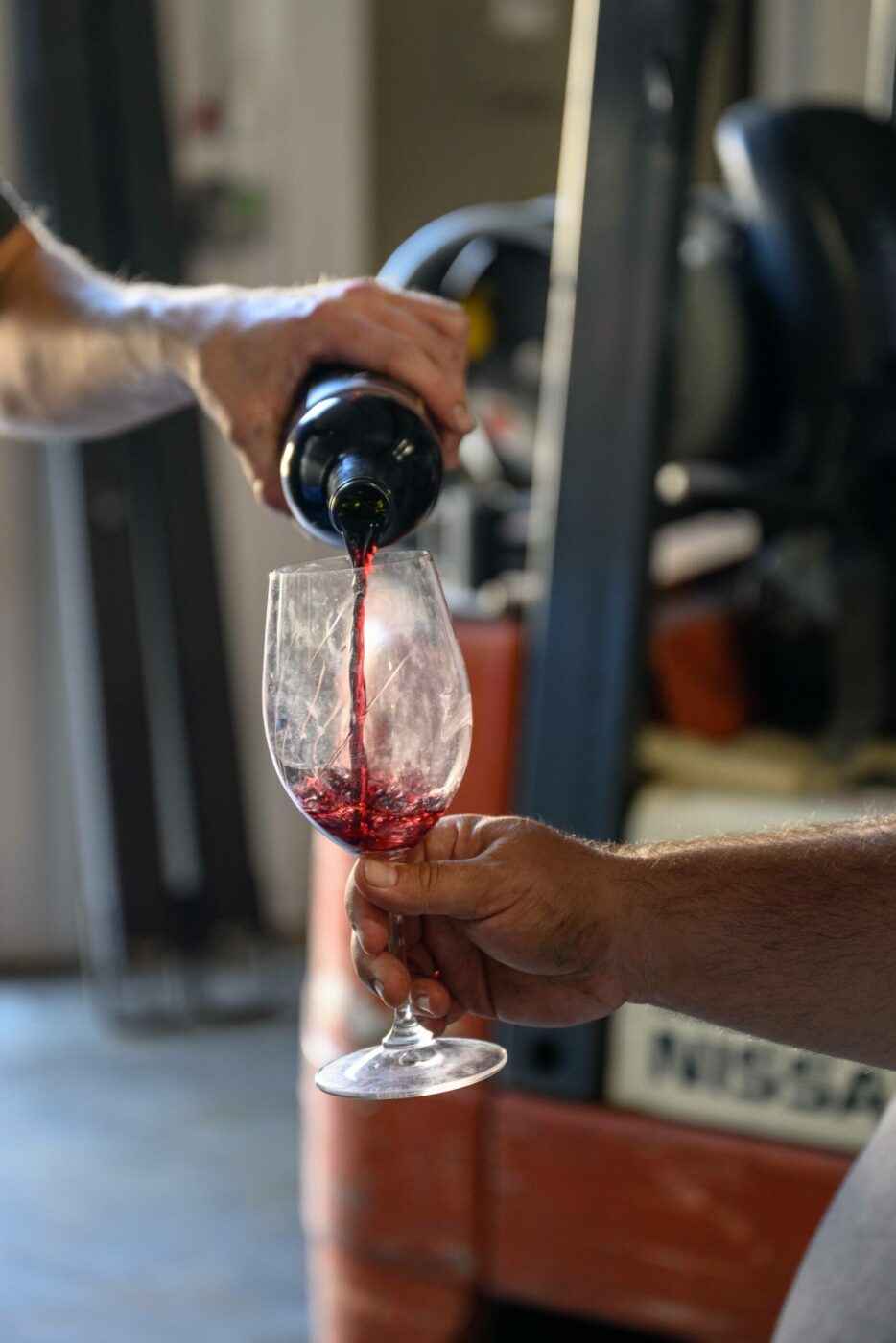
A growing natural wine brand
Every time Sporer walks into the barrel room, he passes under an abandoned farmstand sign mounted on the wall that reads “Strawberries Picked Fresh” in large, hand-stenciled letters. It’s the inspiration for his growing brand, Fres.Co (originally christened “Fresh Wine Company” before being abbreviated) and for the design of several of his wine labels.
If Magnolia is Sporer’s bread and butter, Fres.Co is his passion. “The original idea was ‘fresh wine’—to take wine and think about it the way you think about food or veggies or produce,” he says. “I’m not going to make a claim that natural wine is healthier for anyone, but I do think that having macrobiotic life still existing in the bottle and not snuffing that out—to me, it’s more interesting and more dynamic,” he says, drawing parallels to raw cheese, kombucha, and probiotic foods.
When he talks about natural wine, he often follows it up with “whatever that means,” making it clear he’s not “a zero-zero zealot.” He’s not averse to adding small amounts of sulfur, for example, to avoid vinegary flavors brought on by high volatile acidity.
“I’m not super-fussed with labels,” he says. “The wines are all unfiltered, with low sulfur, organic yeast, and organic grapes. It’s that simple.”
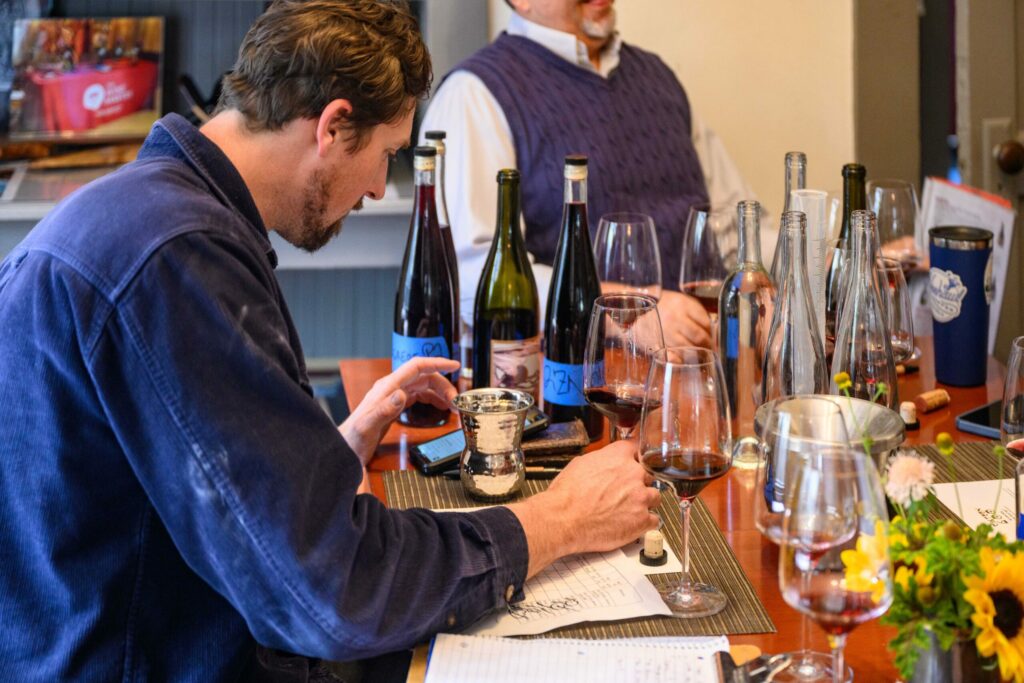
Deep Sonoma roots
Sporer grew up mainly in San Francisco’s Sunset District, where he learned Mandarin and Cantonese at a Chinese immersion school, but he always knew he had farming in his blood. His grandmother, Anne Teller, put Sonoma Valley produce on the map in the 1970s at Glen Ellen’s Oak Hill Farm. His mother is still a part owner of Oak Hill, which is now run by Jack’s cousins. And his uncle, winemaker Will Bucklin, dry-farms sought-after field blends at neighboring Bucklin Old Hill Ranch.
At the age of 12, after a long day helping bottle his uncle’s wines, Sporer swore he would never go into the wine business. Instead, he fled to the East Coast, majoring in biology at Providence College in Rhode Island. But after spending a summer tagging rodents as part of a field study in Montana, he found himself back in Sonoma Valley for the 2012 harvest.
Connecting with the blend of manual labor and scientific method, he set out to work harvests around the world—in Australia, New Zealand, France, and Chile, before returning home to jobs at Chappellet and Williams Selyem.
But what really shaped his philosophy on regenerative agriculture was the viticulture program at Santa Rosa Junior College, where he loved getting his hands dirty at Shone Farm. That’s where he dove deeper into biodynamics, and also where he met fiancée Saskia Tingey, a viticulturist at Hamel Family Wines. Their upcoming April wedding at Oak Hill Farm will be officiated by the teacher of their SRJC organic viticulture class.
“I’m lucky to have someone to talk about all these ideas with,” he says.
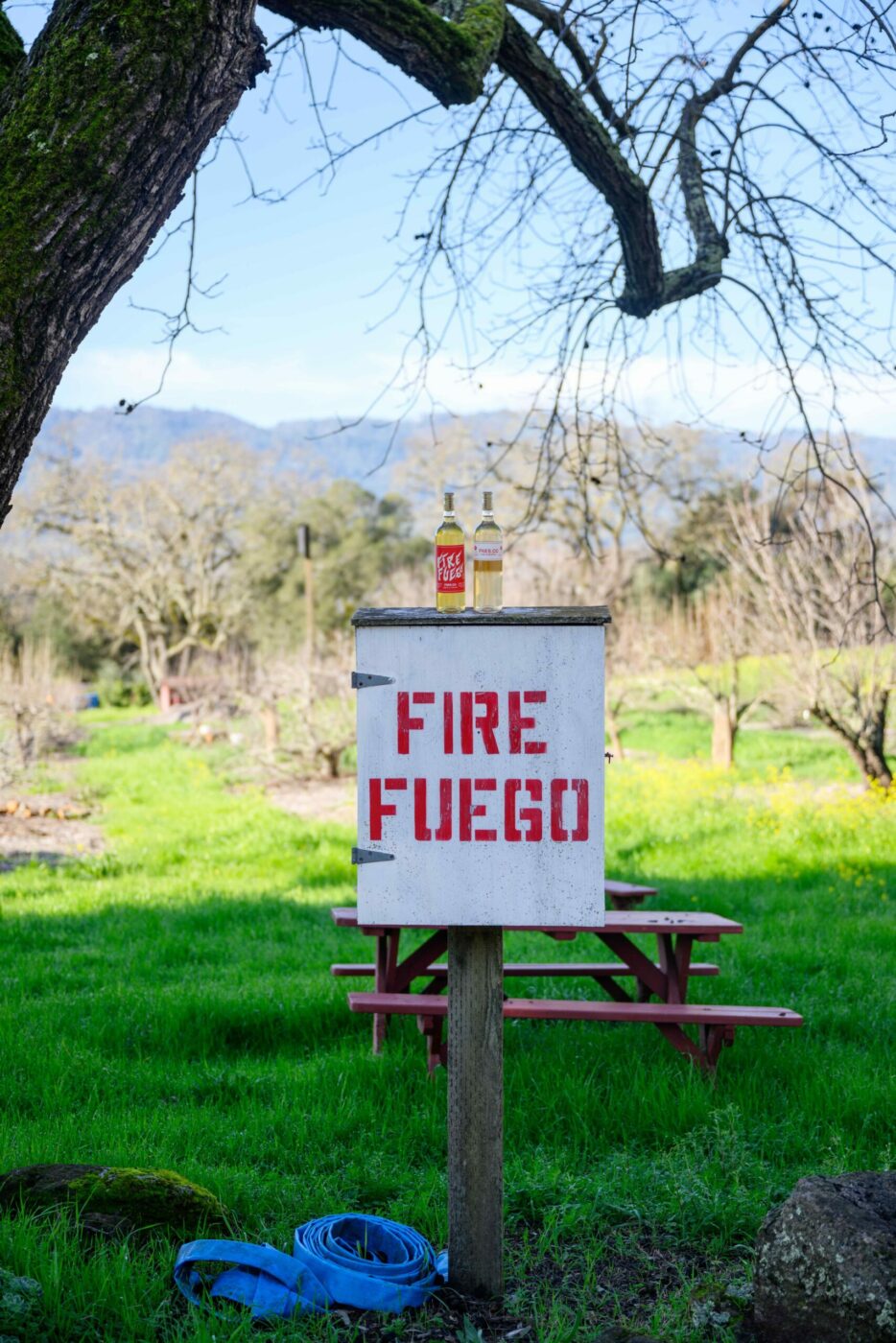
Staying calm during the crush
Beyond his passion for making natty wines and his dream of converting every farm in Sonoma Valley to organic, Sporer’s greatest attribute might be staying calm during the madness that comes with crush every year.
“If I had to deal with the (stuff) he has to deal with during harvest, I’d blow every gasket,” says Rothschild. “But he’s always so level-headed during harvest, which I’m always amazed at when you consider he’s dealing with, like, 15 feral children all at once.”
The key for Sporer is to be “relaxed but dialed-in at the same time,” he says, which can be hard when a Chardonnay gets stuck in fermentation or it feels like every client’s fruit is ready to come off the vine at the same time.
“If you’re doing it right, the most important decisions have already been made long before harvest,” he says. “It all comes back to the grapes. The grapes have to be perfect.”
Fres.Co wines and Magnolia Wine Services, 21481 Eighth St. E., Sonoma. fresh.wine
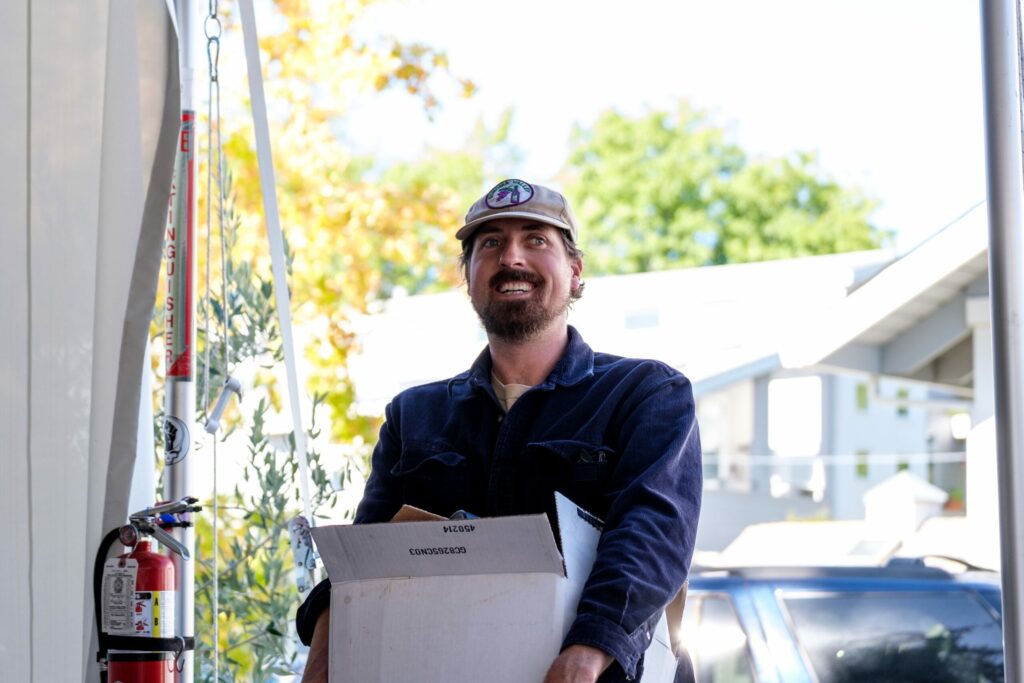
Jack Sporer’s Sonoma
Best Hike: “The Bartholomew Park loop—it’s privately owned property with public access, with a beautiful redwoods section and a place with exposed rocks where you can see the rocks that form the soil. It’s the perfect 45-minute hike you can do at the end of a workday with your dog.” 1695 Castle Rd, Sonoma. bartholomewpark.org
Favorite Restaurant: “It’s gotta be Valley Bar + Bottle. They were the first place I ever sold wine to. The XO eggs are always worth getting, and the crispy rice scallions. The roasted chicken is amazing. They have a nice mix of local and foreign wines. It’s very unpretentious. It feels like you’re having dinner in your living room with friends.” 487 First St. W., Sonoma. valleybarandbottle.com
Outstanding Farmstand: “I’d be remiss if I didn’t mention the Red Barn Store at Oak Hill Farm. It’s run by my cousins Jimi Good and Melissa Bucklin. In the spring, they’ll have tons of veggies—they grow an amazing Romanesco broccoli, which is my favorite vegetable. And they have really great potatoes.” 15101 Sonoma Highway, Glen Ellen. oakhillfarm.net
Favorite Tasting Room: “The Winery Sixteen 600 tasting house is a lot of fun. And it literally was once a house, so it’s like you’re tasting in your living room. And they have cool vinyl. Those guys put on a really good party.” 589 First St. W., Sonoma. winerysixteen600.com
Top Bakery: “Baker & Cook has really elevated food, and the owners Jen and Nick are old-school Sonomans. Their savory gallettes—little hand pies—are amazing. I’m a chocolate croissant guy, and they have the best. You gotta go there.” 18812 Hwy. 12, Sonoma. bakerandcooksonoma.com
The post This Rising Star Sonoma Winemaker Is Bringing the Natural Wine Community Together appeared first on Sonoma Magazine.
]]>